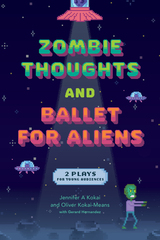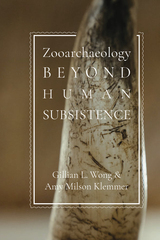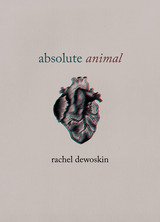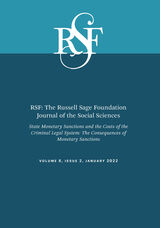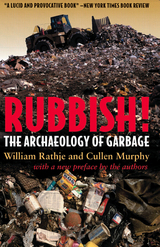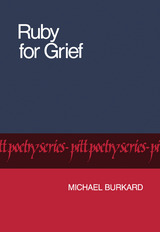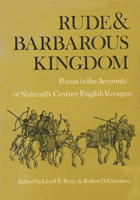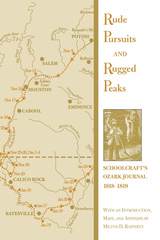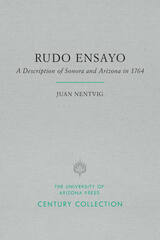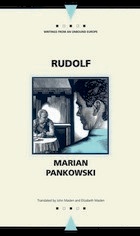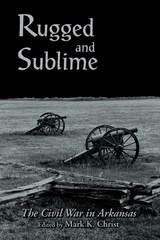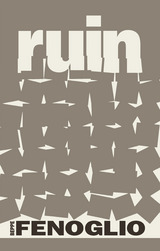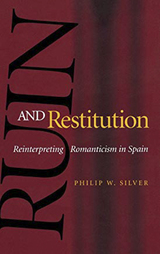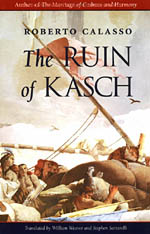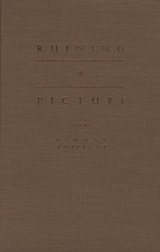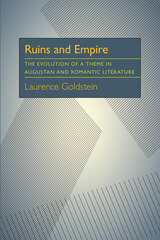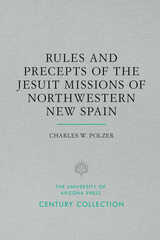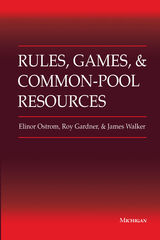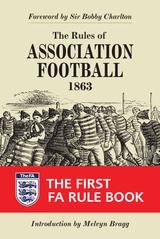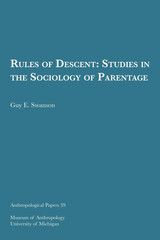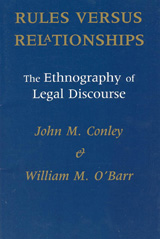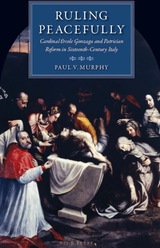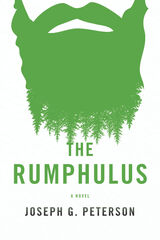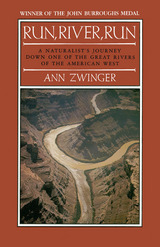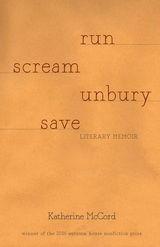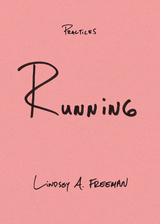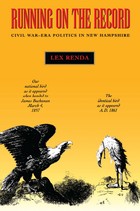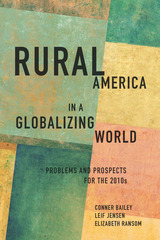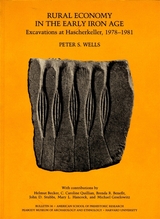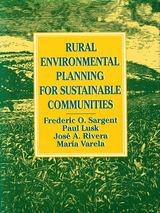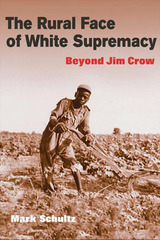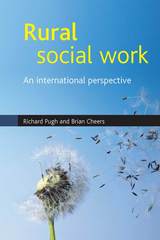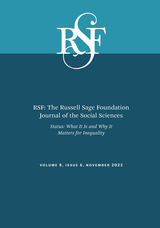 RSF: The Russell Sage Foundation Journal of the Social Sciences: Status: What Is It and Why It Matters for Inequality
Cecilia L. Ridgeway
Russell Sage Foundation, 2022 Note the copy pertains to two issues of RSF: Status – a form of inequality based on esteem, respect, and honor – affects how people are treated in all aspects of their lives, including in schools, workplaces, politics, and even the family. It shapes people’s access to valued outcomes in life, such as income, education, and health. However, status is poorly understood and its significance in the construction of inequality is often underestimated. In this special double issue of RSF, sociologist Cecilia L. Ridgeway, social psychologist Hazel Rose Markus, and an interdisciplinary group of contributors examine how status functions in society and its role in inequality.
Issue 1 demonstrates that status is fundamental to inequality and shows that it is different from other forms of inequality. Tali Mendelberg presents a theory of how status functions in politics and differentiates the potent symbolic value of achieving greater esteem from status-seeking as a means to obtain resources, such as income, assets, or property. Biko Koeing finds that Trump voters were motivated not only by a perceived loss of status, but by the belief that this loss was unjust. Fabien Accominotti and colleagues assess the characteristics of status hierarchies and find that those with greater clarity, rigidity, and order have greater inequality between high and low status members.
Issue 2 examines how status is created and reinforced through cultural norms and in our relationships with one another. Hilary Holbrow finds that the gender pay gap is nearly three times greater in companies where low-status support roles are held primarily by females. Natasha Quadlin finds that college graduates who are perceived to be wealthy are also perceived to be more intelligent than they would be if they were perceived to be members of a lower socioeconomic group. Annette Lareau finds that married women often behave in ways – such as disengagement from financial matters or downplaying their own financial knowledge – that sustain their husband’s status as economic expert of the family. Bianca Manago and colleagues find that prior contact and group interaction between Whites, Blacks, and Mexican Americans decreases Whites’ anxiety about working with Blacks and Mexican Americans, but does not increase Whites’ perceptions of Blacks’ and Mexican Americans’ competence. Status interventions during interaction, however, do increase Whites’ perceptions of Mexican Americans’ competence and their influence in the group. Lehn Benjamin finds that staff at nonprofit organizations who share control and establish common ground with their clients reduce status hierarchies between staff and clients.
This volume of RSF sheds light on status as a powerful social force which pervades our lives, and demonstrates its role in creating and preserving inequality.
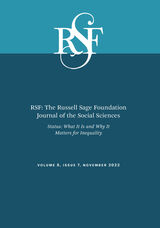 RSF: The Russell Sage Foundation Journal of the Social Sciences: Status: What It Is and Why It Matters for Inequality
Cecilia L. Ridgeway
Russell Sage Foundation, 2002 Note the copy pertains to two issues of RSF: Status – a form of inequality based on esteem, respect, and honor – affects how people are treated in all aspects of their lives, including in schools, workplaces, politics, and even the family. It shapes people’s access to valued outcomes in life, such as income, education, and health. However, status is poorly understood and its significance in the construction of inequality is often underestimated. In this special double issue of RSF, sociologist Cecilia L. Ridgeway, social psychologist Hazel Rose Markus, and an interdisciplinary group of contributors examine how status functions in society and its role in inequality.
Issue 1 demonstrates that status is fundamental to inequality and shows that it is different from other forms of inequality. Tali Mendelberg presents a theory of how status functions in politics and differentiates the potent symbolic value of achieving greater esteem from status-seeking as a means to obtain resources, such as income, assets, or property. Biko Koeing finds that Trump voters were motivated not only by a perceived loss of status, but by the belief that this loss was unjust. Fabien Accominotti and colleagues assess the characteristics of status hierarchies and find that those with greater clarity, rigidity, and order have greater inequality between high and low status members.
Issue 2 examines how status is created and reinforced through cultural norms and in our relationships with one another. Hilary Holbrow finds that the gender pay gap is nearly three times greater in companies where low-status support roles are held primarily by females. Natasha Quadlin finds that college graduates who are perceived to be wealthy are also perceived to be more intelligent than they would be if they were perceived to be members of a lower socioeconomic group. Annette Lareau finds that married women often behave in ways – such as disengagement from financial matters or downplaying their own financial knowledge – that sustain their husband’s status as economic expert of the family. Bianca Manago and colleagues find that prior contact and group interaction between Whites, Blacks, and Mexican Americans decreases Whites’ anxiety about working with Blacks and Mexican Americans, but does not increase Whites’ perceptions of Blacks’ and Mexican Americans’ competence. Status interventions during interaction, however, do increase Whites’ perceptions of Mexican Americans’ competence and their influence in the group. Lehn Benjamin finds that staff at nonprofit organizations who share control and establish common ground with their clients reduce status hierarchies between staff and clients.
This volume of RSF sheds light on status as a powerful social force which pervades our lives, and demonstrates its role in creating and preserving inequality.
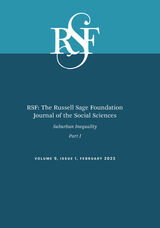 RSF: The Russell Sage Foundation Journal of the Social Sciences: Suburban Inequality
L'Heureux Lewis-McCoy
Russell Sage Foundation, 2023 Note this copy pertains to two issues. This is a double issue.
Suburbs are home to almost half of all Americans and have undergone dramatic demographic shifts over the past 20 years. Yet, suburbs remain understudied, and we know little about the changes taking place in these communities. In this special double issue of RSF, sociologists R. L’Heureux Lewis-McCoy, Natasha Warikoo, Stephen A. Matthews, education scholar Nadirah Farah Foley, and an interdisciplinary group of contributors examine how suburbs have evolved and growing suburban inequality.
Issue 1 looks at the diversification of suburbs as well as inequality in suburban housing. Daniel T. Litcher and colleagues find that a majority of residents living in metropolitan areas now live in suburbs and this change has been driven by a migration of ethnic and racial minorities to suburban areas. Devin Q. Rutan and colleagues reveal that the number of suburban evictions has steadily risen over time, even as urban evictions have remained stable. Jennifer Girouard finds that while the state of Massachusetts passed Chapter 40B in 1969, a law that ensures affordable housing is built in the suburbs, local residents and leaders use tactics such as creating narratives of the town being victimized by predatory developers to resist the law and the development of affordable housing.
Issue 2 examines suburban schools, how community institutions function in suburban areas, and suburban politics. Shruti Bathia and colleagues find that between 2000 and 2015 Latino children attending elementary school in the suburbs had more exposure to White peers than their counterparts attending urban schools. However, suburban Latino children’s exposure to White students declined during that same time period. Scott W. Allard and Elizabeth Pelletier reveal that the nonprofit safety net is less responsive in suburban areas than urban centers and that nonprofit services are less robust in high poverty suburban areas and suburban areas with larger Black populations. Brenden Beck shows that suburbs with large Black populations rely the most on fine-and-fee revenue and that municipalities that rely more on monetary sanctions have more police killings. Kiara Wyndham Douds finds that incorporated suburbs are Whiter and less racially diverse than unincorporated suburbs, suggesting that incorporation has been an effective strategy for racial exclusion.
This volume of RSF investigates the underexamined and pressing issue of inequality in suburbs and explores how it develops within and between suburban communities.
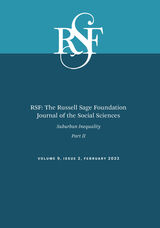 RSF: The Russell Sage Foundation Journal of the Social Sciences: Suburban Inequality
L'Heureux Lewis-McCoy
Russell Sage Foundation, 2023 Note this copy pertains to two issues. This is a double issue.
Suburbs are home to almost half of all Americans and have undergone dramatic demographic shifts over the past 20 years. Yet, suburbs remain understudied, and we know little about the changes taking place in these communities. In this special double issue of RSF, sociologists R. L’Heureux Lewis-McCoy, Natasha Warikoo, Stephen A. Matthews, education scholar Nadirah Farah Foley, and an interdisciplinary group of contributors examine how suburbs have evolved and growing suburban inequality.
Issue 1 looks at the diversification of suburbs as well as inequality in suburban housing. Daniel T. Litcher and colleagues find that a majority of residents living in metropolitan areas now live in suburbs and this change has been driven by a migration of ethnic and racial minorities to suburban areas. Devin Q. Rutan and colleagues reveal that the number of suburban evictions has steadily risen over time, even as urban evictions have remained stable. Jennifer Girouard finds that while the state of Massachusetts passed Chapter 40B in 1969, a law that ensures affordable housing is built in the suburbs, local residents and leaders use tactics such as creating narratives of the town being victimized by predatory developers to resist the law and the development of affordable housing.
Issue 2 examines suburban schools, how community institutions function in suburban areas, and suburban politics. Shruti Bathia and colleagues find that between 2000 and 2015 Latino children attending elementary school in the suburbs had more exposure to White peers than their counterparts attending urban schools. However, suburban Latino children’s exposure to White students declined during that same time period. Scott W. Allard and Elizabeth Pelletier reveal that the nonprofit safety net is less responsive in suburban areas than urban centers and that nonprofit services are less robust in high poverty suburban areas and suburban areas with larger Black populations. Brenden Beck shows that suburbs with large Black populations rely the most on fine-and-fee revenue and that municipalities that rely more on monetary sanctions have more police killings. Kiara Wyndham Douds finds that incorporated suburbs are Whiter and less racially diverse than unincorporated suburbs, suggesting that incorporation has been an effective strategy for racial exclusion.
This volume of RSF investigates the underexamined and pressing issue of inequality in suburbs and explores how it develops within and between suburban communities.
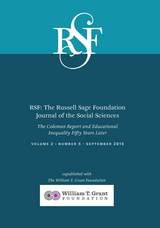 RSF: The Russell Sage Foundation Journal of the Social Sciences: The Coleman Report and Educational Inequality Fifty Years Later
Karl Alexander
Russell Sage Foundation, 2016 The 1966 Equality of Educational Opportunity Report (EEO)—also known as the Coleman Report—is one of the most important education studies of the twentieth century. Commissioned by Congress as part of the 1964 Civil Rights Act, the report revealed pervasive school segregation by race, among other inequalities, and began a national dialogue on educational opportunity for minority children. On the fiftieth anniversary of the EEO report, leading scholars revisit its legacy in this special issue of RSF, edited by Karl Alexander and Stephen Morgan. The contributors examine the report’s methods and conclusions through the lens of social science advances over the past half century, and analyze issues such as school reform, persistent racial segregation, and changing educational standards to provide a thoughtful analysis of barriers to educational opportunity today.
The issue begins with a reassessment of the EEO’s major findings. Karl Alexander analyzes the report’s conclusion that families exert greater influence on children’s school performance than the schools themselves. He finds that family, school, and neighborhood all interact to shape children’s academic development in ways that are not always separable. Other contributors investigate how racial achievement gaps have changed since the report’s release. Sean Reardon finds that disparities in average school poverty rates between white and black students’ schools are the most powerful correlate of achievement gaps. Barbara Schneider and Guan Saw show that while blacks aspire to attend college at greater rates than whites, fewer blacks than whites now attend four-year colleges in part due to lesser access to college preparation activities, such as advanced-level academic courses.
Contributors also evaluate and update the EEO’s proposals to reduce longstanding socioeconomic and racial achievement gaps. Prudence L. Carter argues that effective policies for ending racial disparities must account for inequalities within schools as well as between them. Brian Jacob and coauthors explore whether technological advances since the EEO, including online courses, have the potential to reduce some of the educational inequalities associated with residential segregation. Ruth Turley shows how renewed partnerships between education researchers and policymakers at the local, regional, and national levels can improve disadvantaged students’ educational outcomes and increase racial and economic integration. By looking forward as well as back, this issue of RSF documents what educators and scholars have learned from fifty years of social science research on educational opportunity.
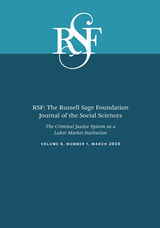 RSF: The Russell Sage Foundation Journal of the Social Sciences: The Criminal Justuce System as a Labor Market Insitution
Sandra Susan Smith
Russell Sage Foundation, 2020 Inmate labor fuels prisons. The incarcerated work in prison industries that collaborate with private corporations. Fair labor laws do not apply to prisons, where it is common for inmates to earn less than one dollar per hour. But involvement with the criminal justice system continues to shape and hinder the future employment and earnings of the formerly incarcerated long after they have been released. In this issue of RSF, edited by sociologist Sandra Susan Smith and legal scholar Jonathan Simon, an interdisciplinary group of scholars analyze how the criminal justice system acts as a de facto labor market institution by compelling or coercing labor from the justice-involved. The social and economic effects of criminal justice involvement are widespread, with almost seven million people under some form of direct supervision. The contributors to this issue examine how the criminal justice system affects the livelihood and families of both the incarcerated and formerly incarcerated. Cody Warner, Joshua Kaiser, and Jason Houle explore how “hidden sentences” --restricted access to voting rights, public housing, and professional licensing--negatively impact labor market outcomes for young adults with criminal records. Michele Cadigan and Garbriela Kirk look at the burden of court fees and fines, or legal financial obligations, that place a strain on the work commitments and resources of low-income people. Joe LaBriola sheds new light on how employment affects recidivism; he shows that parolees who find high-quality jobs, such as in the manufacturing industry, are less likely to return to prison than those employed in low-quality jobs. Noah Zatz and Michael Stoll demonstrate how the threat of imprisonment for nonpayment of child support coerces labor among noncustodial fathers, particularly African-American men. Allison Dwyer Emory and her coauthors show that previously incarcerated fathers are less likely to pay either formal or informal cash child support or offer in-kind assistance to their children’s mothers.
This issue of RSF is a timely contribution to the field of scholarly literature that illuminates the far and often destructive reach that the criminal justice system has on those whose lives it touches. It advances our understanding of how the system functions as a labor market institution and the price it extracts from those involved with it.
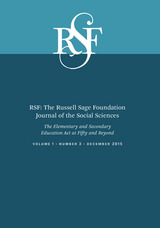 RSF: The Russell Sage Foundation Journal of the Social Sciences: The Elementary and Secondary Education Act at Fifty and Beyond
David A. Gamson
Russell Sage Foundation, 2015 The Elementary and Secondary Education Act (ESEA) of 1965, a key component of President Johnson’s War on Poverty, was designed to aid low-income students and to combat racial segregation in schools. Over the last several decades, the ESEA has become the federal government’s main source of leverage on states and school districts to enact its preferred reforms, including controversial measures such as standardized testing. In this issue of RSF, an esteemed group of education scholars examine the historical evolution of the ESEA, its successes and pitfalls, and what they portend for the future of education policies.
The ESEA has historically enabled the federal government to address educational inequality at the local level. Among the nine articles in the issue, Erica Frankenberg and Kendra Taylor discuss how the ESEA, in conjunction with the Civil Rights Act, accelerated desegregation in the South in the 1960s by withholding federal funding from school districts that failed to integrate. Rucker C. Johnson shows that higher ESEA spending in school districts between 1965 and 1980 led to increased likelihood of high school graduation for students, and low-income students in particular. Students in districts with higher spending were also less likely to repeat grades or to be suspended from school. Yet, as Patrick McGuinn shows, the institutional and administrative capacity of the U.S. Department of Education has never been sufficient to force instructional changes at the school level. This was particularly true with the 2001 renewal of the ESEA, the No Child Left Behind Act, which linked federal funding to schools’ test-score outcomes rather than to programs designed to combat social inequalities.
The issue also investigates the unintended consequences of the ESEA and offers solutions to offset them. As Patricia Gándara and Gloria Ladson-Billings demonstrate, ESEA reforms have, in some circumstances, led to the neglect of the needs of minority students and second-language learners. Gándara shows that No Child Left Behind requires “bilingual” education programs to focus on rapid acquisition of English, often to the detriment of those learning English as a second language. Ladson-Billings shows that the ESEA’s standardized testing mandates may suppress innovative teaching methods, and argues for reforms that use multidisciplinary approaches to craft new curricula. Bringing together research on the successes and shortcomings of the ESEA, this issue of RSF offers new insights into federal education policy and demonstrates that this landmark legislation remains a powerful force in the lives of educators and students fifty years after its initial implementation.
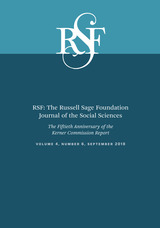 RSF: The Russell Sage Foundation Journal of the Social Sciences: The Fiftieth Anniversary of the Kerner Commission Report
Susan T. Gooden
Russell Sage Foundation, 2018 In 1967, President Lyndon B. Johnson established the National Advisory Commission on Civil Disorders to investigate the causes of the more than 150 urban riots sweeping cities throughout the nation. In 1968, the commission released its findings, widely known as the Kerner Report, and warned that the nation was “moving toward two societies, one black, one white—separate and unequal.” This special issue of RSF, edited by political scientist Susan Gooden and economist Samuel Myers, revisits the Kerner Report’s conclusions and recommendations on the fiftieth anniversary of its publication. How far have we come? What worked and what didn’t? How does the Kerner Report help us understand racial disparities in the twenty-first century?
Articles in the issue examine the extent to which the recommendations in the Kerner Report contributed to policy changes and improvements in the social and economic well-being of urban residents . In their introduction, Gooden and Myers analyze changes in socioeconomic inequality between whites and blacks over the last five decades. They find that while the black poverty rate has declined and black educational attainment has increased, disparities still remain. Additionally, the income gap and disparities in unemployment between blacks and whites remain virtually unchanged. Rick Loessberg and John Koskinen similarly note the persistence of these disparities, but also show that some of the Kerner Report’s recommendations were adopted at local levels and have provided the foundation for increased racial diversity in media, law enforcement reforms, and public housing desegregation.
Other contributors study the urban areas that were sites of the riots. Reynolds Farley shows that in Detroit, residential segregation has declined and interracial marriage has increased over the last fifty years. However, on key economic measures such as income and wealth, African Americans have fallen even further behind whites than they were in 1967 due to dramatic changes in Detroit’s labor market. In their study of wealth inequality in Los Angeles, Melany De La Cruz-Viesca and coauthors show that much of the wealth gap between blacks and whites is due to disparities in home ownership, a subject neglected in the Kerner Report. Marcus Casey and Bradley Hardy study the evolution of African American neighborhoods since the Kerner Report and find that neighborhoods directly affected by riots in the 1960s still remain among the most economically disadvantaged today.
The Kerner Report endures as a classic touchstone in the nation’s search for a path toward equality. Together, the articles in this special issue demonstrate the long-term influence of the report and show where further progress is needed to close the racial divide.
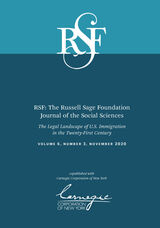 RSF: The Russell Sage Foundation Journal of the Social Sciences: The Legal Landscape of U.S. Immigration in the Twenty-First Century
Katharine M. Donato
Russell Sage Foundation, 2020 Immigration has long been viewed as both essential to American society and a polarizing political issue. Recent flashpoints around immigration include a U.S. Supreme Court decision upholding the legality of Deferred Action for Childhood Arrivals (DACA), enacted in 2012, to provide a pathway to citizenship for young, undocumented immigrants. The Trump administration has limited visas for foreign workers, banned travelers from predominantly Muslim countries, narrowed asylum-seeking procedures, and increased immigration enforcement. In this issue of RSF, edited by demographer Katharine M. Donato and economist Catalina Amuedo-Dorantes, an interdisciplinary group of scholars traces the history and contemporary landscape of legal immigration to the United States.
Donato and Amuedo-Dorantes outline American immigration policies from 1880 to the present and consider the impact of the COVID-19 pandemic on immigration. They underscore the fact that many recent immigration policies have been a result of presidential executive orders rather than legislative acts, making families and workers who enter the country without proper documentation especially vulnerable. They also examine how and why these orders are often racist and xenophobic, privileging some racial and ethnic groups and excluding others.
Contributors to the issue investigate the various ways in which immigrants secure visas, working permits, and citizenship in the United States, including through employment and family ties, as well as special statuses for military veterans, refugees, asylum seekers, and unaccompanied minors. Daniel Costa writes about how temporary migrant workers’ precarious immigration status makes them particularly likely to experience workplace abuse because they fear losing their jobs and being deported if they complain about unfair labor practices. Pia Orrenius and Madeline Zavodny consider the substantial increase in employer demand for temporary work visas, demonstrating how improved economic conditions have led to this surge, creating a viable alternative to hiring unauthorized workers. Julia Gelatt uses employment and economic data analysis to compare multiple classes of legal immigrants. Her research demonstrates that employer-sponsored immigrants are better educated, exhibit higher English proficiency, and work in more highly skilled jobs than other types of immigrants (including family-sponsored, humanitarian, and diversity visa immigrants).
Other contributors examine the experiences of immigrants with special statuses, including veterans. Cara Wong and Jonathan Bonaguro find that Americans are more likely to support a path to citizenship via military service for immigrants who entered the country with the appropriate documentation, and that many Americans believe that undocumented migrants should be barred from the military, Peace Corps, AmeriCorps and firefighting. Van C. Tran and Francisco Lara-García find little variation in early socioeconomic outcomes between refugee groups from various countries. They show that schooling and employment, along with strategic financial, community building, and other support services, are critical factors in the successful integration and improved socioeconomic outcomes of refugees. Luis Edward Tenorio finds that the patchwork of legal systems, including family, immigration, and federal courts that adjudicate the laws for children with special immigrant juvenile status, make for the uneasy and uneven integration of unaccompanied minors into key social institutions.
This issue of RSF is a timely contribution that will invigorate the field of scholarly work on the American legal immigration system.
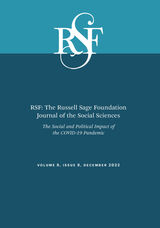 RSF: The Russell Sage Foundation Journal of the Social Sciences: The Social and Political Impact of the Covid-19 Pandemic
Beth Redbird
Russell Sage Foundation, 2022 In the spring of 2020, the COVID-19 pandemic created large-scale disruptions in American society almost overnight. Yet the federal government provided little coordination or guidance in the face of the crisis. State and local governments found themselves primarily responsible for enacting policies and communicating information about the virus with the public,resulting in a wide variety of responses to the pandemic, including in public health recommendations and mandates. In this issue of RSF sociologist Beth Redbird, political scientist Laurel Harbridge-Yong, communications expert Rachel Davis Mersey, and an interdisciplinary group of contributors explore how social and political factors shaped the initial responses to the pandemic and how this impacted individuals and communities.
The 11 articles in this issue examine how information about the pandemic was disseminated, the disparate impacts of COVID-19 on different groups, and the government’s response to the pandemic. Courtney Page-Tan and colleagues find that people who relied on information from close social networks and trusted formal institutions, such as the CDC, were more likely to engage in behavior aimed at curbing the spread of COVID-19, such as staying home and avoiding crowded areas. Laura E. Evans and colleagues find that while Native Americans were disproportionately impacted by COVID-19, states in which Native Americans had greater representation and political power in state politics saw fewer COVID-19 cases on tribal lands. They also find that there were fewer COVID-19 cases on tribal lands with strong networks of community-based and tribally controlled health facilities. Claire Kamp Dush and colleagues find that individuals who identify as non-White or non-heterosexual experienced higher levels of COVID-19 stress and racial trauma stress, both of which are associated with poorer mental health outcomes. Sarah James and colleagues find that state variation in the collection and publication of COVID-19 data reflected state capacity. Yet the main driver of variation in state policy response and implementation of mitigation measures was primarily partisanship. Elizabeth Suhay and colleagues find that trust in federal, state, and local government all fell during the first year of the pandemic. However, individuals with more trust in state government and local health officials were more likely to engage in protective health behaviors, while those with higher trust in the federal government were less likely to engage in such behaviors.
While the impacts of the COVID-19 pandemic will continue for years to come, this volume of RSF begins the investigation into how the pandemic has altered social, cultural, and political dynamics in American society.
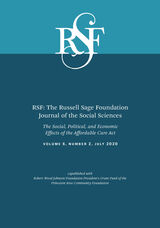 RSF: The Russell Sage Foundation Journal of the Social Sciences: The Social, Political, and Economic Effects of the Affordable Care Act
Andrea Campbell
Russell Sage Foundation, 2020 The Patient Protection and Affordable Care Act, often referred to as the ACA or Obamacare, was enacted in 2010 in the wake of the Great Recession. The law transformed the way that Americans access healthcare, nearly halving the ranks of the 49 million uninsured Americans. Edited by political scientist Andrea Louise Campbell and economist Lara Shore-Sheppard, this issue of RSF examines the social, political, and economic effects of this landmark legislation. This journal issue explores the political dimensions of the rollout of the ACA and the attendant backlash. Contributors Helen Levy, Andrew Ying, and Nicholas Bagley argue that despite repeated efforts at repeal, over 80 percent of the Act has been implemented as it was originally intended. Julianna Pacheco, Jake Haselswerdt, and Jamila Michener show that when Republican governors support Medicaid expansion, Republican voters become more favorable toward the ACA, and polarization between Republican and Democrat voters decreases. Yet Charles Courtemanche, James Marton, and Aaron Yelowitz find little impact of the ACA on voter participation. Lisa Beauregard and Edward Miller examine states’ adoption of the ACA’s home and community-based care services for the elderly and people with disabilities, finding that states with more liberal elected officials and more fiscal capacity were more likely to adopt these provisions. Paul Shafer, David Anderson, Seciah Aquino, Laura Baum, Erika Franklin Fowler, and Sarah Gollust probe the role of different types of health insurance and political advertising on insurance enrollment. Richard Fording and Dana Patton explain the emergence of contentious Medicaid work requirements and patient co-pays that limit access to Medicaid. Other contributors address how the ACA affects marginalized populations. Carrie Fry, Thomas McGuire, and Richard Frank link Medicaid expansion to lower rates of recidivism among the formerly incarcerated. Radhika Gore, Ritu Dhar, Sadia Mohaimin, Priscilla Lopez, Anna Divney, Jennifer Zanowiak, Lorna Thorpe, and Nadia Islam study primary care practices serving South Asian immigrants in New York City and highlight the importance of social context and organizational constraints in designing population health interventions. The issue also examines the economic effects of the ACA, especially on access to private and public health insurance. Both Mark Hall and Jean Abraham study instability in ACA health insurance markets, with Hall focusing on uncertainty arising from political factors and Abraham examining the factors that lead local markets to face high premiums and low insurer participation. Philip Rocco and Andrew Kelly explore the mechanisms included in the ACA to try to spur innovations in care delivery that both improve health and generate long-term cost savings. As the COVID-19 pandemic affects healthcare in unprecedented ways, affordable healthcare access is critical. This RSF journal issue offers a timely, thoughtful consideration of one of the most pressing issues in American life.
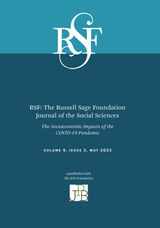 RSF: The Russell Sage Foundation Journal of the Social Sciences: The Socioeconomic Impacts of the COVID-19 Pandemic
Schneider, Daniel
Russell Sage Foundation, 2023 The COVID-19 pandemic laid bare stark structural inequalities in the United States. Federal, state, and local governments responded with policies to help mitigate the potential devastation with varying success. In this issue of RSF, co-published with the JPB Foundation, public policy scholar Steven Raphael, sociologist Daniel Schneider, and an interdisciplinary group of contributors examine the effectiveness of government response on the socioeconomic consequences of the pandemic. The 11 articles in this issue examine the impacts of the COVID-19 pandemic and federal and local responses to the crisis on social safety net usage, unemployment insurance (UI) recipiency, parenting and gender disparities, housing, and experiences with the criminal justice system. Marianne P. Bitler and colleagues find that during the pandemic, participation in the Supplemental Nutrition Assistance Program (SNAP) increased more in counties that experienced larger employment shocks, however, the SNAP pandemic benefit increases were less generous to Black and Hispanic SNAP participants as compared to White participants. Alex Bell and colleagues show while the UI recipiency rate increased substantially across the U.S. during the pandemic, wealthier states had higher recipiency rates and states with higher shares of Black residents had lower recipiency rates. Liana Christin Landivar and colleagues reveal that remote schooling was associated with reduced employment among mothers compared to fathers and women without children, with Black mothers experiencing the largest reduction in employment. Vincent J. Reina and Yeonhwa Lee find that low-income renters who received emergency rental assistance during the pandemic had lower arrears, a lower likelihood of having rent-related debt, and a lower likelihood of experiencing debilitating anxiety. Samantha Plummer and colleagues show that individuals leaving jail or who had criminal cases during the early phase of the pandemic suffered high levels of housing and food insecurity as well as joblessness, but those with co-occurring mental illness and substance abuse problems experienced the highest levels of material hardship. This issue of RSF sheds light on how the pandemic and the corresponding government response have both reinforced and reshaped socioeconomic inequality in the United States.
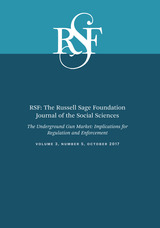 RSF: The Russell Sage Foundation Journal of the Social Sciences: The Underground Gun Market: Implications for Regulation and Enforcement
Philip J. Cook
Russell Sage Foundation, 2017 Each year, gun homicides kill over ten thousand people in the United States. While most guns are initially purchased legally, many enter the underground market and end up in the hands of dangerous offenders, such as gang members and convicted felons. This issue of RSF, edited by public policy scholars Philip J. Cook and Harold A. Pollack, brings together eight articles exploring the markets for guns, both legal and illegal. The contributors draw from new datasets and interviews with inmates to examine how offenders obtain guns. By turning a spotlight on these little-understood supply chains, these chapters provide guidance for stemming the flow of guns to the underground market.
Cook and Pollack initiate the discussion with a comprehensive introduction that includes an original framework for understanding the legality of transactions that arm dangerous offenders. Several contributors review trends in gun ownership across the nation and investigate how guns enter the underground market. Deborah Azrael and coauthors conduct a comprehensive survey of gun owners and find 270 million guns in private circulation. They estimate that 70 million firearms changed hands during a recent five-year period. Most of those transactions were sales by licensed dealers; Garen Wintemute reports on a survey of dealers that assesses the wide disparities among them as sources of guns to offenders. Charles Wellford and coauthors use trace data and prison interviews to study how criminals obtain their guns in three jurisdictions that differ widely with respect to gun regulations and culture.
Other contributors explore the effects of gun regulations and legislation on illegal supply chains. Daniel Webster and coauthors study the effects of Maryland’s 2013 Firearm Safety Act, which required all handgun purchasers to obtain a license. They find that 41 percent of surveyed parolees reported that it was more difficult to obtain a handgun after the law passed due to increased cost, lack of trusted sources, or people being less willing to buy handguns on their behalf. Analyzing over three decades of data on handguns recovered in Boston, Anthony Braga shows that fewer guns are illegally obtained from states that adopt legislation restricting buyers to one gun per month. George Tita and coauthors report the results of an inmate survey in Los Angeles in which they explored respondents’ knowledge of gun laws. These findings suggest that laws aimed at legal gun transactions may also decrease the entry of guns into the underground market.
The rate of gun violence in the U.S. surpasses that of any other advanced nation. This issue of RSF offers new empirical research on the underground market that arms dangerous criminals and provides a rich foundation for policies designed to curb gun violence.
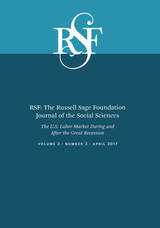 RSF: The Russell Sage Foundation Journal of the Social Sciences: The U.S. Labor Market During and After the Great Recession
Arne L. Kalleberg
Russell Sage Foundation, 2017 The Great Recession was the most disastrous economic upheaval in the U.S. since the Great Depression. Nearly nine million jobs were lost, median family incomes declined by about 8 percent, and the rate of long-term unemployment reached historic highs. Although the recession was officially declared over in June 2009, its effects on the labor market lingered long after. In this issue of RSF, edited by Arne L. Kalleberg and Till M. von Wachter, scholars analyze the longer-term impacts of the Great Recession on jobs, workers, and economic security.
Contributors explore a number of changes to the labor market and union density during and after the Great Recession. Jesse Rothstein investigates the factors contributing to persistently high unemployment and finds that reduced employer demand for workers was more important than labor mismatch—or unemployed workers lacking the appropriate skills for available jobs. Ruth Milkman and Stephanie Luce find increased hostility to unions among employers and steep job losses in traditionally unionized industries, both of which constricted organized labor during and after the Great Recession.
Other articles examine the effects of job loss on unemployed individuals’ mental health and family lives. Kelsey J. O’Connor finds that declining income and rising unemployment contributed to the lowest level of reported happiness in 2010, particularly for men, older people, and Hispanics. William Dickens and coauthors evaluate families’ ability to weather job losses during the Great Recession by relying on savings and find that most had insufficient wealth to buffer large earnings losses for more than a short period of time. Gokce Basbug and Ofer Sharone explore the extent to which the negative emotional toll of long-term unemployment is shaped by gender and marital status. They find that marriage tends to boost the well-being of both men and women during times of unemployment. Among married men, however, this benefit disappeared when controlling for household income, suggesting that the benefits of marriage are related more to additional income than to other forms of intangible or emotional support.
The duration and severity of the Great Recession sets it apart from earlier economic downturns and, as this issue shows, it has had long-term consequences for workers and their families.
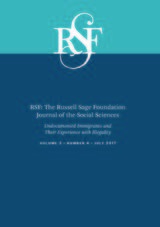 RSF: The Russell Sage Foundation Journal of the Social Sciences: Undocumented Immigrants and Their Experience with Illegality
Roberto G. Gonzales
Russell Sage Foundation, 2017 Today, an estimated 11.3 million undocumented immigrants live in the U.S. Most have family members who are citizens or lawful permanent residents, and over half have lived here for at least thirteen years. Yet, the threat of deportation and lack of citizenship rights have profound effects on the well-being of both undocumented individuals and their families. In this issue of RSF, editors Roberto G. Gonzales and Steven Raphael and an interdisciplinary team of scholars examine the lives of undocumented immigrants and the challenges that confront them.
Caitlin Patler and Nicholas Branic find that undocumented individuals in immigrant detention facilities that are privately operated are less likely to be visited by family members than those in county or city jails, in part because private facilities have restricted visiting hours and are more difficult to access via public transportation. Lauren Heidbrink finds that unaccompanied minors in the custody of the Office of Refugee Resettlement (ORR) are less likely to be released to guardians or reunited with family members because ORR standards are much tougher than those used by child protective services for minor citizens.
Lauren E. Gulbas and Luis H. Zayas find that many children with undocumented parents experience symptoms of anxiety and depression due to fears about their parents’ status. Yet, increased access to financial, educational, legal, and other immigration-related resources for these families can help buffer these children against trauma related to deportation and family separations. Susan K. Brown and Alejandra J. Sanchez focus on children with undocumented mothers and show that because having an undocumented mother is associated with a reduction in children’s years of schooling, it also indirectly lowers their levels of voting, activism, and political awareness as young adults.
Although undocumented immigrants are more enmeshed in the U.S. than they have been in the past, their status prevents further integration into society. This issue reveals the consequences of illegality not just for undocumented immigrants, but also for their families and their communities.
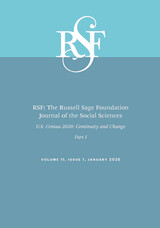 RSF: The Russell Sage Foundation Journal of the Social Sciences: U.S. Census 2020: Continuity and Change
Zhenchao Qian
Russell Sage Foundation, 2025 Catalog copy pertains to both volumes 11.1 and 11.2
The census has registered more than two centuries of growth and transformation in America’s political, social, and economic life. It traditionally gives us the opportunity to ask big questions about and measure changes in American society. Sociologist and demographer Zhenchao Qian, economist Trevon Logan, and an interdisciplinary group of contributors examine how American society has changed — or stayed the same — from 2010-2020.
Topics examined in Issue 1 include the impact of census counts, changes in neighborhood demographics, gender inequality in education, and racial inequality in employment. Lisa Neidert and colleagues find that the census consistently undercounts Hispanics, Blacks, and Native Americans and overcounts Whites and Asians, which has negative impacts on state and federal funding for vulnerable communities. Nima Dahir shows the arrival of Black immigrants into Black American neighborhoods often results in a decline in the native Black American population and an increase in White residents. Claudia Buchmann and colleagues reveal that women are now earning more advanced degrees than men in the U.S., however rising shares of women, including those who are pursing advanced degrees, are attending for profit institutions and carrying student debt. Julie Y. Cai and Marybeth J. Mattingly find that workers with variable hours have lower incomes than those who have more stable hours and Black workers earn substantially less than their White counterparts when working jobs with volatile hours.
Themes explored in Issue 2 include changes in living arrangements, divergent families, and rural America. Hyunjoon Parkand colleagues find that despite growing public concern about the potential rise in solitary living, the likelihood of living alone has not changed much over the last four decades except for older men, who have an increased likelihood of living alone. Christopher S. Carpenter and colleagues show that gender minority individuals, including transgender and nonbinary individuals, are less likely to be married, more likely to be widowed, and less likely to live in a traditional two-adult household compared to their cisgender counterparts. Daniel T. Lichter and Kenneth M. Johnson reveal that while rural America is often envisioned as a monolith, it is made up of complex and diverse economic, social, and demographic conditions.
This volume of RSF provides an updated and insightful snapshot of American society in the 2010s.
 RSF: The Russell Sage Foundation Journal of the Social Sciences: U.S. Census 2020: Continuity and Change
Zhenchao Qian
Russell Sage Foundation, 2024 Catalog copy pertains to both volumes 11.1 and 11.2
The census has registered more than two centuries of growth and transformation in America’s political, social, and economic life. It traditionally gives us the opportunity to ask big questions about and measure changes in American society. Sociologist and demographer Zhenchao Qian, economist Trevon Logan, and an interdisciplinary group of contributors examine how American society has changed — or stayed the same — from 2010-2020.
Topics examined in Issue 1 include the impact of census counts, changes in neighborhood demographics, gender inequality in education, and racial inequality in employment. Lisa Neidert and colleagues find that the census consistently undercounts Hispanics, Blacks, and Native Americans and overcounts Whites and Asians, which has negative impacts on state and federal funding for vulnerable communities. Nima Dahir shows the arrival of Black immigrants into Black American neighborhoods often results in a decline in the native Black American population and an increase in White residents. Claudia Buchmann and colleagues reveal that women are now earning more advanced degrees than men in the U.S., however rising shares of women, including those who are pursing advanced degrees, are attending for profit institutions and carrying student debt. Julie Y. Cai and Marybeth J. Mattingly find that workers with variable hours have lower incomes than those who have more stable hours and Black workers earn substantially less than their White counterparts when working jobs with volatile hours.
Themes explored in Issue 2 include changes in living arrangements, divergent families, and rural America. Hyunjoon Parkand colleagues find that despite growing public concern about the potential rise in solitary living, the likelihood of living alone has not changed much over the last four decades except for older men, who have an increased likelihood of living alone. Christopher S. Carpenter and colleagues show that gender minority individuals, including transgender and nonbinary individuals, are less likely to be married, more likely to be widowed, and less likely to live in a traditional two-adult household compared to their cisgender counterparts. Daniel T. Lichter and Kenneth M. Johnson reveal that while rural America is often envisioned as a monolith, it is made up of complex and diverse economic, social, and demographic conditions.
This volume of RSF provides an updated and insightful snapshot of American society in the 2010s.
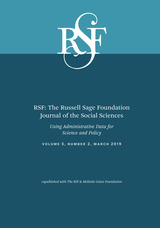 RSF: The Russell Sage Foundation Journal of the Social Sciences: Using Administrative Data for Science and Policy
Andrew M. Penner
Russell Sage Foundation, 2019 Note: The catalog copy refers to both issues 2 and 3.
In the twenty-first century, administrative data collected by the government, schools, hospitals, and other institutions are essential for effectively managing and evaluating public programs. Yet the U. S. lags behind many other countries when it comes to organizing these data and making linkages across different domains, such as education, health, and the labor market. This double issue of RSF, edited by sociologist Andrew Penner and developmental psychologist Kenneth Dodge, illustrates the tremendous potential of administrative data and provides guidance for the researchers and policymakers. Contributors across multiple disciplines demonstrate how linking disparate sources of administrative data can help us better understand the challenges faced by people in need, thereby improving the reach and efficiency of policy solutions.
Several contributors show how databases tracking educational attainment yield new insights into the role of schools in either ameliorating or perpetuating socioeconomic inequalities. Sean Reardon analyzes standardized test scores of roughly 45 million K-12 students nationwide to explore how educational opportunity varies by school districts over time. He finds that while affluent districts typically provide high levels of early childhood learning opportunities, there are some schools in high-poverty districts that do have increased average test scores between third and eighth grade. However, this growth still does not close the large achievement gap between low-and high-socioeconomic-status students. Megan Austin and coauthors, using student-level longitudinal data from Indiana, analyze the effects of school voucher programs on academic achievement and find that students who switch from a public to a private school with a voucher experience significant declines in achievement, particularly in math.
Other articles demonstrate how the analysis of administrative data can further our understanding of racial and gender inequality. Janelle Downing and Tim Bruckner link housing foreclosure records and birth records to show that foreclosures and related stresses during the Great Recession contributed to premature births and lower birth weights, particularly for Hispanic mothers and their children. Roberto Fernandez and Brian Rubineau investigate hiring data to explore how network recruitment, or recruitment through employer referrals, affects the “glass ceiling” in the workplace. They show that network recruitment increases women’s representation strongly at lower job levels, and to a lesser extent at higher levels.
Researchers now have unprecedented access to administrative data. As this issue shows, finding innovative ways to combine multiple data sets can facilitate partnerships between social scientists, administrators, and policymakers and extend our understanding of pressing social issues.
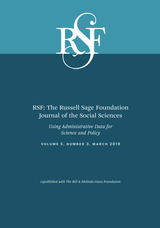 RSF: The Russell Sage Foundation Journal of the Social Sciences: Using Administrative Data for Science and Policy
Andrew M. Penner
Russell Sage Foundation, 2019 Note: The catalog copy refers to both issues 2 and 3.
In the twenty-first century, administrative data collected by the government, schools, hospitals, and other institutions are essential for effectively managing and evaluating public programs. Yet the U. S. lags behind many other countries when it comes to organizing these data and making linkages across different domains, such as education, health, and the labor market. This double issue of RSF, edited by sociologist Andrew Penner and developmental psychologist Kenneth Dodge, illustrates the tremendous potential of administrative data and provides guidance for the researchers and policymakers. Contributors across multiple disciplines demonstrate how linking disparate sources of administrative data can help us better understand the challenges faced by people in need, thereby improving the reach and efficiency of policy solutions.
Several contributors show how databases tracking educational attainment yield new insights into the role of schools in either ameliorating or perpetuating socioeconomic inequalities. Sean Reardon analyzes standardized test scores of roughly 45 million K-12 students nationwide to explore how educational opportunity varies by school districts over time. He finds that while affluent districts typically provide high levels of early childhood learning opportunities, there are some schools in high-poverty districts that do have increased average test scores between third and eighth grade. However, this growth still does not close the large achievement gap between low-and high-socioeconomic-status students. Megan Austin and coauthors, using student-level longitudinal data from Indiana, analyze the effects of school voucher programs on academic achievement and find that students who switch from a public to a private school with a voucher experience significant declines in achievement, particularly in math.
Other articles demonstrate how the analysis of administrative data can further our understanding of racial and gender inequality. Janelle Downing and Tim Bruckner link housing foreclosure records and birth records to show that foreclosures and related stresses during the Great Recession contributed to premature births and lower birth weights, particularly for Hispanic mothers and their children. Roberto Fernandez and Brian Rubineau investigate hiring data to explore how network recruitment, or recruitment through employer referrals, affects the “glass ceiling” in the workplace. They show that network recruitment increases women’s representation strongly at lower job levels, and to a lesser extent at higher levels.
Researchers now have unprecedented access to administrative data. As this issue shows, finding innovative ways to combine multiple data sets can facilitate partnerships between social scientists, administrators, and policymakers and extend our understanding of pressing social issues.
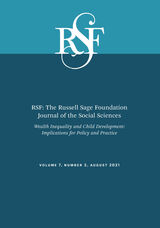 RSF: The Russell Sage Foundation Journal of the Social Sciences: Wealth Inequality and Child Development: Implications for Policy and Practice
Christina Gibson-Davis
Russell Sage Foundation, 2021 Wealth – a household’s assets minus its debts – is an important indicator of child well-being. Higher household wealth related to better academic achievement, behavior, and health among children. Yet a sizeable share of American children, including a majority of Black and Hispanic children, grow up in households with very low levels of wealth, and wealth inequality among households with children is rising even faster than among the general population. This volume of RSF, edited by social policy experts Christina Gibson-Davis and Heather Hill, provides the first comprehensive examination of the contours and consequences of wealth inequality for children under the age of 18. An interdisciplinary roster of contributors consider the vast racial and ethnic disparities in wealth and how those disparities affect child well-being.
Contributors Fabian Pfeffer and Nora Waitkus find that child wealth inequality is far worse in the U.S. than in other industrialized countries. Editors Gibson-Davis and Hill show that a relatively small group of American parents—mostly White—control the lion’s share of wealth, with Black and Hispanic parents having only pennies on the dollar for every dollar of White parental wealth. Nina Bandelj and Angelina Grigoryeva show how White parents with above median wealth are more likely than other parents to practice “financially intensive parenting,” saving and borrowing in ways that promote child achievement. After controlling for other measures of family resources and socioeconomic status, Portia Miller and colleagues demonstrate that family wealth is uniquely related to both academic and behavioral development throughout childhood and adolescence and that wealth helps buffer the negative effects of low family income. Jordan Conwell and Leafia Zi Ye find equalizing wealth is not sufficient to eliminate race- and ethnic-based gaps in academic achievement: even among families with the same levels of wealth Black and Hispanic children often have significantly worse scores than Whites.
High levels of childhood wealth inequality are not inevitable; they are the consequence of laws and practices that favor wealth accumulation among few, primarily White, families. Jin Huang and coauthors look at one of the few policy models for increasing savings in low-income child households, Child Development Accounts, which have been shown to increase educational savings and improve maternal mental health, but they have yet to be adopted nationwide. Two studies in this issue, by Margot Jackson and colleagues and by Katherine Michelmore and Leonard Lopoo, find that large-scale income-support programs, the EITC and Medicaid, have positive spillovers onto asset accumulation, but policies designed to fundamentally alter the distribution of wealth among families with children will require more expansive changes to the tax code and program asset caps.
This issue of RSF expands our understanding of wealth inequality and its effects on children, and provides important insights into policies and practices that either directly or indirectly boost wealth acquisition among child households.
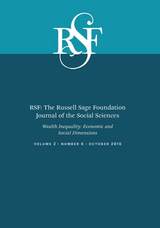 RSF: The Russell Sage Foundation Journal of the Social Sciences: Wealth Inequality: Economic and Social Dimensions
Fabian T. Pfeffer
Russell Sage Foundation, 2016 It is widely acknowledged that over the last several decades wealth has become more concentrated at the very top. Less appreciated is the fact that wealth inequality is increasing across all households: extremely wealthy households are pulling away from the top, top households are pulling away from the middle, and middle households are pulling away from the bottom. This development has far-reaching implications for nearly all aspects of the economic and social lives of Americans. In this issue of RSF, edited by Fabian T. Pfeffer and Robert F. Schoeni, leading social scientists investigate the causes of wealth inequality and explore its consequences for social mobility, racial equity, education, marriage, and family well-being.
Several contributors investigate the growing chasm in wealth between the rich and the middle class. Edward Wolff attributes much of the recent wealth loss among the middle class to the housing market crash, as housing accounts for a much greater share of their total wealth than it does for the rich. Jonathan Fisher and coauthors show that wealth inequality is far higher than inequality in income and consumption, and argue that because wealth acts as a buffer to income changes, it is perhaps the most relevant measure of economic inequality. Others explore the persistent racial wealth gap. Alexandra Killewald and Brielle Bryan show that the average wealth return on home ownership for African Americans is only a quarter of the return for whites. Bryan Sykes and Michelle Maroto find that the incarceration of a family member is associated with reduced family wealth, exacerbating the racial wealth gap because of racial disparities in incarceration.
Other articles focus on the effects of wealth inequality on families and relationships. Emily Rauscher finds that that parents’ financial support for their children’s education, which has positive effects on children’s educational attainment, is increasingly connected to parental wealth, tightening the link between wealth inequality and inequality of opportunity. And Alicia Eads and Laura Tach find that while greater family wealth is associated with more stable marriages, lack of wealth—particularly in the form of unsecured debt—is associated with marital instability.
As wealth inequality has increased, it is increasingly important to understand its origins and manifold social and economic consequences for current and future generations.
RTE and the Globalisation of Irish Television
Farrel Corcoran
Intellect Books, 1995 For about 40 years, RTE's radio and television channels have played an enormous role in shaping Irish social and cultural life. RTE's work is frequently shrouded in secrecy and mystique, which means that conspiracy theories abound about how it is governed and how it relates to various power centers in Irish life. RTE and the Globalisation of Irish Television is firmly aimed at increasing the transparency that should characterize public broadcasting and at demystifying this national institution that plays such an enormous role in the cultural and political life of Ireland.
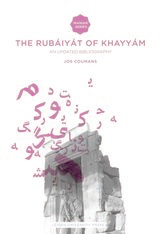 The Rubáiyát of Omar Khayyám: An Updated Bibliography
Jos Coumans
Leiden University Press, 2010 This book fills a gap by providing a new selection and description of almost 900 editions of the world-famous Persian quatrains: The Rubáiyát of Omar Khayyám. This is the first bibliography since the first Rubáiyát bibliography by A.G. Potter, published in 1929.
Omar Khayyám lived in the 11th Century. A Persian homo universalis, he was a mathematician, scientist, philosopher, astronomer and poet. He is believed to have written 200 to 600 Rubáiyát (quatrains) in Persian. His Rubáiyát has been translated into Arabic, Chinese, Dutch, English, French, German, Hebrew, Hindi, Russian, Urdu and many other languages. It has been published in numerous editions: precious volumes with jeweled bindings, artist's books, scholarly and critical editions, forgeries and fake editions, making The Rubáiyát of Omar Khayyám a perfect object for book collectors and lovers of poetry.
Edward FitzGerald's translation of the Rubáiyát of Omar Khayyám has been one of the world's most popular books. Since the first version in 1859, new editions, reprints and translations have appeared in an almost endless flow, varying from plain text to highly decorated, illustrated editions and from almost microscopic miniatures to monumental, oversized volumes. FitzGerald's translation stands out, but there are hundreds of other translations, from many countries, and you will find them all in this book.
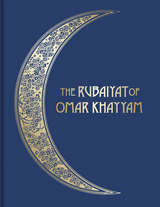 The Rubáiyát of Omar Khayyám: Illustrated Collector's Edition
Omar Khayyám
Bodleian Library Publishing, 2014
A book of verses underneath the bough,
A jug of wine, a loaf of bread—and thou.
The Rubáiyát is one of the most popular poems of all time. A collection of quatrains composed in the eleventh century by Persian poet and philosopher Omar Khayyám, it was first published in English-language translation by Edward Fitzgerald in 1859. Since then, its melancholy tone and enigmatic philosophy of mourning the painful brevity of life while celebrating what pleasures we may find have made it an inspiration to many writers, including Matthew Arnold and Thomas Hardy. More recently, it has also been the subject of many music adaptations and films.
This collector’s edition of The Rubáiyát features stunning full-color illustrations created by René Bull in 1913 that interpret the poem’s brilliant sensual imagery and provide the perfect complement to Fitzgerald’s translation, which remains the most famous. Every page of poetry in this collector’s edition features unique art nouveau borders in gold, with each illustration framed in a gold border.
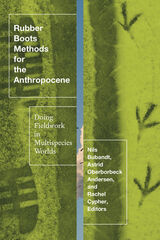 Rubber Boots Methods for the Anthropocene: Doing Fieldwork in Multispecies Worlds
Astrid Oberborbeck Andersen
University of Minnesota Press, 2023 A methodological follow-up to Arts of Living on a Damaged Planet
The environmental and climatic crises of our time are fundamentally multispecies crises. And the Anthropocene, a time of “human-made” disruptions on a planetary scale, is a disruption of the fabric of life as a whole. The contributors to Rubber Boots Methods for the Anthropocene argue that understanding the multispecies nature of these disruptions requires multispecies methods. Answering methodological challenges posed by the Anthropocene, Rubber Boots Methods for the Anthropocene retools the empirical study of the socioecological chaos of the contemporary moment across the arts, human science, and natural science. Based on critical landscape history, multispecies curiosity, and collaboration across disciplines and knowledge systems, the volume presents thirteen transdisciplinary accounts of practical methodological experimentation, highlighting diverse settings ranging from the High Arctic to the deserts of southern Africa and from the pampas of Argentina to the coral reefs of the Western Pacific, always insisting on the importance of firsthand, “rubber boots” immersion in the field. The methodological companion to Arts of Living on a Damaged Planet: Ghosts and Monsters of the Anthropocene (Minnesota, 2017), this collection puts forth empirical studies of the multispecies messiness of contemporary life that investigate some of the critical questions of our time. Contributors: Filippo Bertoni, Museum für Naturkunde, Berlin; Harshavardhan Bhat, U of Westminster; Nathalia Brichet, U of Copenhagen; Janne Flora, Aarhus U, Denmark; Natalie Forssman, U of British Columbia; Peter Funch, Aarhus U; Kirsten Hastrup, U of Copenhagen; Colin Hoag, Smith College; Joseph Klein, U of California, Santa Cruz; Andrew S. Mathews, U of California, Santa Cruz; Daniel Münster, U of Oslo; Ursula Münster, U of Oslo; Jon Rasmus Nyquist, U of Oslo; Katy Overstreet, U of Copenhagen; Pierre du Plessis, U of Oslo; Meredith Root-Bernstein; Heather Anne Swanson, Aarhus U; Anna Lowenhaupt Tsing, U of California, Santa Cruz; Stine Vestbo.
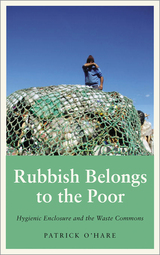 Rubbish Belongs to the Poor: Hygienic Enclosure and the Waste Commons
Patrick O’Hare
Pluto Press, 2021 Rubbish. Waste. Trash. Whatever term you choose to describe the things we throw away, the connotations are the same; of something dirty, useless and incontrovertibly 'bad'. But does such a dismissive rendering mask a more nuanced reality? In Rubbish Belongs to the Poor, Patrick O'Hare journeys to the heart of Uruguay's waste disposal system in order to reconceptualize rubbish as a 21st century commons, at risk of enclosure. On a giant landfill site outside the capital Montevideo we meet the book's central protagonists, the 'classifiers': waste-pickers who recover and recycle materials in and around its fenced but porous perimeter. Here the struggle of classifiers against the enclosure of the landfill, justified on the grounds of hygiene, is brought into dialogue with other historical and contemporary enclosures - from urban privatizations to rural evictions - to shed light on the nature of contemporary forms of capitalist dispossession. Supplementing this rich ethnography with the author's own insights from dumpster diving in the UK, the book analyzes capitalism's relations with its material surpluses and what these tell us about its expansionary logics, limits and liminal spaces. Rubbish Belongs to the Poor ultimately proposes a fundamental rethinking of the waste-capitalism nexus.
 Rubbish Belongs to the Poor: Hygienic Enclosure and the Waste Commons
Patrick O’Hare
Pluto Press, 2021 Rubbish. Waste. Trash. Whatever term you choose to describe the things we throw away, the connotations are the same; of something dirty, useless and incontrovertibly 'bad'. But does such a dismissive rendering mask a more nuanced reality? In Rubbish Belongs to the Poor, Patrick O'Hare journeys to the heart of Uruguay's waste disposal system in order to reconceptualize rubbish as a 21st century commons, at risk of enclosure. On a giant landfill site outside the capital Montevideo we meet the book's central protagonists, the 'classifiers': waste-pickers who recover and recycle materials in and around its fenced but porous perimeter. Here the struggle of classifiers against the enclosure of the landfill, justified on the grounds of hygiene, is brought into dialogue with other historical and contemporary enclosures - from urban privatizations to rural evictions - to shed light on the nature of contemporary forms of capitalist dispossession. Supplementing this rich ethnography with the author's own insights from dumpster diving in the UK, the book analyzes capitalism's relations with its material surpluses and what these tell us about its expansionary logics, limits and liminal spaces. Rubbish Belongs to the Poor ultimately proposes a fundamental rethinking of the waste-capitalism nexus.
Rubbish!: The Archaeology of Garbage
William Rathje and Cullen Murphy
University of Arizona Press, 2001 It is from the discards of former civilizations that archaeologists have reconstructed most of what we know about the past, and it is through their examination of today’s garbage that William Rathje and Cullen Murphy inform us of our present. Rubbish! is their witty and erudite investigation into all aspects of the phenomenon of garbage. Rathje and Murphy show what the study of garbage tells us about a population’s demographics and buying habits. Along the way, they dispel the common myths about our “garbage crisis”—about fast-food packaging and disposable diapers, about biodegradable garbage and the acceleration of the average family’s garbage output. They also suggest methods for dealing with the garbage that we do have.
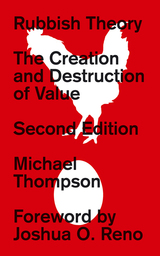 Rubbish Theory: The Creation and Destruction of Value - New Edition
Michael Thompson
Pluto Press, 2017 How do objects that are worth little to nothing become valuable? Who is behind the creation of value, and which types of people find value and comfort in transient, durable, and rubbish objects?
When his highly influential Rubbish Theory, first published in 1979, Michael Thompson launched the discipline of waste studies. It remains the most comprehensive analysis on the culture of waste to date. Thompson argues that there are two mutually exclusive cultural categories that are socially imposed on the world of objects: a transient category and a durable category. However, he identifies a region of flexibility, wherein a transient object that declines in value and life span can linger in a valueless and timeless limbo of rubbish, until it is discovered by a creative individual and transferred into something deemed durable. He links stability and change on one hand, with materiality on the other, providing a rich analysis of social and cultural dynamics. His instrumental theory of rubbish draws on case studies and anthropological fieldwork to highlight the ever-changing subtleties of object value and our complex relationship to waste.
Bringing Rubbish Theory back into print, this updated edition includes a new introduction, preface, foreword, and afterword, thoroughly exploring how Thompson’s key theories have affected our world in the four decades since it was first published and placing it in a contemporary context that shines light on the continued relevance of the book today.
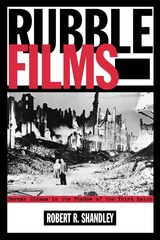 Rubble Films: German Cinema In Shadow Of 3Rd Reich
Robert R. Shandley
Temple University Press, 2001 At the end of World War II, Germany was a broken nation. Split in two and occupied by the victorious Allies, it would have to be rebuilt, literally, from the rubble of its own defeat. Volumes of books have been published chronicling its structural and economic rebirth; this unique study reveals how Germany rebuilt itself culturally.
Rubble Films is a close look at German cinema in the immediate postwar era, and a careful examination of its relationship to Allied occupation. Shandley reveals how German film borrowed -- both literally and figuratively -- from its Nazi past, and how the occupied powers (specifically the US) used its position as victor to open Europe to Hollywood movie products and aesthetics.
Incorporating a careful reading of several important postwar films, Shandley also discusses how the German studio system operated immediately after the war, in the east and the west, giving special focus on DEFA, the east German studio that rose during Soviet occupation.
Pathbreaking in its research, Rubble Films sheds new light on a significant moment of German cultural rebirth, and adds a new dimension to the study of the history of film.
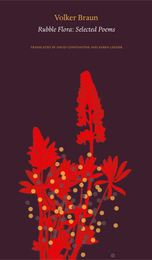 Rubble Flora: Selected Poems
Volker Braun
Seagull Books, 2019 Rubble Flora is a selection of poems from the distinguished, half-century-long career of German poet Volker Braun. Born in the former East Germany, Braun is a humane, witty, brave, and disappointed poet. In the East, his poetry upheld the voice of the individual imagination and identified with a utopian possibility that never became reality. He might be said to have found a truly singular voice amid the colossal upheavals of 1989—exploring the triumph of capitalism and the languages of advertising, terror, politics, and war. At the same time, Braun is a sensual poet in tune with the natural landscape. He has his own touchstones in world literature, and many of his poems set quotations from Rimbaud, Shakespeare, and Brecht into his own context, where they work as ironic illuminations of a present plight. The literary principle of his work lies in the friction of these different voices, whether cast into free form, collage, or classical verse. Cumulatively, Rubble Flora offers a searing vision of these transformative decades.
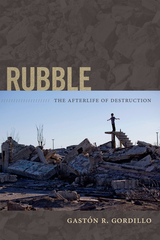 Rubble: The Afterlife of Destruction
Gastón R. Gordillo
Duke University Press, 2014 At the foot of the Argentine Andes, bulldozers are destroying forests and homes to create soy fields in an area already strewn with rubble from previous waves of destruction and violence. Based on ethnographic research in this region where the mountains give way to the Gran Chaco lowlands, Gastón R. Gordillo shows how geographic space is inseparable from the material, historical, and affective ruptures embodied in debris. His exploration of the significance of rubble encompasses lost cities, derelict train stations, overgrown Jesuit missions and Spanish forts, stranded steamships, mass graves, and razed forests. Examining the effects of these and other forms of debris on the people living on nearby ranches and farms, and in towns, Gordillo emphasizes that for the rural poor, the rubble left in the wake of capitalist and imperialist endeavors is not romanticized ruin but the material manifestation of the violence and dislocation that created it.
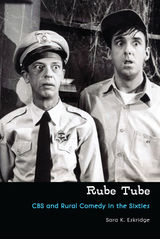 Rube Tube: CBS and Rural Comedy in the Sixties
Sara K. Eskridge
University of Missouri Press, 2022 Historian Sara Eskridge examines television’s rural comedy boom in the 1960s and the political, social, and economic factors that made these shows a perfect fit for CBS. The network, nicknamed the Communist Broadcasting System during the Red Scare of the 1940s, saw its image hurt again in the 1950s with the quiz show scandals and a campaign against violence in westerns. When a rival network introduced rural-themed programs to cater to the growing southern market, CBS latched onto the trend and soon reestablished itself as the Country Broadcasting System. Its rural comedies dominated the ratings throughout the decade, attracting viewers from all parts of the country. With fascinating discussions of The Andy Griffith Show, The Beverly Hillbillies, Petticoat Junction, and other shows, Eskridge reveals how the southern image was used to both entertain and reassure Americans in the turbulent 1960s.
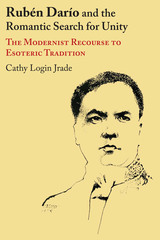 Rubén Darío and the Romantic Search for Unity: The Modernist Recourse to Esoteric Tradition
By Cathy Login Jrade
University of Texas Press, 1983 Modernism was the major Spanish American literary movement of the late nineteenth and early twentieth centuries. Leader of that influential movement was Rubén Darío, the Nicaraguan now recognized as one of the most important Hispanic poets of all time. Like the Romantics in England and the Symbolists on the Continent, Darío and other Modernists were strongly influenced by occultist thought. But, as the poet Octavio Paz has written, "academic criticism has ... preferred to close its eyes to the stream of occultism that runs throughout Darío's work. This silence damages our comprehension of his poetry." Cathy Login Jrade's groundbreaking study corrects this critical oversight. Her work clearly demonstrates that esoteric tradition is central to Modernism and that an understanding of this centrality clarifies both the nature of the movement and its relationship to earlier European literature. After placing Modernism in a broad historical and literary perspective, Jrade examines the impact of esoteric beliefs upon Darío's view of the world and the role of poetry in it. Through detailed and insightful analyses of key poems, she explores the poet's quest for solutions to the nineteenth-century crisis of belief. The movement that Ruben Darío headed brought Hispanic poetry into the mainstream of the "modern tradition," with its sense of fragmentation and alienation and its hope for integration and reconciliation with nature. Rubén Darío and the Romantic Search for Unity enriches our understanding of that movement and the work of its leading poet.
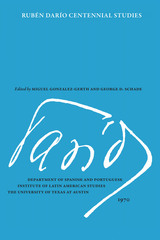 Ruben Dario Centennial Studies
Edited by Miguel Gonzalez-Gerth and George D. Schade
University of Texas Press, 1970 Rubén Darío (1867–1916), the undisputed standard-bearer of the Modernist movement in Hispanic letters, was born in Nicaragua. In 1886 he went to Chile, where he published Azul (1888), his first important book of poems and stories. Later he lived for extended periods in Argentina, Spain, and France, and in these countries produced his best work: compelling poems of beauty, style, and dignity, especially Cantos de vida y esperanza (1905). The perfection of form, exotic essences, and rich ornamentation of his earlier work give way in his most mature poems to self-probings and doubts, the anguish so characteristic of twentieth-century literature. But the hedonistic note, the quenchless appetite for life, dominating Azul and Prosas profanas (1896) never die out, and are magnificently present in El poema del otoño (1910). Darío has had a tremendous impact on Hispanic literature. He is one of the best examples of the poet who is true to his art as determined by his innermost impulses. His poetry has fertilized a whole generation of writers in Spanish America and in Spain, and even now his influence continues to be felt.
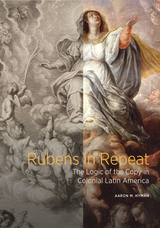 Rubens in Repeat: The Logic of the Copy in Colonial Latin America
Aaron M. Hyman
J. Paul Getty Trust, The, 2021 Winner of the Latin American Studies Association's 2022 Best Book in Colonial Latin American Studies.
This book examines the reception in Latin America of prints designed by the Flemish artist Peter Paul Rubens, showing how colonial artists used such designs to create all manner of artworks and, in the process, forged new frameworks for artistic creativity.
Peter Paul Rubens (1577–1640) never crossed the Atlantic himself, but his impact in colonial Latin America was profound. Prints made after the Flemish artist’s designs were routinely sent from Europe to the Spanish Americas, where artists used them to make all manner of objects.
Rubens in Repeat is the first comprehensive study of this transatlantic phenomenon, despite broad recognition that it was one of the most important forces to shape the artistic landscapes of the region. Copying, particularly in colonial contexts, has traditionally held negative implications that have discouraged its serious exploration. Yet analyzing the interpretation of printed sources and recontextualizing the resulting works within period discourse and their original spaces of display allow a new critical reassessment of this broad category of art produced in colonial Latin America—art that has all too easily been dismissed as derivative and thus unworthy of sustained interest and investigation. This book takes a new approach to the paradigms of artistic authorship that emerged alongside these complex creative responses, focusing on the viceroyalties of New Spain and Peru in the seventeenth and eighteenth centuries. It argues that the use of European prints was an essential component of the very framework in which colonial artists forged ideas about what it meant to be a creator.
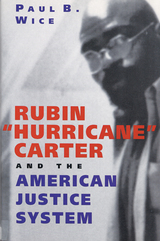 Rubin ' Hurricane' Carter and the American Justice System
Wice, Paul B
Rutgers University Press, 2000 Winner of the 2001 New Jersey Author's Award by the New Jersey Academic Alliance
Paul Wice takes the famous case of Rubin “Hurricane” Carter to another level of scrutiny as he puts the criminal justice system itself on trial. The case illustrates many of the strengths and weaknesses of our nation’s much maligned criminal justice system while affirming the power and resoluteness of the human spirit.
Early on the morning of June 17, 1966, the sound of gunfire echoed through the quite streets of Paterson, New Jersey, as four people were shot, three fatally, inside the Lafayette Bar and Grill. Twenty-nine-year-old Rubin “Hurricane” Carter, a prominent professional boxer, along with his companion, John Artis, were arrested and charged with committing this brutal crime. Prosecutors would later theorize that the murders were racially motivated — Carter and Artis are black, the victims white — to avenge the killing of a black Paterson tavern owner. Despite barely credible and oft-times contradictory evidence presented by both sides, a year after the killings Carter and Artis were convicted of murder and sentenced to life in prison. A second jury upheld the previous convictions in 1976. Artis was imprisoned until 1981, when he was released on parole. Carter remained in jail until 1988, when acting prosecutor John Goceljak elected not to pursue a third trial following the reversal of the 1976 retrial by the Federal District Court, a decision ultimately affirmed by the Circuit Court of Appeals and the U.S. Supreme Court. With the release of the widely discussed movie on Carter starring Denzel Washington, the case has again become visible and controversial.
Wice follows the torturous legal path of this case as it wound its way through first the New Jersey then the federal justice system for the next twenty-two years. His interpretations are informed by interviews with key members of both the prosecution and defense as well as previously unused court documents and transcripts. Wice evaluates the Carter case within a larger theoretical framework to illustrate many of the critical weaknesses of the adversary system and appeals process that is so basic to the American judicial system. Here is what can happen when police and prosecutors act unprofessionally, when critical witnesses lie, and when the justice system itself is unwilling to correct its errors or admit its mistakes.
Ruby for Grief
Michael Burkard
University of Pittsburgh Press, 1981 The work of Michael Burkard has a rich interior quality different from that of any other voice in American poetry. He captures a sense of the mind revising and revealing itself, altering its perceptions.
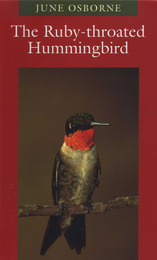 The Ruby-throated Hummingbird
By June Osborne
University of Texas Press, 1998 There is no mistaking a hummingbird. Even people who hardly know a robin from a sparrow recognize that flash of iridescent feathers and the distinctive hovering flight. So popular have "hummers" become that even casual birdwatchers now travel great distances to hummingbird hot spots to see masses of birds in their annual migrations. In this invitingly written book, June Osborne paints a fully detailed portrait of perhaps the best-known hummingbird in the United States, the ruby-throat. Drawing from her own birdwatching experiences, she offers an "up close and personal" look at a female ruby-throat building her nest and rearing young, as well as an account of a day in the life of a male ruby-throat and stories of the hummers' migrations between their summer breeding grounds in the United States and Canada and their winter homes in Mexico and Central America. In addition to this life history, Osborne recounts early hummingbird sightings and tells how the bird received its common and scientific names. After an overview of hummingbirds' distinctive ways of feeding, flying, and conserving energy, she offers a detailed description of the ruby-throat that will help you tell females from males, immature birds from adults, and ruby-throats from similar species. Osborne also takes you on a visit to the "Hummer/Bird Celebration!" at Rockport, reviews hummingbird banding programs, and explains how to attract hummingbirds to your yard or apartment balcony.
Rude and Barbarous Kingdom: Russia in the Accounts of Sixteenth-Century English Voyagers
Edited by Lloyd E. Berry and Robert O. Crummey
University of Wisconsin Press, 1972 Lloyd E. Berry and Robert O. Crummey offer edited accounts of six English voyagers and their experiences in Muscovy Russia between 1553 and 1600. With modernized spelling and presentation, these accounts are accompanied by a glossary of Russian terms, introductions of their authors, and annotations that help put the travelers’ narratives into perspective.
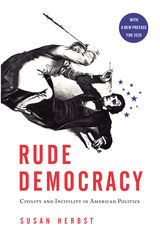 Rude Democracy: Civility and Incivility in American Politics
Authored by Susan Herbst
Temple University Press, 2020 Democracy is, by its very nature, often rude. But there are limits to how uncivil we should be. In her timely and important book, Rude Democracy, Susan Herbst explores the ways we discuss public policy, how we treat each other as we do, and how we can create a more civil national culture. Herbst uses the examples of Sarah Palin and Barack Obama to illustrate her case. She scrutinizes Palin as both victim and perpetrator of incivility, including close analysis of her speeches on the 2008 campaign trail, the tone at her rallies, and her interactions with her audience. Turning to Barack Obama, Herbst argues that a key 2009 speech reveals much about his own perspective on American civility as it pertains to contentious issues such as abortion, and notes, too, what the controversy surrounding the speech reveals about the nature of public opinion in the United States. She also dissects Palin’s and Obama’s roles in the 2009 health care debate. Finally, in a fascinating chapter, Herbst examines how young people come to form their own attitudes about civility and political argument. In Rude Democracy, Susan Herbst insists that Americans need to recognize the bad tendencies and habits we have developed, use new media for more effective debate, and develop a tougher and more strategic political skin. She urges us to boost both the intelligence and productivity of our debates, noting that the effort demands a commitment to the nature of argument itself. Rude Democracy outlines a plan for moving forward and creating a more civil climate for American politics.
Rude Pursuits and Rugged Peaks: Schoolcraft's Ozark Journal, 1818-1819
H. Schoolcraft
University of Arkansas Press, 1996 In the winter of 1818, Henry Rowe Schoolcraft set out from Potosi, Missouri, to document lead mines in the interior of the Ozarks. Intending only to make his fortune by publishing an account of the area's mineral resources, he became the first skilled observer to witness and record frontier life in the Ozarks.
The journal kept by Schoolcraft as he traveled ninety days in the rugged terrain of southern Missouri and northern Arkansas was originally published in 1821 and has become an essential record of Ozark territorial society and natural history documenting some of the earliest American settlers in the region, the power and beauty of many lost portions of the White River, the majesty of the open prairies, and the wealth of wildlife once found in the Ozarks.
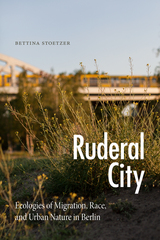 Ruderal City: Ecologies of Migration, Race, and Urban Nature in Berlin
Bettina Stoetzer
Duke University Press, 2022 In Ruderal City Bettina Stoetzer traces relationships among people, plants, and animals in contemporary Berlin as they make their lives in the ruins of European nationalism and capitalism. She develops the notion of the ruderal—originally an ecological designation for the unruly life that inhabits inhospitable environments such as rubble, roadsides, train tracks, and sidewalk cracks—to theorize Berlin as a “ruderal city.” Stoetzer explores sites in and around Berlin that have figured in German national imaginaries—gardens, forests, parks, and rubble fields—to show how racial, class, and gender inequalities shape contestations over today’s uses and knowledges of urban nature. Drawing on fieldwork with gardeners, botanists, migrant workers, refugees, public officials, and nature enthusiasts while charting human and more-than-human worlds, Stoetzer offers a wide-ranging ethnographic portrait of Berlin’s postwar ecologies that reveals emergent futures in the margins of European cities. Brimming with stories that break down divides between environmental perspectives and the study of migration and racial politics, Berlin’s ruderal worlds help us rethink the space of nature and culture and the categories through which we make sense of urban life in inhospitable times.
Rudo Ensayo: A Description of Sonora and Arizona in 1764
Juan Nentvig; Translated, Clarified, and Annotated by Alberto Francisco Pradeau and Robert R. Rasmussen
University of Arizona Press, 1980 Just as the Rudo Ensayo is more an historic document than a mere history, so this new translation of it is more a documented interpretation than simply a new translation. The translator/editors bring their expert knowledge of the area, the language, and the history to every page of Nentvig's manuscript. Pradeau and Rasmussen have clarified many of the ambiguities of earlier translations by Smith (1863) and Guiteras (1894), and have added substantial annotations to the author's accounts of fauna and flora, native culture, and Spanish outposts. An incomparable record of a twelve-year mission in 18th century Sonora, the Rudo Ensayo as rendered in modern English is also a fascinating travelogue through an untamed land.
Rudolf
Marian Pankowski
Northwestern University Press, 1996 This novel, set in the 1970s, tells the story of the "author," a middle-aged Polish professor who lives abroad but who earlier survived the Nazi concentration camps, and Rudolf, an old man. Told in stream of consciousness as well as through a triangular correspondence among Rudolf, the author, and the author's mother, the story emerges as a tale of subversion and liberation that echoes Gombrowicz in its exploration of transgressive desire. It will be of great interest to those interested in Polish literature and to readers of gay and lesbian literature.
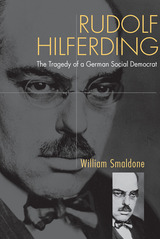 Rudolf Hilferding: The Tragedy of a German Social Democrat
William Smaldone
Northern Illinois University Press, 1998
Until his death in a Gestapo prison cell, Rudolf Hilferding was one of Europe's most prominent socialist theorists and politicians. A leading economic thinker in the European socialist movement and an important politician in the German Social Democratic Party, he served as Weimar finance minister at the height of the inflation of 1923 and again at the onset of the depression in 1928. At a time when Germany faced one economic and political crisis after another, he led social democracy's efforts to strengthen the republic and to achieve its socialist objectives.
This finely crafted intellectual biography illustrates how Hilferding's personal and intellectual journey reflected the failures of social democracy in its confrontation with nazism and communism. After Hitler came to power in 1933, Hilferding in exile continued the struggle against the Nazis. Caught in the maelstrom of the French defeat, in 1940 he was arrested by Vichy authorities and treacherously handed over to the Gestapo.
Throughout his eventful life Hilferding analyzed the central issues facing modern socialism, including the development of finance capitalism, the nature of imperialism, the path to socialism, and the organization of socialist parties. For Hilferding, democratic freedom was at the heart of the socialist project, and in rejecting the tyranny of both communism and fascism, he made important contributions to the debate on the nature of totalitarianism. His insights into Marxist theory adn practice are still vital for understanding the development of socialism in the twentieth century.
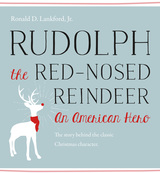 Rudolph the Red-Nosed Reindeer: An American Hero
Ronald D. Lankford
University Press of New England, 2016 Ronald D. Lankford has written the definitive history of this iconic and much-loved Christmas character. Rudolph the Red-Nosed Reindeer was the creation of Robert May, a staff copywriter who wrote the original poem as a Montgomery Ward Christmas giveaway in 1939. More than 2.4 million copies were printed and given away that holiday season. Thus the legend began. Johnny Marks adapted the poem into what would become the Gene Autry hit “Rudolph the Red-Nosed Reindeer,” which instantly became—and still remains—one of the most popular Christmas songs of all time. The legend of Rudolph soared even higher with the Rankin/Bass stop-motion television special in 1964, which has gone on to inspire a cottage industry of toys and decorative items. In this festive and informed look at the most famous reindeer of all, Lankford discusses all of Rudolph’s iterations, including comic books, sequels, advertising tie-ins, movies, and much more. Lankford has produced the first complete history of Rudolph that both celebrates and explains the undying popularity of Rudolph and his friends. The result is both a glowing tribute and a rigorously researched biography that will appeal to fans and lovers of classic American holiday culture.
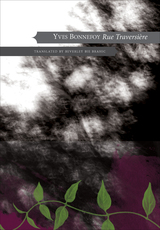 Rue Traversière
Yves Bonnefoy
Seagull Books, 1972 A beautiful collection of poems from various styles and genres by France's foremost poet, Yves Bonnefoy.
Praised by Paul Auster as “one of the rare poets in the history of literature to have sustained the highest level of artistic excellence throughout an entire lifetime,” Yves Bonnefoy is widely considered the foremost French poet of his generation. Proving that his prose is just as lyrical, Rue Traversière, written in 1977, is one of his most harmonious works. Each of the fifteen discrete or linked texts, whose lengths range from brief notations to long, intense, self-questioning pages, is a work of art in its own right: brief and richly suggestive as haiku, or long and intricately wrought in syntax and thought; and all are as rewarding in their sounds and rhythms, and their lightning flashes of insight, as any sonnet. “I can write all I like; I am also the person who looks at the map of the city of his childhood and doesn’t understand,” says the section that gives the book its title, as he revisits childhood cityscapes and explores the tricks memory plays on us.
A mixture of genres—the prose poem, the personal essay, quasi-philosophical reflections on time, memory, and art—this is a book of both epigrammatic concision and dreamlike narratives that meander with the poet’s thought as he struggles to understand and express some of the undercurrents of human life. The book’s layered texts echo and elaborate on one another, as well as on aspects of Bonnefoy’s own poetics and thought.
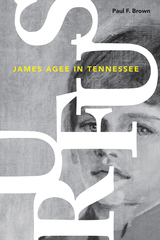 Rufus: James Agee in Tennessee
Paul F. Brown
University of Tennessee Press, 2018 One of the most gifted of America’s writers, James Rufus Agee (1909–1955), spent a third of his short life in Tennessee, yet no biographical treatment until this one has so fully explored his roots in the state. In Rufus, Paul F. Brown draws deeply on a trove of journals, letters, interviews, and contemporaneous newspaper accounts, to produce a captivating portrait of Agee’s boyhood.
Brown meticulously delineates Agee’s family history, his earliest years as a sensitive child growing up in Knoxville’s Fort Sanders neighborhood, and the traumatic event that marked his sixth year: his father’s death in an automobile accident. Young Rufus—as his family always called him—revered his father and would use his memories of the tragedy to create his most enduring work of fiction, the Pulitzer Prize–winning A Death in the Family. Just a few years after his father was killed, Agee’s mother placed him in the St. Andrew’s School for Mountain Boys near Sewanee, Tennessee, where he would meet his mentor and lifelong friend, Father James Flye; these experiences would inspire Agee’s poignant novella, The Morning Watch. Another year in Knoxville followed, and then his mother, newly remarried, whisked him away to New England, where he would complete his education at Phillips Exeter Academy and Harvard.
Brown’s account deftly reconstructs various settings the young Agee encountered—including not only turn-of-the-century Knoxville and St. Andrew’s but also the mountain hamlet of LaFollette, his father’s hometown—and the complex family relationships that swirled around the young writer-to-be. Brown also explores Knoxville’s belated discovery of its famous son, initiated when Hollywood came to town in 1962 to film All the Way Home, an adaptation of A Death in the Family. Notable commemorations—including academic seminars, a public park, and a street named in Agee’s honor—would come later as the writer’s posthumous reputation bloomed. And now, with Rufus, we have the definitive account of how it all began.
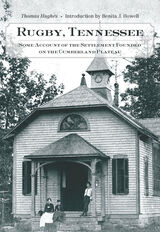 Rugby, Tennessee: Some Account of the Settlement Founded on the Cumberland Plateau
Thomas Hughes
University of Tennessee Press, 2008 Thomas Hughes was the author of the immensely popular Victorian novel Tom Brown's Schooldays, which was set in Rugby School, the well-known English "public school" that Hughes attended. In it, Hughes portrays the ideals of that school. Rugby created a generation of leaders with a sense of duty to their country; with a belief in the nobility of hard work, honor, and selflessness; and with a determination to work for the betterment of those less fortunate than themselves.
Hughes and many other "old boys" carried these values into their post-school lives in Victorian England. Thomas Hughes became an advocate for Britain's first labor unions and workingmen's colleges. He went on to serve in Parliament, and eventually planted his Christian Socialist ideals in the backwoods of Tennessee, where he established the utopian community named Rugby after his beloved alma mater.
In Rugby, Tennessee, Hughes describes the then-new community and his motivations in founding it. As Benita J. Howell points out in her lucid and informative new introduction, the book represents an important moment in late-Victorian English thought.
Hughes recounts the plight of England's "Will Wimbles," the underemployed second sons of the gentry, to whom he hoped to give a fresh start in Tennessee. Hughes also offers readers a vivid description of Tennessee's northern Cumberland Plateau, including natural landmarks that can still be seen. And his impressions of "Life in Tennessee," "The Natives," and "The Negro Natives" reveal much about the Upland South on the eve of industrialization. Written in part to convince British investors that their project in America was making great progress, Rugby, Tennessee, depicts a unique Utopian moment in this remote area of Appalachian Tennessee-a moment whose legacy is justly celebrated to this day.
Benita J. Howell is Professor of Anthropology Emerita at the University of
Tennessee. She is the author of Folklife along the Big South Fork of the
Cumberland River and is editor of Culture, Environment, and Conservation in the Appalachian South.
Rugged and Sublime: The Civil War in Arkansas
Mark Christ
University of Arkansas Press, 1994 When one thinks of the American Civil War, such names as Vicksburg, Gettysburg, and Chancellorsville come immediately to mind. Few recall the battles in the Trans-Mississippi theater. Rugged and Sublime goes a long way toward filling regrettable blanks in our memory of Arkansas’s role in Civil War. It explore the major clashes and locales of the war, including the state secession convention, seizure of the Little Rock Arsenal, the Battle of Wilson’s Creek, the Pea Ridge campaign, Marmaduke’s invasion of Missouri, the Battle of Helena, and the fall of Little Rock, as well as other actions. Rounding out this new and very readable account are studies of the devolution of Arkansas society when bands of guerillas and jayhawkers menaced the state, the surrender of the Confederate armies, and an assessment of losses.
Ruin
Beppe Fenoglio
Northwestern University Press, 1992 Ruin is an acclaimed 1954 novel by Italian Beppe Fenoglio. It's the story of Augustine Braida, a boy who serves the Rabino family, whose first-person account of life in Langhe paints a vivid portrait of early twentieth-century Italian peasant life. Told with terrible humility and great force, it is a compassionate and harrowing narrative of peasant endurance in the face of overwhelming hardship.
Born into a working-class family in the town of Alba lying in that part of the Piedmont called LeLanghe, Beppe Fenoglio (1922-1963) belonged to the generation of young Italian writers whose works were molded by their World War II experience and the anti-Fascist Resistance many took part in. Fenoglio fought as a partisan against the German troops occupying Italy, and the major part of his literature is connected with the events of the time.
Ruin and Restitution: Reinterpreting Romanticism in Spain
Philip W. Silver
Vanderbilt University Press, 1997 In this highly suggestive work, Philip Silver confronts and corrects the entire critical tradition on Spanish romanticism and suggests a new "restitutional" theory of that period in Spanish cultural and political history.
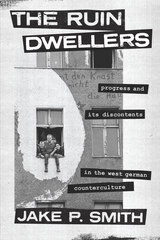 The Ruin Dwellers: Progress and Its Discontents in the West German Counterculture
Jake P. Smith
University of Chicago Press, 2025 Traces the shifting dynamics within leftist activism in 1970s and ’80s Europe and its experiments in art, life, and politics.
The Ruin Dwellers takes readers into the urban spaces of youth revolts during the 1970s and ’80s in West Germany and elsewhere in western and central Europe. Whereas earlier generations of leftist activists were primarily oriented toward the utopian future, participants in the youth movements of the 1970s and ’80s developed a more complex set of temporal practices that sought to scramble the borders between the past, present, and future.
Examining a rich corpus of radical texts and practices, historian Jake P. Smith shows that squatters and their leftist allies in this period engaged in social, cultural, and aesthetic experiments with modes of autonomous living. Smith brings to life the real and imagined landscapes conjured in squatted houses and street protests; in art, dress, music, graffiti, and film; and in philosophical, poetic, and political texts. In so doing, he offers an eye-opening look at anarchic world-making practices that found new ways of imagining an emancipated future through inhabiting the fractured past.
The Ruin of Kasch
Roberto Calasso
Harvard University Press, 1994 In this brilliant work, Roberto Calasso cracks the code of what Baudelaire named the Modern--the increasingly murderous period from the French Revolution to the end of World War II. From Talleyrand's France and the legendary African city of Kasch, to Lenin's Russia and the killing fields of Cambodia, Calasso leads us along an enticing maze of mythology, literature, art, and science to the pulsing heart of civilization, where he deciphers the deepest secrets of history.
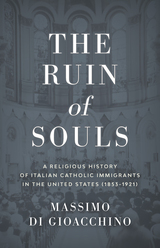 The Ruin of Souls: A Religious History of Italian Catholic Immigrants in the United States (1853-1921)
Massimo Di Gioacchino
Bridwell Press, 2025 The Ruin of Souls presents a new history of Italian Catholic life in the United States, from the founding of the first Italian Catholic church in the United States in 1853 to the end of the immigration flow as a result of the Emergency Quota Act of 1921. In this book, the product of wide research in American and Roman archives that spans the last twelve years, Di Gioacchino invites the reader to look at the religious history of the Italian Catholic immigrants in the United States not through the lens of their devotional culture, but through the perspective of their eccleasiastical life. More specifically, the book aims to document the efforts, problems, and failures of the Roman Catholic Church of the time to preserve the allegiance of the Italian immigrants in the United States to the Church’s magisterium and authority.
Strengthened by largely unknown archival documentation and an original historiographic methodology, the work reveals a new political dimension in the religious history of Italian immigrants in the United States and their relationship with the Catholic religious canon. By integrating the analysis of the ecclesial practices of the Italian communities into a far-reaching epistemological reflection, the work also contributes to the continuing discussion of how we study and examine the religious practices of Catholic communities in the modern era.
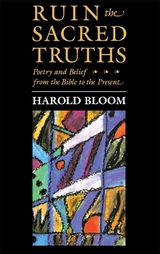 Ruin the Sacred Truths: Poetry and Belief from the Bible to the Present
Harold Bloom
Harvard University Press, 1989 “[Bloom] is the Satan of criticism...he is heroic even in those passages in which we are permitted to suspect that he may be a charlatan.”—Dennis Donoghue, New York Review of Books
The most prodigious literary mind of his generation on the transcendent acts of self-creation that define the Western canon, from the Torah to Samuel Beckett.
John Milton’s contemporary Andrew Marvell once confessed that reading Paradise Lost troubled his faith. Milton’s lyrical prowess was beyond doubt, but precisely because of his poetic genius Marvell feared “That he would ruin (for I saw him strong) / The sacred Truths to Fable and old Song.” If heaven, hell, and rebelling angels were reduced to fodder for the poet’s imagination, how could they remain objects of sincere religious belief?
In this fascinating series of lectures, delivered at Harvard in 1987–1988, Harold Bloom confirms Marvell’s worst fear: all serious poets, Bloom argues, must ruin the sacred truths, unraveling cherished beliefs and literary traditions to create a world in their own image. From the earliest source documents of the Torah, written by a hypothetical author called the Yahwist or simply “J,” to the heretical reinterpretations of Judaism in Freud, Kafka, and Gershom Scholem, Bloom shows us how great authors construct the new by destroying the old. In the process they wrest divinity from the hand of the deity: Milton’s Satan, infinitely more complex and compelling than his God, embodies the author’s pursuit of humanity and literary greatness against the strictures of received religion; Wordsworth, prophet of nature, “celebrates his own godhood”; and Shakespeare’s characters, as much as the Bible’s, establish a ubiquitous and inescapable framework for representing the human personality.
Brisk and impassioned, Ruin the Sacred Truths gives us Bloom in all his dimensions. Jewish Gnostic, reverent Freudian, and relentless proselytizer of the sublime, he was convinced, above all, that if salvation could be found anywhere, it would be in poetry.
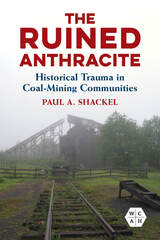 The Ruined Anthracite: Historical Trauma in Coal-Mining Communities
Paul A. Shackel
University of Illinois Press, 2023 Once a busy if impoverished center for the anthracite coal industry, northeastern Pennsylvania exists today as a region suffering inexorable decline--racked by economic hardship and rampant opioid abuse, abandoned by young people, and steeped in xenophobic fear. Paul A. Shackel merges analysis with oral history to document the devastating effects of a lifetime of structural violence on the people who have stayed behind. Heroic stories of workers facing the dangers of underground mining stand beside accounts of people living their lives in a toxic environment and battling deprivation and starvation by foraging, bartering, and relying on the good will of neighbors. As Shackel reveals the effects of these long-term traumas, he sheds light on people’s poor health and lack of well-being. The result is a valuable on-the-ground perspective that expands our understanding of the social fracturing, economic decay, and anger afflicting many communities across the United States. Insightful and dramatic, The Ruined Anthracite combines archaeology, documentary research, and oral history to render the ongoing human cost of environmental devastation and unchecked capitalism.
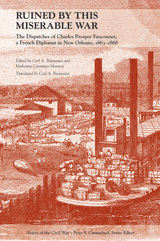 Ruined by This Miserable War: The Dispatches of Charles Prosper Fauconnet, a French Diplomat in New Orleans, 1863–1868
Carl A. Brasseaux
University of Tennessee Press, 2013 In March 1863, after Northern general Benjamin F. Butler demanded the recall of the French consul-general, an unabashed Confederate sympathizer, from Union-occupied New Orleans, Charles Prosper Fauconnet assumed the duties of acting consul. A seasoned diplomat who had risen slowly through the ranks in Latin America and the United States, Fauconnet quickly and effectively repaired the rift between local French and American authorities while striving valiantly to safeguard the interests of his government and the French nationals who found themselves literally and figuratively caught in the crossfire.
From 1863 through 1868, Fauconnet maintained a copybook of his official correspondence with the French Ministry of State. These confidential dispatches, collected for the first time in this valuable volume, provide not only a panoramic view of the Civil War and Reconstruction on the Gulf Coast but also new and important information on the transnational aspects of America’s Civil War.
Eager to explain complicated issues to a French government concerned over the fate of one of its former territories, Fauconnet painstakingly laid out what was happening in New Orleans by drawing on war news, newspaper columns, and summaries of speeches and promises of Union commanding officers. His commentary peeled away the layers of contradiction and moral dilemmas that confronted citizens of Southern, Northern, and French heritages during the war years and early postwar period. Among the topics he considered were whether emancipated slaves deserved the same rights as naturalized citizens, the state of the cotton market, and the harassment of French-speaking immigrants by both Union and Confederate authorities. Informative and detailed, Fauconnet’s communications became increasingly acerbic and uneasy as he documented and explained the Civil War to officials in his faraway homeland.
Breathtaking in its geographic scope and topical breadth, thanks in part to the acute observational and reporting skills of its author, Fauconnet’s correspondence offers a unique and thoroughly fascinating francophone perspective on New Orleans during some of the most tumultuous years in U.S. history.
CARL BRASSEAUX is the author of over thirty books related to the French presence in the Gulf Coast, including Refuge for All Ages: Immigration in Louisiana History; French Cajun, Creole, Houma: A Primer on Francophone Louisiana; and Stir the Pot: The History of Cajun Cuisine. Until his recent retirement, he was director of the Center for Louisiana Studies and professor of history at the University of Louisiana at Lafayette.
KATHERINE CARMINES MOONEY, a Ph.D. candidate at Yale University, is a specialist in nineteenth-century history. Her research includes the history of thoroughbred horse-racing culture from 1820 to 1910.
Ruining the Picture
Pimone Triplett
Northwestern University Press, 1998 In their unique blend of linguistic energy and stunning emotional conviction, Pimone Triplett's poems richly weave the strands of myth, culture, and history into a personal landscape of the imagination. Hers is a startling new voice in American poetry-surefooted on the page, with a dazzling richness of texture throughout.
"Pimone Triplett has a large discursive intelligenge, a keen lyric sensibility, a strong feeling for drama. . . . What an abiding pleasure to encounter a first book of such maturity." --Edward Hirsch
Ruins and Empire: The Evolution of a Theme in Augustan and Romantic Literature
Laurence Goldstein
University of Pittsburgh Press, 1977
One of the most common scenes in Augustan and Romantic literature is that of a writer confronting some emblem of change and loss, most often the remains of a vanished civilization or a desolate natural landscape. Ruins and Empire traces the ruin sentiment from its earliest classical and Renaissance expressions through English literature to its establishment as a dominant theme of early American art.
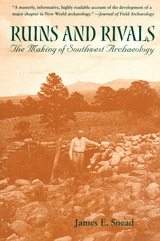 Ruins and Rivals: The Making of Southwest Archaeology
James E. Snead
University of Arizona Press, 2001 Published in cooperation with the William P. Clements Center for Southwest Studies, Southern Methodist University Ruins are as central to the image of the American Southwest as are its mountains and deserts, and antiquity is a key element of modern southwestern heritage. Yet prior to the mid-nineteenth century this rich legacy was largely unknown to the outside world. While military expeditions first brought word of enigmatic relics to the eastern United States, the new intellectual frontier was seized by archaeologists, who used the results of their southwestern explorations to build a foundation for the scientific study of the American past. In Ruins and Rivals, James Snead helps us understand the historical development of archaeology in the Southwest from the 1890s to the 1920s and its relationship with the popular conception of the region. He examines two major research traditions: expeditions dispatched from the major eastern museums and those supported by archaeological societies based in the Southwest itself. By comparing the projects of New York's American Museum of Natural History with those of the Southwest Museum in Los Angeles and the Santa Fe-based School of American Archaeology, he illustrates the way that competition for status and prestige shaped the way that archaeological remains were explored and interpreted. The decades-long competition between institutions and their advocates ultimately created an agenda for Southwest archaeology that has survived into modern times. Snead takes us back to the days when the field was populated by relic hunters and eastern "museum men" who formed uneasy alliances among themselves and with western boosters who used archaeology to advance their own causes. Richard Wetherill, Frederic Ward Putnam, Charles Lummis, and other colorful characters all promoted their own archaeological endeavors before an audience that included wealthy patrons, museum administrators, and other cultural figures. The resulting competition between scholarly and public interests shifted among museum halls, legislative chambers, and the drawing rooms of Victorian America but always returned to the enigmatic ruins of Chaco Canyon, Bandelier, and Mesa Verde. Ruins and Rivals contains a wealth of anecdotal material that conveys the flavor of digs and discoveries, scholars and scoundrels, tracing the origins of everything from national monuments to "Santa Fe Style." It rekindles the excitement of discovery, illustrating the role that archaeology played in creating the southwestern "past" and how that image of antiquity continues to exert its influence today.
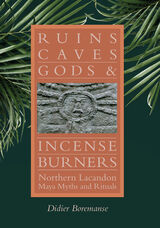 Ruins, Caves, Gods, and Incense Burners: Northern Lacandon Maya Myths and Rituals
Didier Boremanse
University of Utah Press, 2019 The Lacandon Maya are a small-scale forest society currently on the brink of extinction. Small groups of Northern Lacandon escaped evangelization by dispersing into the jungle, moving from the Guatemalan Petén to Chiapas in southern Mexico during the seventeenth, eighteenth, and nineteenth centuries. Several groups maintained their traditional religion until the late twentieth century.
Their cult of incense burners, based on the veneration of Maya ruins and funerary caves and the deities these effigy censers represented, remained free of any Christian influence. Some ceremonies were vestiges of more complex rituals believed to date back to pre-Columbian times. In this volume, Didier Boremanse explores Lacandon beliefs and traditions he observed during the many months of fieldwork he did, spanning four decades.
Throughout the book Boremanse makes Lacandon values and worldviews accessible to readers from western cultures. Rituals are described and explained with extracts of the celebrants’ prayers that were tape-recorded, transcribed, and translated. Other elements of religious oral tradition are included, including incantations, chants, and the myths and beliefs that sustain the rites. Boremanse also discusses how larger social change influences religious change, both through economic means and outside influences. Most of the myths retold in this book have never been published in English. Photographs show rites that are no longer performed and shrines that no longer exist.
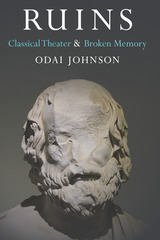 Ruins: Classical Theater and Broken Memory
Odai Johnson
University of Michigan Press, 2018 Much of the theater of antiquity is marked by erasures: missing origins, broken genres, fragments of plays, ruins of architecture, absented gods, remains of older practices imperfectly buried and ghosting through the civic productions that replaced them. Ruins: Classical Theater and Broken Memory traces the remains, the remembering, and the forgetting of performance traditions of classical theater. The book argues that it is only when we look back over the accumulation of small evidence over a thousand-year sweep of classical theater that the remarkable and unequaled endurance of the tradition emerges. In the absence of more evidence, Odai Johnson turns instead to the absence itself, pressing its most legible gaps into a narrative about scars, vanishings, erasures, and silence: all the breakages that constitute the ruins of antiquity. In ten wide-ranging case studies, theater history and performance theory are brought together to examine the texts, artifacts, and icons left behind, reading them in fresh ways to offer an elegantly written, extended meditation on “how the aesthetic of ruins offered a model for an ideal that dislodged and ultimately stood in for the historic.”
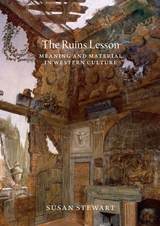 The Ruins Lesson: Meaning and Material in Western Culture
Susan Stewart
University of Chicago Press, 2019 How have ruins become so valued in Western culture and so central to our art and literature? Covering a vast chronological and geographical range, from ancient Egyptian inscriptions to twentieth-century memorials, Susan Stewart seeks to answer this question as she traces the appeal of ruins and ruins images, and the lessons that writers and artists have drawn from their haunting forms.
Stewart takes us on a sweeping journey through founding legends of broken covenants and original sin, the Christian appropriation of the classical past, and images of decay in early modern allegory. Stewart looks in depth at the works of Goethe, Piranesi, Blake, and Wordsworth, each of whom found in ruins a means of reinventing his art. Lively and engaging, The Ruins Lesson ultimately asks what can resist ruination—and finds in the self-transforming, ever-fleeting practices of language and thought a clue to what might truly endure.
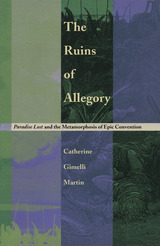 The Ruins of Allegory: Paradise Lost and the Metamorphosis of Epic Convention
Catherine Gimelli Martin
Duke University Press, 1998 In this reexamination of the allegorical dimensions of Paradise Lost, Catherine Martin presents Milton’s poem as a prophecy foretelling the end of one culture and its replacement by another. She argues that rather than merely extending the allegorical tradition as defined by Augustine, Dante, and Spenser, Milton has written a meta-allegory that stages a confrontation with an allegorical formalism that is either dead or no longer philosophically viable. By both critiquing and recasting the traditional form, Milton describes the transition to a new epoch that promises the possibility of human redemption in history.
Martin shows how Paradise Lost, written at the threshold of the enormous imaginative shift that accompanied the Protestant, scientific, and political revolutions of the seventeenth century, conforms to a prophetic baroque model of allegory similar to that outlined by Walter Benjamin. As she demonstrates, Milton’s experimentation with baroque forms radically reformulates classical epic, medieval romance, and Spenserian allegory to allow for both a naturalistic, empirically responsible understanding of the universe and for an infinite and incomprehensible God. In this way, the resulting poetic world of Paradise Lost is like Milton’s God, an allegorical “ruin” in which the divine is preserved but at the price of a loss of certainty. Also, as Martin suggests, the poem affirmatively anticipates modernity by placing the chief hope of human progress in the fully self-authored subject.
Maintaining a dialogue with a critical tradition that extends from Johnson and Coleridge to the best contemporary Milton scholarship, Martin sets Paradise Lost in both the early modern and the postmodern worlds. Ruins of Allegory will greatly interest all Milton scholars, as well as students of literary criticism and early modern studies.
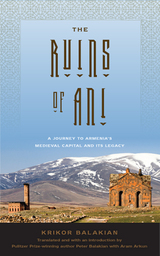 The Ruins of Ani: A Journey to Armenia's Medieval Capital and its Legacy
Krikor Balakian
Rutgers University Press, 2019 Winner of the 2019 Dr. Sona Aronian Book Prize for Excellence in Armenian Studies (NAASR)
From the tenth to the thirteenth centuries, the city of Ani was the jewel of the Armenian kingdom, renowned far and wide for its magnificent buildings. Known as the city of 1001 churches, Ani was a center for artistic innovation, and its architecture is a potential missing link between Byzantine and Gothic styles. By the fifteenth century, Ani was virtually abandoned, its stunning buildings left to crumble. Yet its ruins have remained a symbol of cultural accomplishment that looms large in the Armenian imagination.
The Ruins of Ani is a unique combination of history, art criticism, and travel memoir that takes readers on a thousand-year journey in search of past splendors. Today, Ani is a popular tourist site in Turkey, but the city has been falsified in its presentation by the Turkish government in order to erase Armenian history in the wake of the Armenian Genocide. This timely publication also raises questions about the preservation of major historic monuments in the face of post atrocity campaigns of cultural erasure.
Originally written by young priest Krikor Balakian in 1910, just a few years before the Armenian genocide, this book offers a powerful and poignant counterpart to Balakian’s acclaimed genocide memoir Armenian Golgotha. This new translation by the author’s great-nephew, Pulitzer Prize-winning poet Peter Balakian, eloquently renders the book’s vivid descriptions and lyrical prose into English. Including a new introduction that explores Ani’s continued relevance in the twenty-first century, The Ruins of Ani will give readers a new appreciation for this lost city’s status as a pinnacle of both Armenian civilization and human achievement.
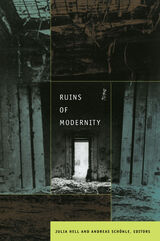 Ruins of Modernity
Julia Hell and Andreas Schönle, eds.
Duke University Press, 2009 Images of ruins may represent the raw realities created by bombs, natural disasters, or factory closings, but the way we see and understand ruins is not raw or unmediated. Rather, looking at ruins, writing about them, and representing them are acts framed by a long tradition. This unique interdisciplinary collection traces discourses about and representations of ruins from a richly contextualized perspective. In the introduction, Julia Hell and Andreas Schönle discuss how European modernity emerged partly through a confrontation with the ruins of the premodern past. Several contributors discuss ideas about ruins developed by philosophers such as Immanuel Kant, Georg Simmel, and Walter Benjamin. One contributor examines how W. G. Sebald’s novel The Rings of Saturn betrays the ruins erased or forgotten in the Hegelian philosophy of history. Another analyzes the repressed specter of being bombed out of existence that underpins post-Second World War modernist architecture, especially Le Corbusier’s plans for Paris. Still another compares the ways that formerly dominant white populations relate to urban-industrial ruins in Detroit and to colonial ruins in Namibia. Other topics include atomic ruins at a Nevada test site, the connection between the cinema and ruins, the various narratives that have accrued around the Inca ruin of Vilcashuamán, Tolstoy’s response in War and Peace to the destruction of Moscow in the fire of 1812, the Nazis’ obsession with imperial ruins, and the emergence in Mumbai of a new “kinetic city” on what some might consider the ruins of a modernist city. By focusing on the concept of ruin, this collection sheds new light on modernity and its vast ramifications and complexities. Contributors. Kerstin Barndt, Jon Beasley-Murray, Russell A. Berman, Jonathan Bolton, Svetlana Boym, Amir Eshel, Julia Hell, Daniel Herwitz, Andreas Huyssen, Rahul Mehrotra, Johannes von Moltke, Vladimir Paperny, Helen Petrovsky, Todd Presner, Helmut Puff, Alexander Regier, Eric Rentschler, Lucia Saks, Andreas Schönle, Tatiana Smoliarova, George Steinmetz, Jonathan Veitch, Gustavo Verdesio, Anthony Vidler
 The Ruins of the New Argentina: Peronism and the Remaking of San Juan after the 1944 Earthquake
Mark A. Healey
Duke University Press, 2011 In January 1944, an earthquake reduced the province of San Juan, Argentina, to rubble, leaving perhaps ten thousand dead and one hundred thousand homeless. In The Ruins of the New Argentina, Mark A. Healey argues that the disaster and the massive rebuilding project that followed transformed not only the province but also the nation. The earthquake was a shattering and galvanizing experience, an indictment of the old social order and an invitation to transform it. From the nation’s capital, an obscure colonel in a recently installed military regime launched a relief campaign and rapidly commissioned plans to rebuild the province, especially its capital city. The campaign was a rousing success, launching the public career of its director, Juan Domingo Perón, who would soon found a movement, reach the presidency, and transform the politics and social structure of the country. Dreaming and building the new city became the landmark project for a generation of modernist architects and planners, as well as an enduring challenge and controversy for local residents and the Peronist state. By exploring the struggle to rebuild, Healey shows how this destroyed province played a crucial role in forging, testing, and ultimately limiting the Peronist project of transforming the nation.
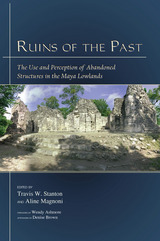 Ruins of the Past: The Use and Perception of Abandoned Structures in the Maya Lowlands
Travis W. Stanton
University Press of Colorado, 2008 From the Preclassic to the present, Maya peoples have continuously built, altered, abandoned, and re-used structures, imbuing them with new meanings at each transformation. Ruins of the Past is the first volume to focus on how previously built structures in the Maya Lowlands were used and perceived by later peoples, exploring the topic through concepts of landscape, place, and memory. The collection, as Wendy Ashmore points out in her foreword, offers "a stimulating, productive, and fresh set of inferences about ancient Maya cognition of their own past." Contributors include Anthony P. Andrews, Ana Lucía Arroyave Prera, Antonio Benavides C., M. Kathryn Brown, Marcello A. Canuto, Mark B. Child, David A. Freidel, James F. Garber, Charles W. Golden, Stanley P. Guenter, Jon B. Hageman, Richard D. Hansen, Brett A. Houk, Wayne K. Howell, Paul Hughbanks, Scott R. Hutson, Aline Magnoni, T. Kam Manahan, Olivia C. Navarro Farr, Travis W. Stanton, Lauren A. Sullivan, and Fred Valdez Jr.
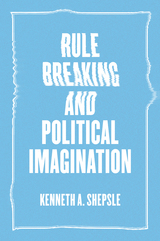 Rule Breaking and Political Imagination
Kenneth A. Shepsle
University of Chicago Press, 2017 “Imagination may be thought of as a ‘work-around.’ It is a resourceful tactic to ‘undo’ a rule by creating a path around it without necessarily defying it. . . . Transgression, on the other hand, is rule breaking. There is no pretense of reinterpretation; it is defiance pure and simple. Whether imagination or disobedience is the source, constraints need not constrain, ties need not bind.”
So writes Kenneth A. Shepsle in his introduction to Rule Breaking and Political Imagination. Institutions are thought to channel the choices of individual actors. But what about when they do not? Throughout history, leaders and politicians have used imagination and transgression to break with constraints upon their agency. Shepsle ranges from ancient Rome to the United States Senate, and from Lyndon B. Johnson to the British House of Commons. He also explores rule breaking in less formal contexts, such as vigilantism in the Old West and the CIA’s actions in the wake of 9/11. Entertaining and thought-provoking, Rule Breaking and Political Imagination will prompt a reassessment of the nature of institutions and remind us of the critical role of political mavericks.
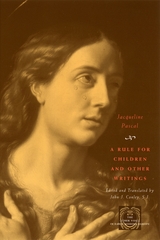 A Rule for Children and Other Writings
Jacqueline Pascal
University of Chicago Press, 2003 Jacqueline Pascal (1625-1661) was the sister of Blaise Pascal and a nun at the Jansenist Port-Royal convent in France. She was also a prolific writer who argued for the spiritual rights of women and the right of conscientious objection to royal, ecclesiastic, and family authority.
This book presents selections from the whole of Pascal's career as a writer, including her witty adolescent poetry and her pioneering treatise on the education of women, A Rule for Children, which drew on her experiences as schoolmistress at Port-Royal. Readers will also find Pascal's devotional treatise, which matched each moment in Christ's Passion with a corresponding virtue that his female disciples should cultivate; a transcript of her interrogation by church authorities, in which she defended the controversial theological doctrines taught at Port-Royal; a biographical sketch of her abbess, which presented Pascal's conception of the ideal nun; and a selection of letters offering spirited defenses of Pascal's right to practice her vocation, regardless of patriarchal objections.
 The Rule of Art: Literature and Painting in the Renaissance
Clark Hulse
University of Chicago Press, 1990 What do Renaissance poetry and painting have in common? What are the social, ideological, and aesthetic bases for the links between them? And what role do those links play in creating the humanistic culture that still has power over us today?
These are the questions Clark Hulse takes up in this sophisticated interdisciplinary study of Renaissance aesthetics. Proposing an archeology of artistic knowledge, Hulse examines the theoretical language through which the poets, painters, and patrons of the Renaissance conceived of the relationship between the arts. That language is embedded in what he calls a "rule of art," a specific set of categories, assumptions, and practices that defined the two art forms and the relationship between them. Hulse charts the rise of both forms to the status of liberal arts requiring special intellectual training for artist and patron alike. In the process, he uncovers the history of the practice of theory in the Renaissance, revealing how artistic discourse lived in the world.
 The Rule of Dons: Criminal Leaders and Political Authority in Urban Jamaica
Rivke Jaffe
Duke University Press, 2024 Throughout Kingston, Jamaica, figures known as “dons” exercise political authority and are seen as legitimate leaders despite their associations with crime and violence. In the absence of strong government support, they provide impoverished residents with access to security, conflict resolution, and various forms of welfare through their own resources and connections to Jamaica’s political parties. In The Rule of Dons, Rivke Jaffe shows how dons’ power relies on a widespread belief in their right to rule, explaining how criminal power is legitimized through a set of aesthetic, affective, and spatial mechanisms. She argues that dons must credibly embody an outlaw persona that stands outside of the political establishment while also connecting strategically to state institutions and mobilizing democratic ideals such as freedom and equality. As such, dons represent a form of authority that involves balancing an autocratic form of rule with an established democratic order. While donmanship represents a historically and culturally specific type of political authority, Jaffe’s analysis of this phenomenon offers insights into the entanglement of violent autocratic rule and democratic institutions far beyond Jamaica.
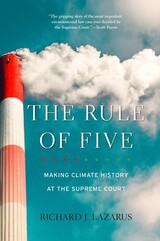 The Rule of Five: Making Climate History at the Supreme Court
Richard J. Lazarus
Harvard University Press, 2020 Winner of the Julia Ward Howe Prize
“The gripping story of the most important environmental law case ever decided by the Supreme Court.”
—Scott Turow
“In the tradition of A Civil Action, this book makes a compelling story of the court fight that paved the way for regulating the emissions now overheating the planet. It offers a poignant reminder of how far we’ve come—and how far we still must go.”
—Bill McKibben, author of The End of Nature
On an unseasonably warm October morning, an idealistic young lawyer working on a shoestring budget for an environmental organization no one had heard of hand-delivered a petition to the Environmental Protection Agency, asking it to restrict greenhouse gas emissions from new cars. The Clean Air Act authorized the EPA to regulate “any air pollutant” thought to endanger public health. But could carbon dioxide really be considered a harmful pollutant? And even if the EPA had the authority to regulate emissions, could it be forced to do so?
The Rule of Five tells the dramatic story of how Joe Mendelson and the band of lawyers who joined him carried his case all the way to the Supreme Court. It reveals how accident, infighting, luck, superb lawyering, politics, and the arcane practices of the Supreme Court collided to produce a legal miracle. The final ruling in Massachusetts v. EPA, by a razor-thin 5–4 margin brilliantly crafted by Justice John Paul Stevens, paved the way to important environmental safeguards which the Trump administration fought hard to unravel and many now seek to expand.
“There’s no better book if you want to understand the past, present, and future of environmental litigation.”
—Elizabeth Kolbert, author of The Sixth Extinction
“A riveting story, beautifully told.”
—Foreign Affairs
“Wonderful…A master class in how the Supreme Court works and, more broadly, how major cases navigate through the legal system.”
—Science
The Rule of Law in Latin America: The International Promotion of Judicial Reform
Edited by Pilar Domingo and Rachel Sieder
University of London Press, 2001 This volume analyzes the judicial reform processes funded by international donor organizations in Latin America. As billions of dollars are spent on judicial reform, it is pertinent to ask about the fate of these projects. The authors examine the way in which international organizations rationalize and prioritize their reform proposals and agenda in Latin America; how reform agendas are implemented and followed up (or not); how international donor organizations relate to national governments and civil society, and to each other; and what factors account for the successes and failures of their reform initiatives. The book also addresses the question of the connection between rule of law reform and broader processes of regime consolidation and state building, from both a political and a social perspective.
 A Rule of Property for Bengal: An Essay on the Idea of Permanent Settlement
Ranajit Guha
Duke University Press, 1996 A Rule of Property for Bengal is a classic work on the history of colonial India. First published in 1963, and long unavailable in this country, it is an essential text in the areas of colonial and postcolonial studies. In this book, Ranajit Guha examines the British establishment of the Permanent Settlement of Bengal—the first major administrative intervention by the British in the region and an effort to impose a western notion of private property on the Bengal countryside. Guha’s study of the intellectual origins, goals, and implementation of this policy provides an in-depth view of the dynamics of colonialism and reflects on the lasting effect of that dynamic following the formal termination of colonial rule.
By proclaiming the Permanent Settlement in 1793, the British hoped to promote a prosperous capitalist agriculture of the kind that had developed in England. The act renounced for all time the state’s right to raise the assessment already made upon landowners and thus sought to establish a system of property that was, in the British view, necessary for the creation of a stable government. Guha traces the origins of the Permanent Settlement to the anti-feudal ideas of Phillip Francis and the critique of feudalism provided by physiocratic thought, the precursor of political economy. The central question the book asks is how the Permanent Settlement, founded in anti-feudalism and grafted onto India by the most advanced capitalist power of the day became instrumental in the development of a neo-feudal organization of landed property and in the absorption and reproduction of precapitalist elements in a colonial regime.
Guha’s examination of the British attempt to mold Bengal to the contours of its own society without an understanding of the traditions and obligations upon which the Indian agrarian system was based is a truly pioneering work. The implications of A Rule of Property for Bengal remain rich for the current discussions from the postcolonialist perspective on the meaning of modernity and enlightenment.
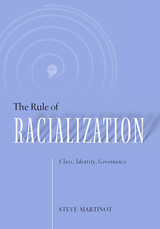 Rule Of Racialization: Class, Identity, Governance
Steve Martinot
Temple University Press, 2002 An important history of the way class formed in the US, The Rule of Racialization offers a rich new look at the invention of whiteness and how the inextricable links between race and class were formed in the seventeenth century and consolidated by custom, social relations, and eventually naturalized by the structures that organize our lives and our work.Arguing that, unlike in Europe, where class formed around the nation-state, race deeply informed how class is defined in this country and, conversely, our unique relationship to class in this country helped in some ways to invent race as a distinction in social relations. Martinot begins tracing this development in the slave plantations in 1600s colonial life. He examines how the social structures encoded there lead to a concrete development of racialization. He then takes us up to the present day, where forms of those structures still inhabit our public and economic institutions. Throughout, he engages historical and contemporary thinkers on the nature of race in the US, creating a book that at once synthesizes significant critiques of race while at the same time offers a completely original conception of how race and class have operated in American life throughout the centuries.A uniquely compelling book, The Rule of Racialization offers a rich contribution to the study of class, labor, and American social relations.
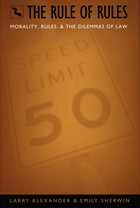 The Rule of Rules: Morality, Rules, and the Dilemmas of Law
Larry Alexander and Emily Sherwin
Duke University Press, 2001 Rules perform a moral function by restating moral principles in concrete terms, so as to reduce the uncertainty, error, and controversy that result when individuals follow their own unconstrained moral judgment. Although reason dictates that we must follow rules to avoid destructive error and controversy, rules—and hence laws—are imperfect, and reason also dictates that we ought not follow them when we believe they produce the wrong result in a particular case. In The Rule of Rules Larry Alexander and Emily Sherwin examine this dilemma.
Once the importance of this moral and practical conflict is acknowledged, the authors argue, authoritative rules become the central problems of jurisprudence. The inevitable gap between rules and background morality cannot be bridged, they claim, although many contemporary jurisprudential schools of thought are misguided attempts to do so. Alexander and Sherwin work through this dilemma, which lies at the heart of such ongoing jurisprudential controversies as how judges should reason in deciding cases, what effect should be given to legal precedent, and what status, if any, should be accorded to “legal principles.” In the end, their rigorous discussion sheds light on such topics as the nature of interpretation, the ancient dispute among legal theorists over natural law versus positivism, the obligation to obey law, constitutionalism, and the relation between law and coercion.
Those interested in jurisprudence, legal theory, and political philosophy will benefit from the edifying discussion in The Rule of Rules.
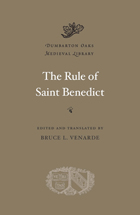 The Rule of Saint Benedict
Benedict of Nursia
Harvard University Press, 2011 One of the most influential texts in the Middle Ages, The Rule of Saint Benedict offers guidance about both the spiritual and organizational dimensions, from the loftiest to the lowliest, of monastic life. This new Latin-English edition has features of interest for first-time readers of the Rule as well as for scholars of medieval history and language.
The Latin text is a transcription of manuscript 914 of the Abbey of St. Gall (Switzerland), an early ninth-century copy regarded as the version that most closely reproduces Benedict's style. The saint’s idiom was informal, sometimes conversational, and heavily influenced by the spoken Latin of the sixth century CE. In the Rule his voice and thought processes come through in all their strength and humanity. Readers will find background to the monastic life in the notes. This volume also includes texts and translations of two letters that explain the origins of the St. Gall version as well as an index to all the translated materials.
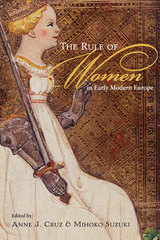 The Rule of Women in Early Modern Europe
Edited by Anne J. Cruz and Mihoko Suzuki
University of Illinois Press, 2008 This collection brings a transcultural and transnational perspective to the study of early modern women rulers and female sovereignty, a topic that has until now been examined through the lens of a single nation. Contributors to the volume juxtapose rulers from different countries, including well-known sovereigns such as Isabel of Castile and Elizabeth Tudor, as well as other less widely studied figures Isabeau of Bavaria, Jeanne d'Albret, Isabel Clara Eugenia, Juana of Austria, and Catherine of Brandenburg. Several essays also focus on the representations of foreign rulers such as Catherine de' Medici in England and Elizabeth I in France. Drawing on early modern literature and historical documents, this study investigates the various political, discursive, and symbolic measures employed to negotiate and support female sovereignty by both early modern writers and the rulers themselves. The detailed analysis of the women's responses--or inability to respond--to these strictures underscores the relationship between early modern authors and sovereigns and the complex and vexed situation of European women rulers. Contributors are Tracy Adams, Anne J. Cruz, Éva Deák, Mary C. Ekman, Catherine L. Howey, Elizabeth Ketner, Carole Levin, Sandra Logan, Magdalena S. Sánchez, Mihoko Suzuki, and Barbara F. Weissberger.
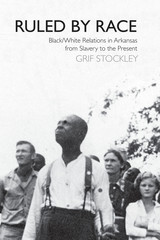 Ruled by Race: Black/White Relations in Arkansas From Slavery to the Present
Grif Stockley
University of Arkansas Press, 2008 Winner of the 2010 Booker Worthen Literary Prize, and the 2009 Ragsdale Award. From the Civil War to Reconstruction, the Redeemer period, Jim Crow, and the modern civil rights era to the present, Ruled by Race describes the ways that race has been at the center of much of the state’s formation and image since its founding. Grif Stockley uses the work of published and unpublished historians and exhaustive primary source materials along with stories from authors as diverse as Maya Angelou and E. Lynn Harris to bring to life the voices of those who have both studied and lived the racial experience in Arkansas. Topics range from the well-known Little Rock Central High Crisis of 1957 to lesser-known events such as the Elaine Race Massacres of 1919 and the shocking yet sadly commonplace attitudes found in newspaper reports and speeches. Through the words of the most powerful Arkansans such as racist Arkansas Govenor Jeff Davis (1901–1906) to the least powerful, including an unflinching look at the narratives of former slaves, readers will come away with increased awareness of the ways that race continues to affect where Arkansans live, send their children to school, work, travel, shop, spend leisure time, worship, and choose their friends and life partners.
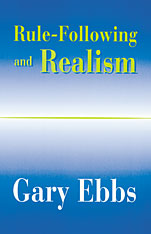 Rule-Following and Realism
Gary Ebbs
Harvard University Press, 1997 Through detailed and trenchant criticism of standard interpretations of some of the key arguments in analytical philosophy over the last sixty years, this book arrives at a new conception of the proper starting point and task of the philosophy of language.
To understand central topics in the philosophy of language and mind, Gary Ebbs contends, we must investigate them from our perspective as participants in shared linguistic practices; but our efforts at adopting this participant perspective are limited by our lingering loyalties to metaphysical realism (the view that we can make objective assertions only if we can grasp metaphysically independent truth conditions) and scientific naturalism (the view that it is only within science that reality can be identified and described). In Rule-Following and Realism, Ebbs works to loosen the hold of these views by exposing their roots and developing a different way of looking at our linguistic practices.
Reexamining and extending influential arguments by Saul Kripke, W. V. Quine, Rudolf Carnap, Hilary Putnam, and Tyler Burge, Ebbs presents systematic redescriptions of our linguistic practices that transform our understanding of such central topics as rule-following, the analytic-synthetic distinction, realism, anti-individualism, the division of linguistic labor, self-knowledge, and skepticism.
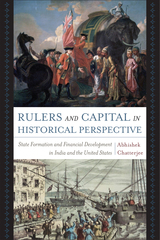 Rulers and Capital in Historical Perspective: State Formation and Financial Development in India and the United States
Abhishek Chatterjee
Temple University Press, 2017 Rulers and Capital in Historical Perspective explains why modern banking and credit systems emerged in the nineteenth century only in certain countries that then subsequently industrialized and became developed. Tracing the contemporaneous cases of India and the United States over time, Abhishek Chatterjee identifies the factors that were crucial to the development and regulation of a modern banking and credit system in the United States during the first third of the nineteenth century. He contrasts this situation with India’s, where the state never formally incorporated a sophisticated private credit system, and thus relegated it to the sphere of the informal economy. Chatterjee identifies certain features in both societies, often—though not always—associated with colonialism, that tended to restrict the formation of modern institutionalized money and credit markets. Rulers and Capital in Historical Perspective demonstrates thatnotwithstanding the many other differences between the North American colonies (prior to independence), and India, the same facets of their relationships with Great Britain prevented the emergence of a modern banking system in the two respective societies.
 Rulers and Victims: The Russians in the Soviet Union
Geoffrey Hosking
Harvard University Press, 2009 Many westerners used to call the Soviet Union "Russia." Russians too regarded it as their country, but that did not mean they were entirely happy with it. In the end, in fact, Russia actually destroyed the Soviet Union. How did this happen, and what kind of Russia emerged?
In this illuminating book, Geoffrey Hosking explores what the Soviet experience meant for Russians. One of the keys lies in messianism--the idea rooted in Russian Orthodoxy that the Russians were a "chosen people." The communists reshaped this notion into messianic socialism, in which the Soviet order would lead the world in a new direction. Neither vision, however, fit the "community spirit" of the Russian people, and the resulting clash defined the Soviet world.
Hosking analyzes how the Soviet state molded Russian identity, beginning with the impact of the Bolshevik Revolution and civil war. He discusses the severe dislocations resulting from collectivization and industrialization; the relationship between ethnic Russians and other Soviet peoples; the dramatic effects of World War II on ideas of homeland and patriotism; the separation of "Russian" and "Soviet" culture; leadership and the cult of personality; and the importance of technology in the Soviet world view.
At the heart of this penetrating work is the fundamental question of what happens to a people who place their nationhood at the service of empire. There is no surer guide than Geoffrey Hosking to reveal the historical forces forging Russian identity in the post-communist world.
 Rulers, Guns, and Money: The Global Arms Trade in the Age of Imperialism
Jonathan A. Grant
Harvard University Press, 2007 The explosion of the industrial revolution and the rise of imperialism in the second half of the nineteenth century served to dramatically increase the supply and demand for weapons on a global scale. No longer could arms manufacturers in industrialized nations subsist by supplying their own states' arsenals, causing them to seek markets beyond their own borders.
Challenging the traditional view of arms dealers as agents of their own countries, Jonathan Grant asserts that these firms pursued their own economic interests while convincing their homeland governments that weapons sales delivered national prestige and could influence foreign countries. Industrial and banking interests often worked counter to diplomatic interests as arms sales could potentially provide nonindustrial states with the means to resist imperialism or pursue their own imperial ambitions. It was not mere coincidence that the only African country not conquered by Europeans, Ethiopia, purchased weapons from Italy prior to an attempted Italian invasion.
From the rise of Remington and Winchester during the American Civil War, to the German firm Krupp's negotiations with the Russian government, to an intense military modernization contest between Chile and Argentina, Grant vividly chronicles how an arms trade led to an all-out arms race, and ultimately to war.
Rules and Precepts of the Jesuit Missions of Northwestern New Spain
Charles W. Polzer
University of Arizona Press, 1976 An exceptionally valuable research tool for scholars. The noted Jesuit historian has translated the rules and precepts that governed the mission expansion in the 1600s and 1700s in northwestern Mexico, and has added authoritative commentary to make this work literally a "manual on the missions."
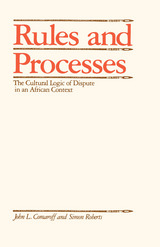 Rules and Processes
John L. Comaroff and Simon Roberts
University of Chicago Press, 1986 Rules and Processes is at once a compelling essay in social theory and a pathbreaking ethnography of dispute in an African society. On the basis of a sensitive study of the Tswana of southern Africa, John Comaroff and Simon Roberts challenge most of the orthodoxies of legal anthropology. They argue that the social world, and the dispute processes that occur within it, are given form and meaning by a dialectical relationship between sociocultural structures and individual experience. The authors explore in a novel way the relations between culture and ideology, system and practice, social action and human intention. They develop a model that lays bare the form and content of "legal" and "political" discourse in all its variations—a model that accounts for the outcome of conflict processes and explains why the Tswana, like people in other cultures, conceive of their world in an apparently contradictory manner—as rule-governed yet inherently open to pragmatic individualism; orderly yet inherently fluid and shifting. Rules and Processes offers a fresh and persuasive approach to our understanding of the dialectics of social life.
"A work of impressive scholarship in which theoretical sophistication and ethnographic richness are convincingly matched."—Ian Hamnett, Times Higher Education Supplement.
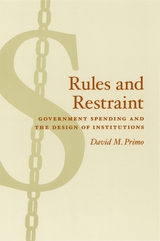 Rules and Restraint: Government Spending and the Design of Institutions
David M. Primo
University of Chicago Press, 2007 Government spending has increased dramatically in the United States since World War II despite the many rules intended to rein in the insatiable appetite for tax revenue most politicians seem to share. Drawing on examples from the federal and state governments, Rules and Restraint explains in lucid, nontechnical prose why these budget rules tend to fail, and proposes original alternatives for imposing much-needed fiscal discipline on our legislators.
One reason budget rules are ineffective, David Primo shows, is that politicians often create and preserve loopholes to protect programs that benefit their constituents. Another reason is that legislators must enforce their own provisions, an arrangement that is seriously compromised by their unwillingness to abide by rules that demand short-term sacrifices for the sake of long-term gain. Convinced that budget rules enacted through such a flawed legislative process are unlikely to work, Primo ultimately calls for a careful debate over the advantages and drawbacks of a constitutional convention initiated by the states—a radical step that would bypass Congress to create a path toward change. Rules and Restraint will be required reading for anyone interested in institutional design, legislatures, and policymaking.
Rules, Games, and Common-Pool Resources
Elinor Ostrom, Roy Gardner, and James Walker
University of Michigan Press, 1994 Explores ways that the tragedy of the commons can be avoided by people who use common-property resources
The Rules of Association Football, 1863
The Bodleian Library
Bodleian Library Publishing, 2006 In 1863 a group of Victorian Oxbridge graduates, frustrated by the confusing riot of competing rules that characterized the game of British football, began meeting at the Freemason’s Tavern in Lincoln’s Inn Fields, London, to codify the rules of the game. They quickly drew up the standard set of rules, creating the First Rule Book of the Football Association, reprinted here in its entirety alongside illustrations and drawings of the game.
Rules of Descent: Studies in the Sociology of Parentage
Guy E. Swanson
University of Michigan Press, 1969 In this study, author Guy E. Swanson examines the rules of descent as they relate to regime, socialization, and social control. Using data from many different societies, he discusses the relationship of patriliny, matriliny, and bilaterality with economic and social structures.
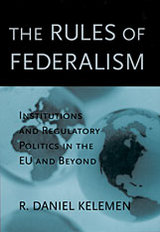 The Rules of Federalism: Institutions and Regulatory Politics in the EU and Beyond
R. Daniel Kelemen
Harvard University Press, 2004 This book examines patterns of environmental regulation in the European Union and four federal polities--the United States, Germany, Australia, and Canada. Daniel Kelemen develops a theory of regulatory federalism based on his comparative study, arguing that the greater the fragmentation of power at the federal level, the less discretion is allotted to component states. Kelemen's analysis offers a novel perspective on the EU and demonstrates that the EU already acts as a federal polity in the regulatory arena.
In The Rules of Federalism, Kelemen shows that both the structure of the EU's institutions and the control these institutions exert over member states closely resemble the American federal system, with its separation of powers, large number of veto points, and highly detailed, judicially enforceable legislation. In the EU, as in the United States, a high degree of fragmentation in the central government yields a low degree of discretion for member states when it comes to implementing regulatory statutes.
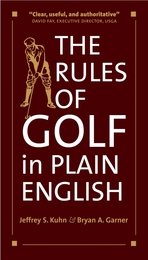 The Rules of Golf in Plain English
Jeffrey S. Kuhn and Bryan A. Garner
University of Chicago Press, 2004 "The cry for the simplification of the Rules of Golf is a stock-in-trade of the journalist during the winter months. Countless words on the subject have been poured out to an ever-tolerant public, but still the long-sought simplification does not come."—Henry Longhurst, 1937
The hopes of renowned writer and golfer Henry Longhurst—and millions of golfers before and after him—have finally been realized. In The Rules of Golf in Plain English, Bryan A. Garner, American English language and usage expert, and Jeffrey S. Kuhn, volunteer USGA rules official, have translated the knotty Rules with the encouragement and permission of the United States Golf Association. The result is a modern, readable version that offers, for the first time, clear guidance to both amateurs and professionals.
Based on a 338-word set of thirteen rules written in 1744, the official Rules have grown, over two and a half centuries, to 40,000 words. Numerous contributors and a complex revision process have rendered these Rules so opaque and stylistically inconsistent that a companion volume—the 600-page Decisions on the Rules of Golf—has been published to help golfers navigate them.
Both lawyers and avid golfers, Kuhn and Garner recognized the difficulties that the language of the Rules of Golf created, especially in a sport that expects players to call penalties on themselves. By reworking the Rules line by line, word by word, they have produced an accessible resource that no golfer—from the duffer to the pro—should be without.
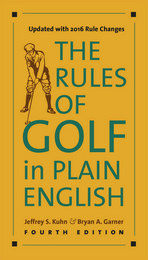 The Rules of Golf in Plain English, Fourth Edition
Jeffrey S. Kuhn and Bryan A. Garner
University of Chicago Press, 2016 The earliest standards for the game of golf included just 338 words and thirteen rules, which included what to do if your ball had the misfortune of falling into “watery filth” and how to proceed if your ball was stopped by a horse. The official Rules of Golf have since grown to more than 40,000 words and cover everything from marking a scorecard to determining whether a club has the appropriate roughness.
Two hundred years of revisions have rendered these Rules opaque and stylistically inconsistent. Those intricacies can be intimidating for anyone hoping to pick up the game and frustrating for longtime players who just want to settle a dispute. Both lawyers and avid golfers, Jeffrey S. Kuhn and Bryan A. Garner recognized the difficulties that the language of the Rules of Golf has created, especially in a sport that expects players to call penalties on themselves. By reworking the Rules line by line, word by word, they have produced an accessible resource that no golfer—from the duffer to the pro—should be without.
This new edition of The Rules of Golf in Plain English is fully aligned with the latest United States Golf Association updates and continues to be published with their permission and encouragement. Clear and concise, this reference will allow players to spend more time playing through and less time scratching their heads.
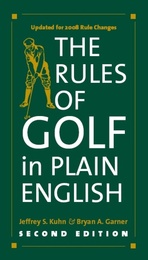 The Rules of Golf in Plain English, Second Edition
Jeffrey S. Kuhn and Bryan A. Garner
University of Chicago Press, 2008 "The cry for the simplification of the Rules of Golf is a stock-in-trade of the journalist during the winter months. Countless words on the subject have been poured out to an ever-tolerant public, but still the long-sought simplification does not come."—Henry Longhurst, 1937
The hopes of renowned writer and golfer Henry Longhurst—and millions of golfers before and after him—have finally been realized. In The Rules of Golf in Plain English, Bryan A. Garner, American English language and usage expert, and Jeffrey S. Kuhn, volunteer USGA rules official, have translated the knotty Rules with the encouragement and permission of the United States Golf Association. The result is a modern, readable version that offers, for the first time, clear guidance to both amateurs and professionals.
Based on a 338-word set of thirteen rules written in 1744, the official Rules have grown, over two and a half centuries, to 40,000 words. Numerous contributors and a complex revision process have rendered these Rules so opaque and stylistically inconsistent that a companion volume—the 600-page Decisions on the Rules of Golf—has been published to help golfers navigate them.
Both lawyers and avid golfers, Kuhn and Garner recognized the difficulties that the language of the Rules of Golf created, especially in a sport that expects players to call penalties on themselves. By reworking the Rules line by line, word by word, they have produced an accessible resource that no golfer—from the duffer to the pro—should be without.
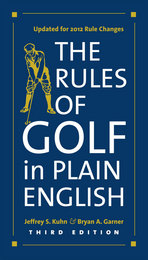 The Rules of Golf in Plain English, Third Edition
Jeffrey S. Kuhn and Bryan A. Garner
University of Chicago Press, 2012 "The cry for the simplification of the Rules of Golf is a stock-in-trade of the journalist during the winter months. Countless words on the subject have been poured out to an ever-tolerant public, but still the long-sought simplification does not come."—Henry Longhurst, 1937
The hopes of renowned writer and golfer Henry Longhurst—and millions of golfers before and after him—have finally been realized. In The Rules of Golf in Plain English, Bryan A. Garner, American English language and usage expert, and Jeffrey S. Kuhn, volunteer USGA rules official, have translated the knotty Rules with the encouragement and permission of the United States Golf Association. The result is a modern, readable version that offers, for the first time, clear guidance to both amateurs and professionals.
Based on a 338-word set of thirteen rules written in 1744, the official Rules have grown, over two and a half centuries, to 40,000 words. Numerous contributors and a complex revision process have rendered these Rules so opaque and stylistically inconsistent that a companion volume—the 600-page Decisions on the Rules of Golf—has been published to help golfers navigate them.
Both lawyers and avid golfers, Kuhn and Garner recognized the difficulties that the language of the Rules of Golf created, especially in a sport that expects players to call penalties on themselves. By reworking the Rules line by line, word by word, they have produced an accessible resource that no golfer—from the duffer to the pro—should be without.
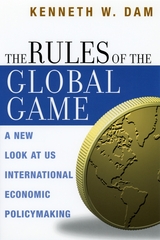 The Rules of the Global Game: A New Look at US International Economic Policymaking
Kenneth W. Dam
University of Chicago Press, 2001 Economic news once confined to the business pages of the newspapers now receives headline coverage, whether it involves protests in Seattle or sweatshops in Asia. As attention is increasingly focused on economic policy, it becomes even more important for noneconomists to be able to make sense of these stories. Is the Asian economy sinking or rising? What effects will a single European currency have on the US economy? Kenneth W. Dam's The Rules of the Global Game provides, in clear and practical language, a framework to help readers understand and answer such questions. Dam takes us beyond the headlines and inside the decision-making process as it is populated by lobbyists, special interest groups, trade associations, and public relations firms. While some economists and thinkers have idealized plans for US international economic policy, Dam, currently the deputy secretary of the treasury, manages to merge this idealism with a consideration of what it means to govern at the intersection of competing groups with competing claims.
In The Rules of the Global Game, Dam first lays out what US international economic policies are and compares them to what they should be based on how they affect US per capita income. With this foundation in place, Dam then develops and applies principles for elucidating the major components of economic policy, such as foreign trade and investment, international monetary and financial systems, and current controversial issues, including intellectual property and immigration. Underlying his explanations is a belief in the importance of worldwide free trade and open markets as well as a crucial understanding of the political forces that shape decision making. Because economic policy is not created in a political vacuum, Dam argues, sound policymaking requires an understanding of "statecraft"-the creation and use of institutions that channel the efforts of interest groups and political forces in directions that encourage good economic outcomes.
Dam's vast experience with the politics and practicalities of economic policy translates into a view of policy that is neither academic nor abstract. Rather, Dam shows us how policy is actually made, who makes it, and why, using examples such as GATT, NAFTA, the US-Japan semiconductor agreement, and the Asian financial crisis. A rare book that can be read with pleasure and profit by layperson and economist alike, The Rules of the Global Game allows readers to understand the policies that shape our economy and our lives.
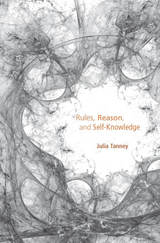 Rules, Reason, and Self-Knowledge
Julia Tanney
Harvard University Press, 2012 Julia Tanney offers a sustained criticism of today’s canon in philosophy of mind, which conceives the workings of the rational mind as the outcome of causal interactions between mental states that have their bases in the brain. With its roots in physicalism and functionalism, this widely accepted view provides the philosophical foundation for the cardinal tenet of the cognitive sciences: that cognition is a form of information-processing. Rules, Reason, and Self-Knowledge presents a challenge not only to the cognitivist approach that has dominated philosophy and the special sciences for the last fifty years but, more broadly, to metaphysical-empirical approaches to the study of the mind.
Responding to a tradition that owes much to the writings of Davidson, early Putnam, and Fodor, Tanney challenges this orthodoxy on its own terms. In untangling its internal inadequacies, starting with the paradoxes of irrationality, she arrives at a view these philosophers were keen to rebut—one with affinities to the work of Ryle and Wittgenstein and all but invisible to those working on the cutting edge of analytic philosophy and mind research today. This is the view that rational explanations are embedded in “thick” descriptions that are themselves sophistications upon ever ascending levels of discourse, or socio-linguistic practices.
Tanney argues that conceptual cartography rather than metaphysical-scientific explanation is the basic tool for understanding the nature of the mind. Rules, Reason, and Self-Knowledge clears the path for a return to the world-involving, circumstance-dependent, normative practices where the rational mind has its home.
Rules versus Relationships: The Ethnography of Legal Discourse
John M. Conley and William M. O'Barr
University of Chicago Press, 1990 In Rules versus Relationships, John M. Conley and William M. O'Barr examine the experiences of litigants seeking redress of everyday difficulties through the small claims courts of the American legal system. The authors find two major and contrasting ways in which litigants formulate and express their problems in terms of specific rule violations and seek concrete legal remedies that would mend soured relationships and respond to their personal and social needs.
 Ruling America: A History of Wealth and Power in a Democracy
Steve Fraser
Harvard University Press, 2005 Ruling America offers a panoramic history of our country's ruling elites from the time of the American Revolution to the present. At its heart is the greatest of American paradoxes: How have tiny minorities of the rich and privileged consistently exercised so much power in a nation built on the notion of rule by the people?
In a series of thought-provoking essays, leading scholars of American history examine every epoch in which ruling economic elites have shaped our national experience. They explore how elites came into existence, how they established their dominance over public affairs, and how their rule came to an end. The contributors analyze the elite coalition that led the Revolution and then examine the antebellum planters of the South and the merchant patricians of the North. Later chapters vividly portray the Gilded Age "robber barons," the great finance capitalists in the age of J. P. Morgan, and the foreign-policy "Establishment" of the post-World War II years. The book concludes with a dissection of the corporate-led counter-revolution against the New Deal characteristic of the Reagan and Bush era.
Rarely in the last half-century has one book afforded such a comprehensive look at the ways elite wealth and power have influenced the American experiment with democracy. At a time when the distribution of wealth and power has never been more unequal, Ruling America is of urgent contemporary relevance.
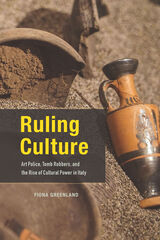 Ruling Culture: Art Police, Tomb Robbers, and the Rise of Cultural Power in Italy
Fiona Greenland
University of Chicago Press, 2021 Through much of its history, Italy was Europe’s heart of the arts, an artistic playground for foreign elites and powers who bought, sold, and sometimes plundered countless artworks and antiquities. This loss of artifacts looted by other nations once put Italy at an economic and political disadvantage compared with northern European states. Now, more than any other country, Italy asserts control over its cultural heritage through a famously effective art-crime squad that has been the inspiration of novels, movies, and tv shows. In its efforts to bring their cultural artifacts home, Italy has entered into legal battles against some of the world’s major museums, including the Getty, New York’s Metropolitan Museum, and the Louvre. It has turned heritage into patrimony capital—a powerful and controversial convergence of art, money, and politics.
In 2006, the then-president of Italy declared his country to be “the world’s greatest cultural power.” With Ruling Culture, Fiona Greenland traces how Italy came to wield such extensive legal authority, global power, and cultural influence—from the nineteenth century unification of Italy and the passage of novel heritage laws, to current battles with the international art market. Today, Italy’s belief in its cultural superiority is evident through interactions between citizens, material culture, and the state—crystallized in the Art Squad, the highly visible military-police art protection unit. Greenland reveals the contemporary actors in this tale, taking a close look at the Art Squad and state archaeologists on one side and unauthorized excavators, thieves, and smugglers on the other. Drawing on years in Italy interviewing key figures and following leads, Greenland presents a multifaceted story of art crime, cultural diplomacy, and struggles between international powers.
 Ruling Indonesia: Jokowi's Presidency in an Age of Democratic Crisis and Great Power Competition
Marcus Mietzner
University of Michigan Press, 2026 Joko Widodo—popularly called Jokowi—ruled Indonesia for a decade, from 2014 to 2024. The world’s fourth-largest nation and third-largest democracy, Indonesia had embarked on a messy democratic transition in the late 1990s, with the country’s ethnic and religious heterogeneity posing significant challenges to governance. Initially seen as a reformer who might challenge oligarchic structures, Jokowi slowly but steadily acquired an image of being a threat to democracy himself. By the time Jokowi wrapped up his presidency, he had achieved the highest approval ratings among Indonesia’s post-authoritarian presidents—and became the president with the tightest grip over Indonesia’s political elite.
Based on exclusive interviews with Jokowi and many of Indonesia’s top leaders, Ruling Indonesia shows Jokowi as a president obsessively preoccupied with his economic development agenda, subordinating all other aspects of governance to this goal. His focused approach delivered economic successes and unprecedented popularity, but also seriously undermined the health of Indonesia’s democratic institutions. Offering a holistic appraisal of his decade in office, Marcus Mietzner analyzes Jokowi’s domestic record in the context of his attempts to position Indonesia more favorably in the international competition for power and resources. Crucially, his obsession to push Indonesia closer to industrialized status while neglecting democratic development represented the ambitions and trials of many Global South leaders who are trying to juggle economic development, growing Sino-American tensions around the world, and concerns for democratic rights. As such, this book provides valuable insights into how the great power rivalry of the 21st century and the global recession of democracy are playing out in central arenas of the Global South.
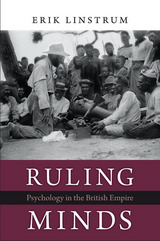 Ruling Minds: Psychology in the British Empire
Erik Linstrum
Harvard University Press, 2016 At its zenith in the early twentieth century, the British Empire ruled nearly one-quarter of the world’s inhabitants. As they worked to exercise power in diverse and distant cultures, British authorities relied to a surprising degree on the science of mind. Ruling Minds explores how psychology opened up new possibilities for governing the empire. From the mental testing of workers and soldiers to the use of psychoanalysis in development plans and counterinsurgency strategy, psychology provided tools for measuring and managing the minds of imperial subjects. But it also led to unintended consequences.
Following researchers, missionaries, and officials to the far corners of the globe, Erik Linstrum examines how they used intelligence tests, laboratory studies, and even dream analysis to chart abilities and emotions. Psychology seemed to offer portable and standardized forms of knowledge that could be applied to people everywhere. Yet it also unsettled basic assumptions of imperial rule. Some experiments undercut the racial hierarchies that propped up British dominance. Others failed to realize the orderly transformation of colonized societies that experts promised and officials hoped for. Challenging our assumptions about scientific knowledge and empire, Linstrum shows that psychology did more to expose the limits of imperial authority than to strengthen it.
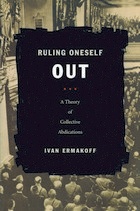 Ruling Oneself Out: A Theory of Collective Abdications
Ivan Ermakoff
Duke University Press, 2008 What induces groups to commit political suicide? This book explores the decisions to surrender power and to legitimate this surrender: collective abdications. Commonsensical explanations impute such actions to coercive pressures, actors’ miscalculations, or their contamination by ideologies at odds with group interests. Ivan Ermakoff argues that these explanations are either incomplete or misleading. Focusing on two paradigmatic cases of voluntary and unconditional surrender of power—the passing of an enabling bill granting Hitler the right to amend the Weimar constitution without parliamentary supervision (March 1933), and the transfer of full executive, legislative, and constitutional powers to Marshal Pétain (Vichy, France, July 1940)— Ruling Oneself Out recasts abdication as the outcome of a process of collective alignment. Ermakoff distinguishes several mechanisms of alignment in troubled and uncertain times and assesses their significance through a fine-grained examination of actors’ beliefs, shifts in perceptions, and subjective states. To this end, he draws on the analytical and methodological resources of perspectives that usually stand apart: primary historical research, formal decision theory, the phenomenology of group processes, quantitative analyses, and the hermeneutics of testimonies. In elaborating this dialogue across disciplinary boundaries, Ruling Oneself Out restores the complexity and indeterminate character of pivotal collective decisions and demonstrates that an in-depth historical exploration can lay bare processes of crucial importance for understanding the formation of political preferences, the paradox of self-deception, and the makeup of historical events as highly consequential.
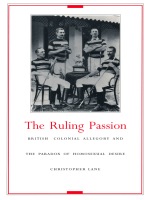 The Ruling Passion: British Colonial Allegory and the Paradox of Homosexual Desire
Christopher Lane
Duke University Press, 1995 In The Ruling Passion, Christopher Lane examines the relationship between masculinity, homosexual desire, and empire in British colonialist and imperialist fictions at the turn of the twentieth century. Questioning the popular assumption that Britain’s empire functioned with symbolic efficiency on sublimated desire, this book presents a counterhistory of the empire’s many layers of conflict and ambivalence.
Through attentive readings of sexual and political allegory in the work of Kipling, Forster, James, Beerbohm, Firbank, and others—and deft use of psychoanalytic theory—The Ruling Passion interprets turbulent scenes of masculine identification and pleasure, power and mastery, intimacy and antagonism. By foregrounding the shattering effects of male homosexuality and interracial desire, and by insisting on the centrality of unconscious fantasy and the death drive, The Ruling Passion examines the startling recurrence of colonial failure in narratives of symbolic doubt and ontological crisis. Lane argues compellingly that Britain can progress culturally and politically only when it has relinquished its residual fantasies of global mastery.
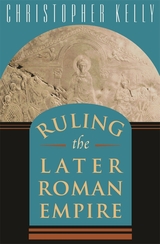 Ruling the Later Roman Empire
Christopher Kelly
Harvard University Press, 2006 In this highly original work, Christopher Kelly paints a remarkable picture of running a superstate. He portrays a complex system of government openly regulated by networks of personal influence and the payment of money. Focusing on the Roman Empire after Constantine's conversion to Christianity, Kelly illuminates a period of increasingly centralized rule through an ever more extensive and intrusive bureaucracy.
The book opens with a view of its times through the eyes of a high-ranking official in sixth-century Constantinople, John Lydus. His On the Magistracies of the Roman State, the only memoir of its kind to come down to us, gives an impassioned and revealing account of his career and the system in which he worked. Kelly draws a wealth of insight from this singular memoir and goes on to trace the operation of power and influence, exposing how these might be successfully deployed or skillfully diverted by those wishing either to avoid government regulation or to subvert it for their own ends. Ruling the Later Roman Empire presents a fascinating procession of officials, emperors, and local power brokers, winners and losers, mapping their experiences, their conflicting loyalties, their successes, and their failures.
This important book elegantly recaptures the experience of both rulers and ruled under a sophisticated and highly successful system of government.
 Ruling the Mongols of Manchuria: Language, Literacy, and Power in Late Qing Borderlands
Jiani He
Amsterdam University Press, 2025 At the turn of the twentieth century, the Jirim League witnessed a linguistic struggle between Manchu, Mongol, Chinese, Japanese, and Russian powers. The Qing Empire envisioned a trilingual educational system, with the aim of improving the Jirim Mongols’ ability to read Chinese, Manchu, and Mongolian. Through this policy, the Qing sought to transform loyal imperial subjects into modern patriotic nationals and incorporate them into an integrated and united China under a Manchu constitutional monarchy. The late Qing’s language policy and strategy for ruling the Mongols of Manchuria was an attempt to address the enduring multilingual legacies in Qing administration and people’s everyday life, growing local ethnic tensions, cross-boundary connections, imperial rivalries, and the rise of new ideas concerning nation, modern state, and international relations in East Asia. This book challenges the notion of Chinese language reform as a story of linear progression towards national monolingualism, highlights the power of multilingualism in Chinese nationalist discourse from a peripheral, non-Han Chinese perspective, and questions the extent to which national languages dominate the writing of history.
 Ruling the Savage Periphery: Frontier Governance and the Making of the Modern State
Benjamin D. Hopkins
Harvard University Press, 2020 A provocative case that “failed states” along the periphery of today’s international system are the intended result of nineteenth-century colonial design.
From the Afghan frontier with British India to the pampas of Argentina to the deserts of Arizona, nineteenth-century empires drew borders with an eye toward placing indigenous people just on the edge of the interior. They were too nomadic and communal to incorporate in the state, yet their labor was too valuable to displace entirely. Benjamin Hopkins argues that empires sought to keep the “savage” just close enough to take advantage of, with lasting ramifications for the global nation-state order.
Hopkins theorizes and explores frontier governmentality, a distinctive kind of administrative rule that spread from empire to empire. Colonial powers did not just create ad hoc methods or alight independently on similar techniques of domination: they learned from each other. Although the indigenous peoples inhabiting newly conquered and demarcated spaces were subjugated in a variety of ways, Ruling the Savage Periphery isolates continuities across regimes and locates the patterns of transmission that made frontier governmentality a world-spanning phenomenon.
Today, the supposedly failed states along the margins of the international system—states riven by terrorism and violence—are not dysfunctional anomalies. Rather, they work as imperial statecraft intended, harboring the outsiders whom stable states simultaneously encapsulate and exploit. “Civilization” continues to deny responsibility for border dwellers while keeping them close enough to work, buy goods across state lines, and justify national-security agendas. The present global order is thus the tragic legacy of a colonial design, sustaining frontier governmentality and its objectives for a new age.
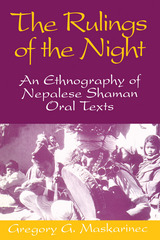 Rulings Of The Night: An Ethnography Of Nepalese Shaman Oral Texts
Gregory G. Maskarinec
University of Wisconsin Press, 1995 It is impossible to discuss what shamans are and what they do, contends Gregory G. Maskarinec, without knowing what shamans say. When Maskarinec took an interest in shaman rituals on his first visit to Nepal, he was told by many Nepalis and Westerners that the shamans he had encountered in the Himalayan foothills of western Nepal engaged in "meaningless mumblings." But in the course of several years of fieldwork he learned from the shamans that both their long, publicly chanted rituals and their whispered, secretive incantations are oral texts meticulously memorized through years of training. In The Rulings of the Night, he shows how the shamans, during their dramatic night-long performances, create the worlds of words in which shamans exist. Maskarinec analyzes several complete repertoires of the texts that the shamans use to diagnose and treat afflictions that trouble their clients. Through these texts, they intervene to manipulate and change the world, replacing its unbalanced, inexpressible chaos with orderly, balanced, grammatical, and eloquently expressible states. They negotiate the relations between language, action, and social realities, providing a well-constructed and thoroughly consistent intentional universe—and only in that universe can all shaman actions and beliefs be fully comprehended.
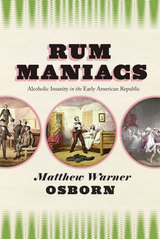 Rum Maniacs: Alcoholic Insanity in the Early American Republic
Matthew Warner Osborn
University of Chicago Press, 2014 Edgar Allan Poe vividly recalls standing in a prison cell, fearing for his life, as he watched men mutilate and dismember the body of his mother. That memory, however graphic and horrifying, was not real. It was a hallucination, one of many suffered by the writer, caused by his addiction to alcohol.
In Rum Maniacs, Matthew Warner Osborn reveals how and why pathological drinking became a subject of medical interest, social controversy, and lurid fascination in the early American republic. At the heart of that story is the disease that Poe suffered: delirium tremens. First described in 1813, delirium tremens and its characteristic hallucinations inspired sweeping changes in how the medical profession saw and treated the problems of alcohol abuse. Based on new theories of pathological anatomy, human physiology, and mental illness, the new diagnosis founded the medical conviction and popular belief that habitual drinking could become a psychological and physiological disease. By midcentury, delirium tremens had inspired a wide range of popular theater, poetry, fiction, and illustration. This romantic fascination endured into the twentieth century, most notably in the classic Disney cartoon Dumbo, in which a pink pachyderm marching band haunts a drunken young elephant. Rum Maniacs reveals just how delirium tremens shaped the modern experience of alcohol addiction as a psychic struggle with inner demons.
 The Rumanian National Movement in Transylvania, 1780-1849
Keith Hitchins
Harvard University Press Long before Rumania existed as a sovereign state, Rumanians struggled for national identity in Transylvania, an area in Eastern Europe of great ethnic and cultural diversity. The growth of their national consciousness between 1780 and 1849 affords an intriguing case study in nationalism. Keith Hitchins gives us in this book the first systematic survey and analysis of the movement—its leadership, techniques, and literary and political manifestations.
Transylvania at that time was a principality in the Habsburg domain inhabited by four groups: Magyars, Szeklers, Saxons, and Rumanians. Through the centuries the region had frequently changed status—at times independent, more often dominated by either Hungary or Austria. In 1867 it became an integral part of Hungary. After the First World War it was annexed by Rumania (which had won its independence in 1878) and is Rumanian soil today.
Hitchins finds that in the late eighteenth and early nineteenth centuries, the national movement in Transylvania was led by Western-oriented Rumanian intellectuals, the majority of whom were Uniate and Orthodox priests or the sons of priests. Their principal weapons were their writings, the schools, and the church. Influenced by the Enlightenment, these men fashioned the goals of the movement and gave it its characteristic dimensions—its moderation, rationalism, and Western orientation. Through their emphasis on education and their own personal labors in the fields of Rumanian history and linguistics, they succeeded in creating a national ethos, without which political activity of any kind would have been fruitless and on which, later, more secularly-oriented national leaders could base their specific political demands.
Chronicling the changing course of the Rumanian struggle, the author shows that the nationalists began with a demand for the feudal rights enjoyed by their neighbors the Magyars, Szeklers, and Saxons, who were represented in the provincial diet and organized according to estates, or noble nations. Still reasoning within the context of a feudal constitution and thinking in terms of the historic principality, the Rumanians, who constituted a majority of the population of Transylvania, did not yet dare dream of a separate Rumanian nation in which they would be the dominant element. By 1849, however, they had come to regard the recognition of Rumanian autonomy within the Austrian Empire as the paramount issue and even looked toward the accretion of Rumanian-inhabited areas outside Transylvania to the grand duchy they hoped to see established. Ultimately, their goal became a union of all Rumanians, including the Kingdom of Rumania, in a modern national state.
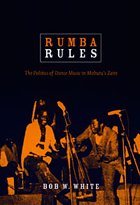 Rumba Rules: The Politics of Dance Music in Mobutu’s Zaire
Bob W. White
Duke University Press, 2008 Mobutu Sese Seko, who ruled Zaire (now the Democratic Republic of Congo) from 1965 until 1997, was fond of saying “happy are those who sing and dance,” and his regime energetically promoted the notion of culture as a national resource. During this period Zairian popular dance music (often referred to as la rumba zaïroise) became a sort of musica franca in many parts of sub-Saharan Africa. But how did this privileged form of cultural expression, one primarily known for a sound of sweetness and joy, flourish under one of the continent’s most brutal authoritarian regimes? In Rumba Rules, the first ethnography of popular music in the Democratic Republic of Congo, Bob W. White examines not only the economic and political conditions that brought this powerful music industry to its knees, but also the ways that popular musicians sought to remain socially relevant in a time of increasing insecurity. Drawing partly on his experiences as a member of a local dance band in the country’s capital city Kinshasa, White offers extraordinarily vivid accounts of the live music scene, including the relatively recent phenomenon of libanga, which involves shouting the names of wealthy or powerful people during performances in exchange for financial support or protection. With dynamic descriptions of how bands practiced, performed, and splintered, White highlights how the ways that power was sought and understood in Kinshasa’s popular music scene mirrored the charismatic authoritarianism of Mobutu’s rule. In Rumba Rules, Congolese speak candidly about political leadership, social mobility, and what it meant to be a bon chef (good leader) in Mobutu’s Zaire.
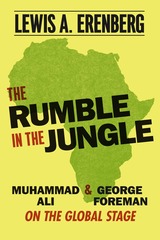 The Rumble in the Jungle: Muhammad Ali and George Foreman on the Global Stage
Lewis A. Erenberg
University of Chicago Press, 2019 The 1974 fight between Muhammad Ali and George Foreman, staged in the young nation of Zaire and dubbed the Rumble in the Jungle, was arguably the biggest sporting event of the twentieth century. The bout between an ascendant undefeated champ and an outspoken master trying to reclaim the throne was a true multimedia spectacle. A three-day festival of international music—featuring James Brown, Miriam Makeba, and many others—preceded the fight itself, which was viewed by a record-breaking one billion people worldwide. Lewis A. Erenberg’s new book provides a global perspective on this singular match, not only detailing the titular fight but also locating it at the center of the cultural dramas of the day.
TheRumble in the Jungle orbits around Ali and Foreman, placing them at the convergence of the American Civil Rights movement and the Great Society, the rise of Islamic and African liberation efforts, and the ongoing quest to cast off the shackles of colonialism. With his far-reaching take on sports, music, marketing, and mass communications, Erenberg shows how one boxing match became nothing less than a turning point in 1970s culture.
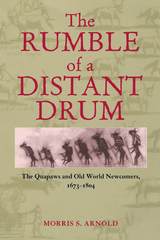 The Rumble of a Distant Drum: The Quapaws and Old World Newcomers, 1673–1804
Morris Arnold
University of Arkansas Press, 2007 Winner of the 2001 Booker Worthen Literary Prize
Winner of the 2002 S. G. Ragsdale Award for Arkansas History The Rumble of a Distant Drum opens in 1673 when Marquette and Jolliet sailed down the Mississippi River and found the Quapaw living in the area where the Arkansas River flowed into the Mississippi. In 1686 Henri de Tonti would found Arkansas Post in this same location. It was the first European settlement in this part of the country, established thirty years before New Orleans and eighty before St. Louis. Morris S. Arnold draws on his many years of archival research and writing on colonial Arkansas to produce this elegant account of the cultural intersections of the French and Spanish with the native American peoples. He demonstrates that the Quapaws and Frenchmen created a highly symbiotic society in which the two disparate peoples became connected in complex and subtle ways—through intermarriage, trade, religious practice, and political/military alliances.
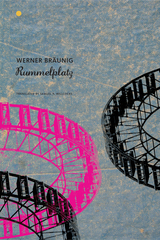 Rummelplatz
Werner Bräunig
Seagull Books, 2015 Werner Bräunig was once regarded as the great hope of East German literature—until an extract from Rummelplatz was read before the East German censorship authorities in 1965, and fierce opposition summarily sealed its fate. The novel’s sin? It painted an all too accurate picture of East German society.
Rummelplatz, translated here by Samuel P. Willcocks, focuses on a notorious East German uranium mine, run by the Soviets and supplying the brotherland’s nuclear program. Veterans, fortune seekers, and outsiders with tenuous family ties like narrator Peter Loose flock to the well-paying mine, but soon find their new lives bleak. Safety provisions are almost nonexistent and tools are not adequately supplied. The only outlets for workers are the bars and fairgrounds where copious amounts of alcohol are consumed and brawls quickly ensue. In Rummelplatz, Bräunig paints his characters as intrinsically human and treats the death of each worker, no matter how poor, as a great tragedy. Bräunig occupies a cultlike status in Germany, and this new translation of his masterpiece is an excellent introduction for English-language readers.
Praise for the German edition
“One of the best novels of postwar Germany. . . . The narrative force and the emotional punch are sensational.”—Die Zeit
“An event in literary history and one ‘helluva’ novel.”—Der Spiegel
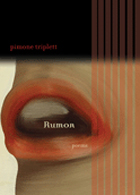 Rumor: Poems
Pimone Triplett
Northwestern University Press, 2009 In Rumor, her third collection of poems, Pimone Triplett summons diverse Eastern and Western influences to reckon the public and private costs of the overwhelming glut of "intelligence," or information, that we face in contemporary life. Triplett relays the voices, both personal and distant, that too often are only partially heard. The most difficult realities of family life are chronicled in "Family Spirits, with Voice of One Child Miscarried," in which Triplett uses free verse that incorporates the traditional Thai verse form of khap yanii. Over the course of the book, she explores how a child grows from a hint, a rumor, to a full force of intelligence and knowing. "Motherland" and "Last Wave" amplify voices, respectively, of exploited children in the brutal Thai sex trade and the victims in the aftermath of the 2004 tsunami in the Indian Ocean. The fragmentary nature of rumor, whether in the form of tabloid gossip or in the spread of partial knowledge, has consequence on a personal and even a world historical scale in Triplett's powerful poems.
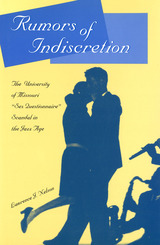 Rumors of Indiscretion: The University of Missouri's "Sex Questionnaire" Scandal in the Jazz Age
Lawrence J. Nelson
University of Missouri Press, 2003
In March 1929 hundreds of students at the University of Missouri received a questionnaire that asked their opinions of marriage, family, and sexual issues. Several questions were regarded as too intimate for university students, especially females. The so-called Sex Questionnaire, the product of a sociology class project, soon fell into the hands of the university’s president, dean of women, and the local press, which deemed it “A Filthy Questionnaire.” The Missouri legislature soon jumped into the controversy as the ensuing uproar went statewide and attracted national attention; a cry arose for the expulsion of the students and professors responsible. Beyond the questionnaire, rumors also circulated that something “too terrible” to mention had gone on at the university. Investigations followed, including one by the American Association of University Professors.
Although the controversy surrounding the questionnaire was not limited to sharp generational lines, college students—part of the decade’s “modern youth”—challenged Victorian ideas held by those who were frightened by the path American society seemed to be following during the 1920s. Nelson places the episode within the history and development of the University of Missouri as well as the “culture war” in America during the Jazz Age. He argues that the decade was marked by both change and the persistence of tradition. But while many sought change, radicals were few. What was actually lost in the Jazz Age was Victorianism and its rigid requirements for an orderly culture in which each member had a sharply defined role, violations of which carried societal sanctions.
Nelson uses the University of Missouri episode to demonstrate that while Victorianism’s unrealistic notions were lost, tradition and its most basic tenets—decorum, respect for authority, a sense of shame, strong family relationships, and the definition of right and wrong—survived. Employing previously untapped archival and printed material, Rumors of Indiscretion examines sexual attitudes, divorce, the “new woman,” the limits of academic expression, and much more in an exciting but uneasy time in American life.
The Rumphulus
Joseph G. Peterson
University of Iowa Press, 2020 Romulus was the founder of Rome; and those tossed outside the city-gate are not Romulus’s children but the cast-offs living in hovels, the Rumphulus. However, this isn’t ancient Rome, but rather the nature preserve of a contemporary American suburb. The outcasts don’t understand why they’ve been relegated to the
woods. Nor do they know if they will ever summon the courage to cross the roads that act as a physical and psychological barrier to their reentry into conventional society. Daily they negotiate the harsh conditions of the wild and the dangerous presence of one another while they contemplate their exiles. That is until society
comes for one of them. The Rumphulus have grown their beards long, and when they can no longer stand life they howl like wolves; only they are not wolves but the stranded city outcasts who howl in pain.
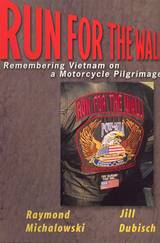 Run For The Wall: Remembering Vietnam on a Motorcycle Pilgrimage
Michalowski, Raymond J
Rutgers University Press, 2001 Every May, for more than a decade, an ever-increasing number of motorcyclists have made the “Run for the Wall,” a cross-country journey from Southern California to the “Wall,” the Vietnam war memorial in Washington, D.C. While the journey’s avowed purpose is political — to increase public awareness about those who remain either prisoners of war or missing in action in Southeast Asia — it also serves as a healing pilgrimage for its participants and as a “welcome-home” ritual many veterans feel they never received.
Run for the Wall is a highly readable ethnographic account of this remarkable American ritual. The authors, themselves motorcyclists as well as Run participants, demonstrate that the event is a form of secular pilgrimage. Here key concepts in American culture— “freedom,” and “brotherhood,” for example—are constructed and deployed in a variety of rituals and symbols to enable participants to come to terms with the consequences of the Vietnam war. While the focus is the journey itself, the book also explores other themes related to American culture and history, including the nature of community, the Vietnam war, and the creation of American secular ritual.
In moving, first-hand accounts, the book tells how participation in the POW-MIA social movement helps individuals find personal and collective meaning in America’s longest and most divisive conflict. Above all, this is a story of a uniquely American form of political action, ritual, pilgrimage, and the social construction of memory.
Run, River, Run: A Naturalist's Journey Down One of the Great Rivers of the West
Ann Zwinger
University of Arizona Press, 1984 The Green River runs wild, free and vigourous from southern Wyoming to northeastern Utah. Edward Abbey wrote in these pages in 1975 that Anne Zwinger's account of the Green River and its subtle forms of life and nonlife may be taken as authoritative. 'Run, River, Run,' should serve as a standard reference work on this part of the American West for many years to come." —New York Times Book Review
 Run School Run
Roland Barth
Harvard University Press, 1980 Roland Barth believes that there is a way to create a school which, instead of insisting upon uniformity, builds upon diversity among students, teachers, and teaching styles. Unlike many educational theorists, Barth has had ample opportunity to test his beliefs during his many years as an elementary school principal. Run School Run is the chronicle of his theory in action, a nuts-and-bolts study of one school’s rocky but ultimately quite successful transition toward pluralist education.
For Barth, the case against an elementary education that is uniform in content and method is clear-cut: teacher abilities differ radically, and so do student needs. In the pluralist school, the problem is to find ways to put this variety to good use. Barth shows that the solution is essentially a matter of organization; he sets up a principal’s blueprint that offers teachers more control over curriculum content, teaching materials and methods, and composition of classes, in a way that ensures an educational coherence for each student.
Run School Run is a rich, readable account, a how-to book as well as a personal reminiscence on the initiation and administration of an environment in which teaching and learning are allowed to take on shapes of their own design.
RUN SCREAM UNBURY SAVE
Katherine McCord
Autumn House Press, 2017 "Michael Martone, choosing Katherine McCord’s RUN SCREAM UNBURY SAVE as Autumn House Press’ Creative Nonfiction Prize, calls the literary memoir 'extraordinary,' 'a book’s BOOK. A map more detailed than the thing it represents. . .with goddamn gumption and infinite grace.' Katherine McCord hilariously and poignantly captures living, as a writer/person/mother/professor/wife, that is, as anyone, overly aware and stunned by the time we are in, this often fascinating but very difficult age."
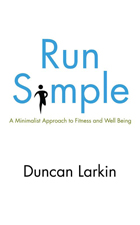 Run Simple: A Minimalist Approach to Fitness and Well-Being
Duncan Larkin
Westholme Publishing, 2012 A Return to Simplicity Can Lead Runners to Both Personal Improvement and Peace of Mind
In this age of instant information and new technologies, marathoner and fitness instructor Duncan Larkin recommends that runners get rid of their iPods, pace calculators, and heart monitors while exercising. Rather than helping a runner to improve, the author contends that these devices can be a detriment to both performance and the benefits of a training program. Written in direct, clear language, Run Simple: A Minimalist Approach to Fitness and Well-Being is a practical and inspirational pocket guide for runners of all abilities. The author’s goal is to share with his fellow runners the principles he has discovered that prevent burn out and promote the maximum physical and mental benefits of running. Beginning with a discussion about the role of electronic devices and other equipment that have become commonplace among the millions of persons who run every day, the author explains how to return to a simpler way of exercising and training, including running plans that demonstrate the benefits of watch-free running. He also recommends replacing a gym membership with alternative exercises that can be done at home as well as taking better control of individual nutrition. In addition, the author shows ways to economize expenses associated with running, how to dress properly for different weather conditions, and mental exercises for motivation. By following the author’s advice, runners will improve their running experience and maintain a healthy exercise regimen.
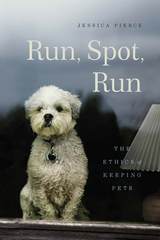 Run, Spot, Run: The Ethics of Keeping Pets
Jessica Pierce
University of Chicago Press, 2016 A life shared with pets brings many emotions. We feel love for our companions, certainly, and happiness at the thought that we’re providing them with a safe, healthy life. But there’s another emotion, less often acknowledged, that can be nearly as powerful: guilt. When we see our cats gazing wistfully out the window, or watch a goldfish swim lazy circles in a bowl, we can’t help but wonder: are we doing the right thing, keeping these independent beings locked up, subject to our control? Is keeping pets actually good for the pets themselves?
That’s the question that animates Jessica Pierce’s powerful Run, Spot, Run. A lover of pets herself (including, over the years, dogs, cats, fish, rats, hermit crabs, and more), Pierce understands the joys that pets bring us. But she also refuses to deny the ambiguous ethics at the heart of the relationship, and through a mix of personal stories, philosophical reflections, and scientifically informed analyses of animal behavior and natural history, she puts pet-keeping to the test. Is it ethical to keep pets at all? Are some species more suited to the relationship than others? Are there species one should never attempt to own? And are there ways that we can improve our pets’ lives, so that we can be confident that we are giving them as much as they give us?
Deeply empathetic, yet rigorous and unflinching in her thinking, Pierce has written a book that is sure to help any pet owner, unsettling assumptions but also giving them the knowledge to build deeper, better relationships with the animals with whom they’ve chosen to share their lives.
 Runagate: Songs of the Freedom Bound
Crystal Simone Smith
Duke University Press, 2025 Crystal Simone Smith’s new poetry collection, Runagate, reimagines the experiences of enslaved and formerly enslaved persons in a stark and chilling response to the archives of chattel slavery: bills of sale, interviews, narratives, and fugitive runaway ads. Embodying the aesthetics and Japanese poetic forms haiku and tanka, her poems bear witness to the brutal and horrifying treatment of enslaved people and contrast their humanity with the inhumanity of their enslavers. In these poems, fugitive persons evade slave patrol hounds by climbing magnolia trees, use the cover of night and the detritus of a shipwreck to swim to freedom, and find temporary refuge in a cabin where a woman offers bread and water. Throughout, Smith poignantly envisions their flights to freedom—passages that were fueled by love, hope, and impossible dreams. She unceasingly gives voice to those who found courage in both bondage and freedom. In Runagate, the enslaved regain their stories and return to the sensory world.
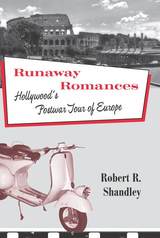 Runaway Romances: Hollywood's Postwar Tour of Europe
Robert R. Shandley
Temple University Press, 2009 In the 1950s and early 1960s, America imagined itself young and in love in Europe. And Hollywood films of the era reflected this romantic allure. From a young and naïve Audrey Hepburn falling in love with Gregory Peck inRoman Holiday to David Lean’s Summertime, featuring Katherine Hepburn’s sexual adventure in Venice, these glossy travelogue romances were shot on location, and established an exciting new genre for Hollywood. As Robert Shandley shows in Runaway Romances, these films were not only indicative of the ideology of the American-dominated postwar world order, but they also represented a shift in Hollywood production values. Eager to capture new audiences during a period of economic crisis, Hollywood’s European output utilized the widescreen process to enhance cinematic experience. The films—To Catch a Thief, Three Coins in the Fountain, and Funny Face among them—enticed viewers to visit faraway places for romantic escapades. In the process, these runaway romances captured American fantasies for a brief, but intense, period that ended as audiences grew tired of old World splendors, and entered into a new era of sexual awakening.
 Runaway Wives, Urban Crimes, and Survival Tactics in Wartime Beijing, 1937–1949
Zhao Ma
Harvard University Press, 2015 From 1937 to 1949, Beijing was in a state of crisis. The combined forces of Japanese occupation, civil war, runaway inflation, and reformist campaigns and revolutionary efforts wreaked havoc on the city’s economy, upset the political order, and threatened the social and moral fabric as well. Women, especially lower-class women living in Beijing’s tenement neighborhoods, were among those most affected by these upheavals. Delving into testimonies from criminal case files, Zhao Ma explores intimate accounts of lower-class women’s struggles with poverty, deprivation, and marital strife. By uncovering the set of everyday tactics that women devised and utilized in their personal efforts to cope with predatory policies and crushing poverty, this book reveals an urban underworld that was built on an informal economy and conducted primarily through neighborhood networks. Where necessary, women relied on customary practices, hierarchical patterns of household authority, illegitimate relationships, and criminal entrepreneurship to get by. Women’s survival tactics, embedded in and reproduced by their everyday experience, opened possibilities for them to modify the male-dominated city and, more importantly, allowed women to subtly deflect, subvert, and “escape without leaving” powerful forces such as the surveillance state, reformist discourse, and revolutionary politics during and beyond wartime Beijing.
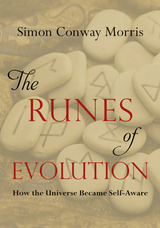 The Runes of Evolution: How the Universe became Self-Aware
Simon Conway Morris
Templeton Press, 2015 How did human beings acquire imaginations that can conjure up untrue possibilities? How did the Universe become self-aware? In The Runes of Evolution, Simon Conway Morris revitalizes the study of evolution from the perspective of convergence, providing us with compelling new evidence to support the mounting scientific view that the history of life is far more predictable than once thought.
A leading evolutionary biologist at the University of Cambridge, Conway Morris came into international prominence for his work on the Cambrian explosion (especially fossils of the Burgess Shale) and evolutionary convergence, which is the process whereby organisms not closely related (not monophyletic), independently evolve similar traits as a result of having to adapt to similar environments or ecological niches.
In The Runes of Evolution, he illustrates how the ubiquity of convergence hints at an underlying framework whereby many outcomes, not least brains and intelligence, are virtually guaranteed on any Earth-like planet. Conway Morris also emphasizes how much of the complexity of advanced biological systems is inherent in microbial forms.
By casting a wider net, The Runes of Evolution explores many neglected evolutionary questions. Some are remarkably general. Why, for example, are convergences such as parasitism, carnivory, and nitrogen fixation in plants concentrated in particular taxonomic hot spots? Why do certain groups have a particular propensity to evolve toward particular states?
Some questions lead to unexpected evolutionary insights: If bees sleep (as they do), do they dream? Why is that insect copulating with an orchid? Why have sponges evolved a system of fiber optics? What do mantis shrimps and submarines have in common? If dinosaurs had not gone extinct what would have happened next? Will a saber-toothed cat ever re-evolve?
Cona Morris observes: “Even amongst the mammals, let alone the entire tree of life, humans represent one minute twig of a vast (and largely fossilized) arborescence. Every living species is a linear descendant of an immense string of now-vanished ancestors, but evolution itself is the very reverse of linear. Rather it is endlessly exploratory, probing the vast spaces of biological hyperspace. Indeed this book is a celebration of how our world is (and was) populated by a riot of forms, a coruscating tapestry of life.”
The Runes of Evolution is the most definitive synthesis of evolutionary convergence to be published to date.
Running
Lindsey A. Freeman
Duke University Press, 2023 In Running, former NCAA Division I track athlete Lindsey A. Freeman presents the feminist and queer handbook of running that she always wanted but could never find. For Freeman, running is full of joy, desire, and indulgence in the pleasure and weirdness of having a body. It allows for a space of freedom—to move and be moved. Through tender storytelling of a lifetime wearing running shoes, Freeman considers injury and recovery, what it means to run as a visibly queer person, and how the release found in running comes from a desire to touch something that cannot be accessed when still. Running invites us to run through life, legging it out the best we can with heart and style.
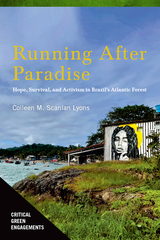 Running After Paradise: Hope, Survival, and Activism in Brazil's Atlantic Forest
Colleen M. Scanlan Lyons
University of Arizona Press, 2022 Brazil’s Atlantic Forest is a paradise to many. In Southern Bahia, surfers, billionaires, travelers, and hippies mingle with environmentalists, family farmers, quilombolas (descendants of formerly enslaved people), and nativos, or “locals.” Each of these groups has connections to the unique environment, culture, and character of this region as their home, their source of a livelihood, or perhaps their vacation escape. And while sometimes these connections converge—other times they clash.
The pressures on this tropical forest are palpable. So are people’s responses to these pressures. What was once the state’s economic mainstay, cacao production, is only now beginning to make a comeback after a disease decimated the crops of large and small farmers alike. Tourism, another economic hope, is susceptible to economic crises and pandemics. And the threat of a massive state-led infrastructure project involving mining, a railroad, and an international port has loomed over the region for well over a decade.
Southern Bahia is at a crossroads: develop a sustainable, forest-based economy or run the risk of losing the identity and soul of this place forevermore. Through the lives of environmentalists, farmers, quilombolas, and nativos—people who are in and of this place—this book brings alive the people who are grappling with this dilemma.
Anthropologist Colleen M. Scanlan Lyons brings the eye of a storyteller to present this complex struggle, weaving in her own challenges of balancing family and fieldwork alongside the stories of the people who live in this dynamic region. Intertwined tales, friendships, and hope emerge as people both struggle to sustain their lives in a biodiversity hotspot and strive to create their paradise.
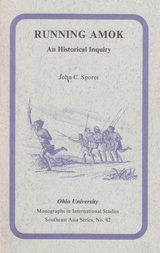 Running Amok: An Historical Inquiry
John C. Spores
Ohio University Press, 1988 Amok, one of the few Malay words commonly appearing in English, names a syndrome of unpredictable and indiscriminate homicidal behavior with suicidal intent. In tracing the development of this behavioral pattern, Spores examines historical data, including frequently colorful colonialist accounts of such episodes, from British Malaya and the Netherlands East Indies during the period 1800–1925.
Spores presents a basic etiological distinction between reactive-motivated and a spontaneous, unmotivated amok; the one an intentional act capable of establishing or restoring dignity and self-respect; the other a result of organic disturbance. He also explores the social-psychological dynamics of engagement in the two types of solitary amok and suggests possible behavioral chains. Further, his study demonstrates the impact of social forces and processes of the late nineteenth and early twentieth century which significantly altered factors in traditional Malay society important in generating expressions of solitary amok.
Running amok demonstrates the utility of bringing historical data to bear on the examination of specific social phenomena, particularly suggesting that the understanding of some present-day forms of mental disorder or other aberrant or deviant behavior can be facilitated and enriched through such analysis.
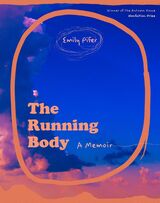 The Running Body: A Memoir
Emily Pifer
Autumn House Press, 2022 A memoir of addiction, body image, and healing, through the lens of a long-distance runner.
Emily Pifer’s debut memoir, The Running Body, wrestles and reckons with power and agency, language and story, body dysphoria and beauty standards, desire and addiction, loss and healing. Pifer employs multiple modes of storytelling—memoir, meditation, and cultural analysis—interweaving research, argument, and experience as she describes how, during her time as a collegiate distance runner, she began to run more while eating less. Many around her, including her coaches, praised her for these practices. But as she became faster, and as her body began to resemble the bodies that she had seen across start-lines and on the covers of running magazines, her bones began to fracture. Pifer tells her story alongside the stories of her teammates, competitors, and others as they all face trouble regarding their bodies.
Through the lens of long-distance running, Pifer examines the effects of idolization and obsession, revealing the porous boundaries between what counts as success and what is considered failure. While grounded in truth, The Running Body interrogates its relationship to magical thinking, the stories we tell ourselves, and the faultiness of memory. Fractures, figurative and literal, run through the narrative as Pifer explores the ways bodies become entangled in stories.
The Running Body was selected by Steve Almond as the winner of the 2021 Autumn House Nonfiction Prize.
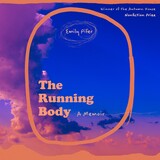 The Running Body: A Memoir
Emily Pifer
Autumn House Press, 2023 A memoir of addiction, body image, and healing, through the lens of a long-distance runner.
Emily Pifer’s debut memoir, The Running Body, wrestles and reckons with power and agency, language and story, body dysphoria and beauty standards, desire and addiction, loss and healing. Pifer employs multiple modes of storytelling—memoir, meditation, and cultural analysis—interweaving research, argument, and experience as she describes how, during her time as a collegiate distance runner, she began to run more while eating less. Many around her, including her coaches, praised her for these practices. But as she became faster, and as her body began to resemble the bodies that she had seen across start-lines and on the covers of running magazines, her bones began to fracture. Pifer tells her story alongside the stories of her teammates, competitors, and others as they all face trouble regarding their bodies.
Through the lens of long-distance running, Pifer examines the effects of idolization and obsession, revealing the porous boundaries between what counts as success and what is considered failure. While grounded in truth, The Running Body interrogates its relationship to magical thinking, the stories we tell ourselves, and the faultiness of memory. Fractures, figurative and literal, run through the narrative as Pifer explores the ways bodies become entangled in stories.
The Running Body was selected by Steve Almond as the winner of the 2021 Autumn House Nonfiction Prize.
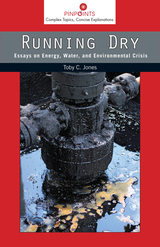 Running Dry: Essays on Energy, Water, and Environmental Crisis
Jones, Toby Craig
Rutgers University Press, 2015 The world’s water is under siege. A combination of corporate greed, the elite pursuit of political power, and our unrelenting reliance on carbon-based energy is accerlating a broad range of environmental and political crises. Potentially catastrophic climate change, driven primarily by the consumption of oil and gas, threatens the environment in a variety of ways, including producing unprecedented patterns of heavy weather and superstorms in some places and droughts in others. Alongside intensifying environmental dangers posed by our reliance on carbon energy, the conditions of modern life, from happiness to the possibility of democratic politics, are also being undermined. In Running Dry, historian Toby Craig Jones explores how modern society’s unquenchable thirst for carbon-based energy is endangering the environment broadly, as well as the historical roots of this threat. This accessible book examines the history of the "energy-water nexus," the ways in which oil and gas extraction poison and dry up water resources, the role of corporate "science" in deflecting attention away from the emerging crises, and the ways in which the rush to capture more energy is also challenging America's democratic order.
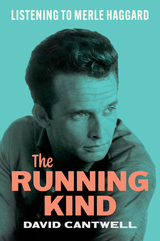 The Running Kind: Listening to Merle Haggard
David Cantwell
University of Texas Press, 2022 2022 Belmont Award for the Best Book on Country Music, International Country Music Conference/Belmont University
New and expanded biography of one of country music’s most celebrated singer-songwriters.
Merle Haggard enjoyed numerous artistic and professional triumphs, including more than a hundred country hits (thirty-eight at number one), dozens of studio and live album releases, upwards of ten thousand concerts, induction into the Country Music Hall of Fame, and songs covered by artists as diverse as Lynryd Skynyrd, Elvis Costello, Tammy Wynette, Bobby "Blue" Bland, Willie Nelson, the Grateful Dead, and Bob Dylan. In The Running Kind, a new edition that expands on his earlier analysis and covers Haggard's death and afterlife as an icon of both old-school and modern country music, David Cantwell takes us on a revelatory journey through Haggard’s music and the life and times out of which it came. Covering the breadth of his career, Cantwell focuses especially on the 1960s and 1970s, when Haggard created some of his best-known and most influential music: songs that helped invent the America we live in today. Listening closely to a masterpiece-crowded catalogue (including “Okie from Muskogee,” “Sing Me Back Home,” “Mama Tried,” and “Working Man Blues,” among many more), Cantwell explores the fascinating contradictions—most of all, the desire for freedom in the face of limits set by the world or self-imposed—that define not only Haggard’s music and public persona but the very heart of American culture.
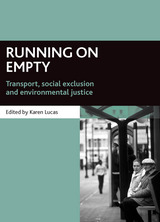 Running on empty: Transport, social exclusion and environmental justice.
Edited by Karen Lucas
Bristol University Press, 2004 Running on empty argues that past failure to address fundamental inequalities in the ability of low-income households to access adequate transport has undermined effective delivery of welfare policies in the US and UK; describes the new policies and initiatives being developed to address this oversight; outlines the case for including transport as an area of social policy inquiry, identifying key factors and uses case study examples of practical initiatives from both sides of the Atlantic to draw lessons for future policy and practice. The book is aimed at students, researchers, policy makers and practitioners with an interest in understanding the social effects of transport policy. The comparison between US and UK policy and practice adds an important new dimension to those familiar with the subject, while its easy-to-read format and well-illustrated case study examples make it an ideal first text for newcomers to the field.
 Running on Hope: Female Community Health Labor in Rajasthan, India
Svea Closser and Surendra Singh Shekhawat
Vanderbilt University Press, 2025 Throughout India, Accredited Social Health Activists (ASHAs) visit households in their communities to deliver essential health services and link community members with key health benefits. Like many other female Community Health Workers across the world, ASHAs are often portrayed as virtuous, passive volunteers, selflessly providing services to their neighbors.
The reality is more complicated and much more interesting. Drawing on ethnographic work in Rajasthan, Running on Hope follows ASHAs through striking personal transformations. From their positions as rural daughters‑in‑law—a particularly low‑power position in Rajasthan—ASHAs have, over years of work, gained unprecedented autonomy for young rural women. They have also gained a deep understanding of what many argue is the exploitation involved in their low‑ranking position in the health system. ASHAs often earn less than $100 per month for extensive work, well below the legal minimum wage.
To counter this, many ASHAs have joined unions—an endeavor that has ultimately proven disappointing: union leaders’ desires for political advancement are often at odds with ASHAs’ own needs. However, ASHAs do not have connections, money, or social power to organize effectively on their own, without a political patron. In Running on Hope, authors Svea Closser and Surendra Singh Shekhawat interview women who work as ASHAs to learn about their organizing goals, their roles in their community as conduits to health education and resources, and their hopes for a better future.
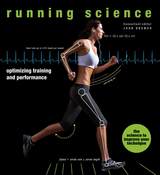 Running Science: Optimizing Training and Performance
John Brewer
University of Chicago Press, 2017 Running is a deceptively simple sport. At its most basic, you need only shoes and comfortable clothes you don’t mind getting sweaty. Yet each time you lace up, all your body’s moving parts must work together to achieve a gait that will keep you injury-free. Many other factors also affect your performance, from the weather and the surface you run on to your shoes, your diet, and even your mental and emotional state. Science plays an important role in most, if not all, of these factors.
As a sports scientist and Running Fitness columnist, John Brewer has reviewed hundreds of scientific studies, and he offers runners the benefit of their findings in Running Science. Each chapter explores a different aspect of the sport through a series of questions. Many of the questions address practical matters: Do you really need to stretch? Which running shoes best suit your form and foot strike? Does carbo-loading lore stand up to scientific scrutiny—could a big bowl of spaghetti be the difference between a PR and a DNF? Other questions enhance appreciation for the incredible feats of the sport’s great athletes. (What would it take to run a two-hour marathon? Perfect weather, a straight, flat course, competition, and a lot of luck!) The answer to each question is presented in a straightforward, accessible manner, with accompanying infographics.
Whether you’re a beginner or a seasoned runner with many miles and medals behind you, Running Science is a must-have for anyone interested in the fascinating science behind the sport.
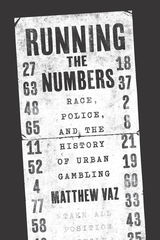 Running the Numbers: Race, Police, and the History of Urban Gambling
Matthew Vaz
University of Chicago Press, 2020 Every day in the United States, people test their luck in numerous lotteries, from state-run games to massive programs like Powerball and Mega Millions. Yet few are aware that the origins of today’s lotteries can be found in an African American gambling economy that flourished in urban communities in the mid-twentieth century. In Running the Numbers, Matthew Vaz reveals how the politics of gambling became enmeshed in disputes over racial justice and police legitimacy.
As Vaz highlights, early urban gamblers favored low-stakes games built around combinations of winning numbers. When these games became one of the largest economic engines in nonwhite areas like Harlem and Chicago’s south side, police took notice of the illegal business—and took advantage of new opportunities to benefit from graft and other corrupt practices. Eventually, governments found an unusual solution to the problems of illicit gambling and abusive police tactics: coopting the market through legal state-run lotteries, which could offer larger jackpots than any underground game. By tracing this process and the tensions and conflicts that propelled it, Vaz brilliantly calls attention to the fact that, much like education and housing in twentieth-century America, the gambling economy has also been a form of disputed terrain upon which racial power has been expressed, resisted, and reworked.
 Running the Numbers: Race, Police, and the History of Urban Gambling
Matthew Vaz
University of Chicago Press, 2020 Every day in the United States, people test their luck in numerous lotteries, from state-run games to massive programs like Powerball and Mega Millions. Yet few are aware that the origins of today’s lotteries can be found in an African American gambling economy that flourished in urban communities in the mid-twentieth century. In Running the Numbers, Matthew Vaz reveals how the politics of gambling became enmeshed in disputes over racial justice and police legitimacy.
As Vaz highlights, early urban gamblers favored low-stakes games built around combinations of winning numbers. When these games became one of the largest economic engines in nonwhite areas like Harlem and Chicago’s south side, police took notice of the illegal business—and took advantage of new opportunities to benefit from graft and other corrupt practices. Eventually, governments found an unusual solution to the problems of illicit gambling and abusive police tactics: coopting the market through legal state-run lotteries, which could offer larger jackpots than any underground game. By tracing this process and the tensions and conflicts that propelled it, Vaz brilliantly calls attention to the fact that, much like education and housing in twentieth-century America, the gambling economy has also been a form of disputed terrain upon which racial power has been expressed, resisted, and reworked.
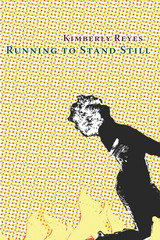 Running to Stand Still
Kimberly Reyes
Omnidawn, 2019 Histories, stories, lyrics, aspirations, dreams, pressures, and images are spun into a musical tale through a site of convergence: the Black female body. Swarmed by external gazes and narratives, the inhabitant of this body uses her power to turn down this cacophony of noise and compose a symphonic space for herself. By breaching boundaries of racism, sexism, sizeism, colorism, and colonialism, these poems investigate the memories and realities of existing as Black in America. Building from poetic, journalistic, and musical histories, poet and essayist Kimberly Reyes constructs a complex and fantastic narrative in which she negotiates a path to claim her own power.
These poems teem with life, a life rich with many selves and many histories that populate in the voice of Reyes’s poetic narrator. They sway between negotiations of hypervisibility and erasure, the inevitable and the chosen, and the perceived and the constructed. Reyes’s poems offer sharp observations and lyrical movement to guide us in a ballad of reconciliation and becoming.
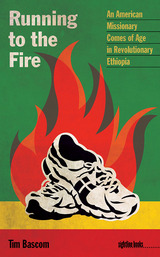 Running to the Fire: An American Missionary Comes of Age in Revolutionary Ethiopia
Tim Bascom
University of Iowa Press, 2015 In the streets of Addis Ababa in 1977, shop-front posters illustrate Uncle Sam being strangled by an Ethiopian revolutionary, parliamentary leaders are executed, student protesters are gunned down, and Christian mission converts are targeted as imperialistic sympathizers. Into this world arrives sixteen-year-old Tim Bascom, whose missionary parents have brought their family from a small town in Kansas straight into Colonel Mengistu’s Marxist “Red Terror.” Here they plan to work alongside a tiny remnant of western missionaries who trust that God will somehow keep them safe.
Running to the Fire focuses on the turbulent year the Bascom family experienced upon traveling into revolutionary Ethiopia. The teenage Bascom finds a paradoxical exhilaration in living so close to constant danger. At boarding school in Addis Ababa, where dorm parents demand morning devotions and forbid dancing, Bascom bonds with other youth due to a shared sense of threat. He falls in love for the first time, but the young couple is soon separated by the politics that affect all their lives. Across the country, missionaries are being held under house arrest while communist cadres seize their hospitals and schools. A friend’s father is imprisoned as a suspected CIA agent; another is killed by raiding Somalis.
Throughout, the teenaged Bascom struggles with his faith and his role within the conflict as a white American Christian missionary’s child. Reflecting back as an adult, he explores the historical, cultural, and religious contexts that led to this conflict, even though in doing so he is forced to ask himself questions that are easier left alone. Why, he wonders, did he find such strange fulfillment in being young and idealistic in the middle of what was essentially a kind of holy war?
 Rupert García: The Making of an American Artist, a Testimonio
Mario T. García
Rutgers University Press, 2026 This is the first biography of the renowned American Chicano visual artist and activist Rupert García, drawing on fifty hours of interviews conducted over thirty years and accompanied by eighty images. This in-depth oral history gives an unparalleled look at García’s life and work, tracing his evolution as an artist and the political upheavals that shaped his life and worldview. Mario T. García’s testimonio places Rupert García’s art in historical perspective, from his beginnings as a working-class Mexican American from California’s Central Valley, his coming of age in the U.S. Air Force during the Vietnam War, his involvement in the antiwar movement during the San Francisco State student strike in 1968-69, and his participation in the Chicano Movement and beyond. Influenced by history and politics, García’s vital works of art represent a changing world through the eyes of an artist, speaking to issues of poverty, racism, capitalism, war, and the role of the artist in society. His art—from revolutionary silkscreen posters to monumental pastels to portraits of political icons like Frida Kahlo, Che Guevara, and Dolores Huerta—serves to critique history and reassess it. It is work that will endure for generations to come.
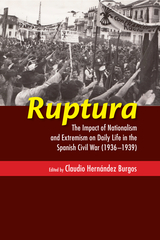 Ruptura: The Impact of Nationalism and Extremism on Daily Life in the Spanish Civil War (1936–1939)
Claudio Hernández Burgos
Sussex Academic Press, 2022 Ruptura; focuses on how nationalism, as well as extremist conceptions and projects, defined daily life experiences in the battlefield, in civilian cities, and in towns. A principal objective is to demonstrate that the civil war was not a struggle waged between ideologies disconnected from the preoccupations and daily lives of the Spanish people. It brings to light the climate of violence, the social and symbolic transformations resulting from political divergence, and the widespread uncertainty that shaped the behavior, attitudes, lifestyles, practices, and experiences of both combatants and civilians. New theoretical approaches on so-called 'war studies' are addressed. Several contributions frame their analyses within the international context of radicalization and political violence of interwar Europe. Without an understanding of the development of extremist projects, ideologies, and attitudes in their particular and international dimensions, it is impossible to explain the atmosphere of severe social radicalization and the unprecedented levels of violence reached during and after the civil war. In present times, when the relationship of 'extremism' and nationalism to civil war is once again at the heart of public discourse and a preoccupation of media and governments, a historical perspective on these questions could not be more timely or necessary.
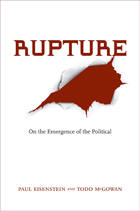 Rupture: On the Emergence of the Political
Paul Eisenstein and Todd McGowan
Northwestern University Press, 2012 In a radical reconsideration of political theory and politics, Paul Eisenstein and Todd McGowan explore the notion of rupture or radical tearing apart in both history and theory through the sweep of Western philosophy from Plato to Kierkegaard and beyond. The authors use contemporary literature and film to elucidate political theory, examining works by such writers are Dave Eggers, John Irving, and Toni Morrison, as well as films by directors from Sergei Eisenstein to David Fincher. Paul Eisenstein and Todd McGowan find that a rupture or radical break is repeatedly invoked at the beginning of every philosophical system. In this rupture, many of our most cherished political values—equality, solidarity, and the idea of freedom—emerge. But the lack of a sustained commitment to this radical tearing apart has repeatedly foreshortened, distorted, or perverted those same values. Most political philosophy may have marginalized these radical breaks with the past. But Eisenstein and McGowan demonstrate that Alain Badiou, Giorgio Agamben, and Slavoj Žižek have consistently brought rupture to the fore as an organizing principle for political thought. This insight holds great pertinence to our current world situation. Seeing the possibilities for an extended dialogue and sustained political change, Eisenstein and McGowan argue for a more systematic engagement with these theorists.
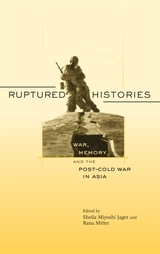 Ruptured Histories: War, Memory, and the Post–Cold War in Asia
Sheila Miyoshi Jager
Harvard University Press, 2007 What has the end of the Cold War meant for East Asia, and for how its people understand their recent history? These thought-provoking essays explore a vigorously contested area in public culture, the wars of the modern era.
All the major East Asian states have undergone a profound reassessment of their experiences from World War II to Vietnam. New and at times aggressive forms of nationalism in Japan, China, South Korea, Vietnam, and Taiwan have affected American security policy in the Pacific and posed a challenge to the post-communist world order. Japan has met fervent opposition to its premiers’ visits to the Yasukuni shrine honoring the wartime dead. China has reclaimed a forgotten war history, such as the positive contributions of Chiang Kai-shek’s Nationalists. South Korea has embraced an interpretation of the Korean War that is hostile to the United States and sympathetic to its North Korean adversaries.
This volume not only illuminates regional and global changes in East Asia today, but also underscores the need for rethinking the Cold War language that continues to inform U.S.–East Asian relations.
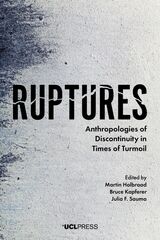 Ruptures: Anthropologies of Discontinuity in Times of Turmoil
Edited by Martin Holbraad, Bruce Kapferer, and Julia F. Sauma
University College London, 2019 A “rupture” is a radical and often forceful discontinuity, an active ingredient of a world in turmoil, lying at the heart of some of the most defining experiences of our time, including the rise of populist politics and the corollary impulse towards protest and revolutionary change.
With Ruptures, editors Martin Holbraad, Bruce Kapferer, and Julia F. Sauma have brought together leading and emerging international anthropologists to explore the concept of rupture in select ethnographic and historical contexts. Among the contributions are chapters that look at images of the guillotine in the French Revolution, reactions to Trump’s election in the United States, the motivations of young Danes who join ISIS in Syria, “butterfly effect” activism among environmental anarchists in northern Europe, the experiences of political trauma and its “repair” through privately sponsored museums of Mao’s revolution in China, people’s experience of the devastating 2001 earthquake in Gujarat; the rupture of Protestant faith among Danish nationalist theologians, and the attempt to invent ex nihilo an alphabet for use in Christian prophetic movements in Congo and Angola.
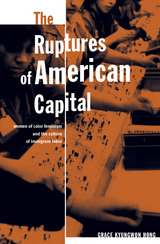 The Ruptures Of American Capital: Women Of Color Feminism And The Culture Of Immigrant Labor
Grace Kyungwon Hong
University of Minnesota Press, 2006 Universality is a dangerous concept, according to Grace Kyungwon Hong, one that has contributed to the rise of the U.S. nation-state that privileges the propertied individual. However, African American, Asian American, and Chicano people experience the same stretch of city sidewalk with varying degrees of safety, visibility, and surveillance.The Ruptures of American Capital examines two key social formations—women of color feminism and racialized immigrant women’s culture—in order to argue that race and gender are contradictions within the history of U.S. capital that should be understood not as monolithic but as marked by its crises. Hong shows how women of color feminism identified ways in which nationalist forms of capital, such as the right to own property, were repressive. The Ruptures of American Capital demonstrates that racialized immigrant women’s culture has brought to light contested modes of incorporation into consumer culture.Interweaving discussion of U.S. political economy with literary analyses (including readings from Booker T. Washington to Jessica Hagedorn) Hong challenges the individualism of the United States and the fetishization of difference that is one of the markers of globalization.Grace Kyungwon Hong is assistant professor of English and Asian American studies at the University of Wisconsin, Madison.
 Rural ageing: A good place to grow old?
Edited by Norah C. Keating
Bristol University Press, 2008 This important book addresses a growing international interest in 'age-friendly' communities. It examines the conflicting stereotypes of rural communities as either idyllic and supportive or isolated and bereft of services. Providing detailed information on the characteristics of rural communities, contributors ask the question, 'good places for whom'?The book extends our understanding of the intersections of rural people and places across the adult lifecourse. Taking a critical human ecology perspective, authors trace lifecourse changes in community and voluntary engagement and in the availability of social support. They illustrate diversity among older adults in social inclusion and in the types of services that are essential to their well being. For the first time, detailed information is provided on characteristics of rural communities that make them supportive to different groups of older adults. Comparisons between the UK and North America highlight similarities in how landscapes create rural identities, and fundamental differences in how climate, distance and rural culture shape the everyday lives of older adults. "Rural ageing" is a valuable resource for students, academics and practitioners interested in communities, rural settings and ageing and the lifecourse. Rich in national profiles and grounded in the narratives of older adults, it provides theoretical, empirical and practical examples of growing old in rural communities never before presented.
Rural America in a Globalizing World: Problems and Prospects for the 2010's
Conner Bailey
West Virginia University Press, 2014 This fourth Rural Sociological Society decennial volume provides advanced policy scholarship on rural North America during the 2010’s, closely reflecting upon the increasingly global nature of social, cultural, and economic forces and the impact of neoliberal ideology upon policy, politics, and power in rural areas. The chapters in this volume represent the expertise of an influential group of scholars in rural sociology and related social sciences. Its five sections address the changing structure of North American agriculture, natural resources and the environment, demographics, diversity, and quality of life in rural communities.
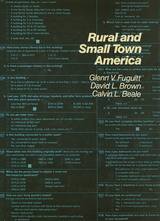 Rural and Small Town America
Glenn V. Fuguitt
Russell Sage Foundation, 1989 Important differences persist between rural and urban America, despite profound economic changes and the notorious homogenizing influence of the media. As Glenn V. Fuguitt, David L. Brown, and Calvin L. Beale show in Rural and Small Town America, the much-heralded disappearance of small town life has not come to pass, and the nonmetropolitan population still constitutes a significant dimension of our nation's social structure. Based on census and other recent survey data, this impressive study provides a detailed and comparative picture of rural America. The authors find that size of place is a critical demographic factor, affecting population composition (rural populations are older and more predominantly male than urban populations), the distribution of poverty (urban poverty tends to be concentrated in neighborhoods; rural poverty may extend over large blocks of counties), and employment opportunities (job quality and income are lower in rural areas, though rural occupational patterns are converging with those of urban areas). In general, rural and small town America still lags behind urban America on many indicators of social well-being. Pointing out that rural life is no longer synonymous with farming, the authors explore variations among nonmetropolitan populations. They also trace the impact of major national trends—the nonmetropolitan growth spurt of the 1970s and its current reversal, for example, or changing fertility rates—on rural life and on the relationship between metropolitan and nonmetropolitan communities. By describing the special characteristics and needs of rural populations as well as the features they share with urban America, this book clearly demonstrates that a more accurate picture of nonmetropolitan life is essential to understanding the larger dynamics of our society. A Volume in the Russell Sage Foundation Census Series
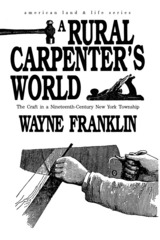 A Rural Carpenters World: The Craft in a Nineteenth-Century New York Township
Wayne Franklin
University of Iowa Press, 1990 Sometime late in 1868, New York farmer and carpenter James C. Holmes bought a new pocket diary for 1869. Now, over a hundred years later, this rare document of craft activity becomes the center for an intensive study of rural carpentry in Holmes' place and time that unlocks an entire realm of significances. Holmes' day-by-day record places his actual craft, not just its visible artifacts, in the context of nineteenth-century culture, society, and economics. Wayne Franklin's impeccable, wide-ranging research reconstructs Holmes' networks at a time when the coming industrialization of the building trades had yet to have much effect outside American cities. His meticulous identification of more than one hundred individuals referred to in the diary and his group biography of over sixty carpenters who practiced in the area until 1900 create portraits of real lives, demonstrating the complexities of the social landscape after the Civil War. A Rural Carpenter's World makes carpentry a prism through which James Holmes and his work and his world shine. This graceful, living record has immediate and lasting value for social historians, students of vernacular architecture and the built environment, and all those interested in westward migration and rural America.
 Rural County, Urban Borough: A History of Queens
Jeffrey A. Kroessler
Rutgers University Press, 2025 Once wetlands, Queens today is a crowded cityscape of dense urban neighborhoods and suburban sprawl. The largest of New York City’s five boroughs by area, it has a larger population than every American city except Chicago, Los Angeles, and New York City itself. It possesses the most culturally, ethnically, linguistically, and religiously diverse population in the United States and possibly the world. This is the story of Queens, “the world’s borough,” and how it transformed, in less than one hundred years, from an agricultural hinterland to a vital urban corridor.
Rural County, Urban Borough is a history of place, charting the rapid transformation of the Queens landscape. It identifies what drove the borough’s development, from public infrastructure, architecture, and transportation to technological innovation and urban planning. New York historian Jeffrey A. Kroessler takes us inside the backrooms and boardrooms where local powerbrokers shaped the borough’s future, chronicling how its relationship with the city has evolved. He also shows the steps Queens residents from all backgrounds took to care for their neighborhoods and build their communities. Richly illustrated, this book underscores why Queens is integral to New York City and the wider world and reveals how, in its evolution, we see the whole arc of American urban history.
 Rural Cuba
Lowry Nelson
University of Minnesota Press, 1950
Rural Cuba was first published in 1950. Minnesota Archive Editions uses digital technology to make long-unavailable books once again accessible, and are published unaltered from the original University of Minnesota Press editions.
Impoverished people in a rich land—that is the paradox of Cuba described with thorough documentation by Lowry Nelson, passed professor of sociology at the University of Minnesota. Professor Nelson studied rural Cuba's problems for a year during his appointment as rural sociologist for the U.S. Department of State.
With the cooperation of the Cuban government, Professor Nelson directed a series of detailed sociological surveys of representative rural districts. Data were gathered in these surveys on the family habits, agricultural methods, farm tenure, income, educational opportunities, social activities, and level of living of more than 700 rural Cuban families. This material is combined with historical background, census analyses, and on-the-spot observations for a comprehensive study that fills a gap in the available literature on the subject. The volume includes appendixes providing a description of the geography of the survey area and a verbatim sample report of a survey interviewer, together with a glossary of Spanish words, a bibliography, and tables.
In this book rural Cuba's problems are thoroughly discussed, present-day progress toward their solution is reported, and suggestions are offered for future agricultural policies that could help enrich the lives of Cuba's people.
Rural Development
Sung Hwan Ban, Pal Yong Moon, and Dwight H. Perkins
Harvard University Press, 1980
 Rural Development in China: Prospect and Retrospect
Hsiao-tung Fei
University of Chicago Press, 1989 This collection of essays written from 1947-1986 by Fei Hsiao-tung, China's most distinguished sociologist and anthropologist, presents a rich and representative sampling of the research that has characterized his long career. In 1936, Fei conducted field work in Kaixian'gong, a village in Jiangsu province in east China. This village became the subject of his now classic study Peasant Life in China, in which he argued that, because of China's huge population and the scarcity of cultivable land, household industries such as production of raw silk were vital to the peasants' economic survival. His conclusions, long rejected by China's policymakers, have recently been embraced by the government under the political leadership of Deng Xiaopeng.
Returning to Kaixian'gong in 1957 and again in the 1980s, Fei examined the changes that had occurred since his initial research. Three essays that resulted from these follow-up studies are included in this collection, providing a rare summary and analysis of developments in the village between 1936 and 1986. Also included here are four articles based on Fei's 1983-84 research in other areas of Jiangsu province. His explorations of the contrast between the wealth of southern Jiangsu and the long-standing poverty of the northern half of the province address key issues of public policy in China today. Useful to students of rural sociology as well as of Chinese history, politics, economics, and anthropology, this collection will provide an overview not only of developments in the small towns of China but also of Fei's thought.
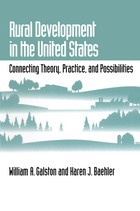 Rural Development in the United States: Connecting Theory, Practice, and Possibilities
William A. Galston and Karen J. Baehler
Island Press, 1995 Rural Development in the United States presents a comprehensive evaluation of the economic, environmental, and political implications of past rural development and a thorough consideration of the directions in which future development efforts should go. The authors have assembled the best of what is being thought and done with regard to rural development in the United States, and place it in a broad theoretical, historical, and geographical context. The book provides: - a summary of the key findings in rural development research of the past twenty years
- an integration of development theory and practical experience
- a bridge between the related but often isolated disciplines that inform rural development
- a catalyst for new thinking in the area of rural development
- analysis of the key economic sectors in rural areas: natural resources, the service sector, elderly services, telecommunications, manufacturing, tourism, and high-technology
It includes important information about how national and international trends affect rural communities and development strategies and will help guide rural economic development policy in the United States during the 1990s and beyond.
Rural Economy in the Early Iron Age: Excavations at Hascherkeller, 1978–1981
Peter S. Wells
Harvard University Press, 1983 This volume presents data and analysis on settlement structure, subsistence patterns, manufacturing, and trade from the Peabody Museum’s four seasons of excavation at Hascherkeller, Bavaria, a typical Central European agricultural community, at the start of the final millennium BC.
Rural Environmental Planning for Sustainable Communities
Frederic O. Sargent, Paul Lusk, Jose Rivera, and Maria Varela
Island Press, 1991 Rural Environmental Planning for Sustainable Communities offers an explanation of the concept of Rural Environmental Planning (REP) along with case studies that show how to apply REP to specific issues such as preserving agricultural lands, planning river and lake basins, and preserving historical sites.
The Rural Face of White Supremacy: BEYOND JIM CROW
Mark Schultz
University of Illinois Press, 2007 Now in paperback, The Rural Face of White Supremacy presents a detailed study of the daily experiences of ordinary people in rural Hancock County, Georgia. Drawing on his own interviews with over two hundred black and white residents, Mark Schultz argues that the residents acted on the basis of personal rather than institutional relationships. As a result, Hancock County residents experienced more intimate face-to-face interactions, which made possible more black agency than their urban counterparts were allowed. While they were still firmly entrenched within an exploitive white supremacist culture, this relative freedom did create a space for a range of interracial relationships that included mixed housing, midwifery, church services, meals, and even common-law marriages.
 The Rural Housing Question: Community and Planning in Britain's Countrysides
Madhu Satsangi, Nick Gallent, and Mark Bevan
Bristol University Press, 2010 For the past century, governments have been compelled, time and again, to return to the search for solutions to the housing and economic challenges posed by a restructuring countryside. The rural housing question is an analysis of the complexity of housing and development tensions in the rural areas of England, Wales and Scotland. It analyses a range of topics: from attitudes to rural development, economic change, land use, planning and counter-urbanisation; through retirement and ageing, leisure consumption, lifestyle shifts and homelessness; to public and private house building, private and public renting and community initiatives. Across this spectrum of concerns, it attempts to isolate the fundamental tensions that give the rural housing question an intractable quality. The book is aimed at policy makers, researchers, students and anyone with an interest in the future of the British countryside.
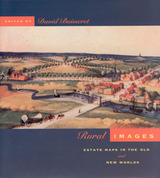 Rural Images: Estate Maps in the Old and New Worlds
Edited by David Buisseret
University of Chicago Press, 1996 Just when private property materialized as an important social institution, a new kind of map appeared—the estate map. Prepared for private owners rather than national powers, these maps have been a little-studied strain of cadastral mapping until now. Here a group of leading historians—Sarah Bendall, David Buisseret, P. D. A. Harvey, and B. W. Higman—follow the spread of estate maps from their origin in England around 1570 to colonial America, the British Caribbean, and early modern Europe.
Generously illustrated with reproductions of rare manuscripts, including 8 color plates, these accounts reveal how estate maps performed vital economic and cultural functions for property owners until the end of the nineteenth century. From plans of plantations in Jamaica and South Carolina to a map of Queens College, Cambridge, handsome examples show that estate maps formed an important part of the historical record of property ownership for both individuals and corporations, and helped owners manage their land and appraise its value. Exhibited in public places for pleasure and as symbols of wealth, they often displayed elaborate cartouches and elegant coats-of-arms.
 Rural Industrialization in China
John Sigurdson
Harvard University Press, 1977 Small-scale industries in rural areas in China are today an essential element of regional development programs. This monograph analyzes two main development strategies. One involves technology choices in a number of industrial sectors, most of which were initiated during the Great Leap Forward in the late fifties. The scaling down of modern large-scale technology through a product or quality choice, combined with changes in the manufacturing processes, is discussed at some length for nitrogen chemical fertilizer and cement.
The other approach is the integrated rural development strategy where a number of activities are integrated within or closely related to the commune system. This strategy includes industry as only one component of many instruments where improved public health, education, and improved agricultural technology contribute to achieving such policy objectives as increased employment and productivity.
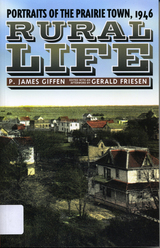 Rural Life: Portraits of the Prairie Town, 1946
James P. Giffen
University of Manitoba Press, 2004 In the 1940s, the Manitoba Royal Commission on Adult Education investigated directions for the modernization of the province in the post-war era of change. It was charged particularly with looking at rural Manitoba’s cultural, educational, and leadership opportunities in the wake of new technologies, dwindling populations, and altered political and social affiliations. The commission engaged Jim Giffen, then a young sociologist from the University of Toronto, to undertake a detailed field study of three rural Manitoba towns in this context.Giffen’s extensive study examined the towns of Carman, Elgin, and Rossburn, all significantly different in terms of their ethnic makeup and level of political and organizational sophistication. He remained in the province for a year and a half, at the end of which his report, an analysis of “education for leadership,” was considered “too revealing” for public release. It remained in the Ontario Legislative Library until it was retrieved, 50 years later, by well-known historian Gerald Friesen, who has written an extensive postscript to the report.As a snapshot of rural agricultural life in prairie Canada at a time of great change, the study is invaluable. Despite the differences in the three towns, they retain some common characteristics that define a particular socio-cultural view of the larger world. Giffen looks at characteristics such as leadership in the community, ethnic differences, hierarchy of roles, participation in organizations, and aims and activities of young people. Friesen’s postscript provides a wider context to this study, and an assessment of what these differences and commonalities meant to the province.
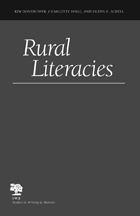 Rural Literacies
Kim Donehower, Charlotte Hogg, and Eileen Schell
Southern Illinois University Press, 2006 Rural Literacies identifies the problems inherent in trying to understand rural literacy, addresses the lack of substantive research on literacy in rural areas, and reviews traditional misrepresentations of rural literacy.
This innovative volume frames debates over literacy in relation to larger social, political, and economic forces, such as the impact of the No Child Left Behind Act on rural schools and the effects of out-migration, globalization, and the loss of small family farms on rural communities.
Drawing upon traditional literacy and composition research and employing theory from education and sociology, the text engages compositionists in broader conversations regarding rural literacies. The authors share strategies that will help compositionists participate in pedagogies that are rooted in a richer understanding of rural literacies and work toward sustainability for all communities in a globalized age.
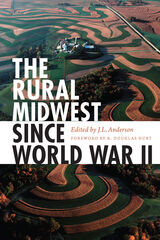 The Rural Midwest Since World War II
J. L. Anderson
Northern Illinois University Press, 2013 J.L. Anderson seeks to change the belief that the Midwest lacks the kind of geographic coherence, historical issues, and cultural touchstones that have informed regional identity in the American South, West, and Northeast. The goal of this illuminating volume is to demonstrate uniqueness in a region that has always been amorphous and is increasingly so. Midwesterners are a dynamic people who shaped the physical and social landscapes of the great midsection of the nation, and they are presented as such in this volume that offers a general yet informed overview of the region after World War II.
The contributors—most of whom are Midwesterners by birth or residence—seek to better understand a particular piece of rural America, a place too often caricatured, misunderstood, and ignored. However, the rural landscape has experienced agricultural diversity and major shifts in land use. Farmers in the region have successfully raised new commodities from dairy and cherries to mint and sugar beets. The region has also been a place where community leaders fought to improve their economic and social well-being, women redefined their roles on the farm, and minorities asserted their own version of the American Dream.
The rural Midwest is a regional melting pot, and contributors to this volume do not set out to sing its praises or, by contrast, assume the position of Midwestern modesty and self-deprecation. The essays herein rewrite the narrative of rural decline and crisis, and show through solid research and impeccable scholarship that rural Midwesterners have confronted and created challenges uniquely their own.
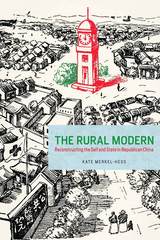 The Rural Modern: Reconstructing the Self and State in Republican China
Kate Merkel-Hess
University of Chicago Press, 2016 Discussions of China’s early twentieth-century modernization efforts tend to focus almost exclusively on cities, and the changes, both cultural and industrial, seen there. As a result, the communist peasant revolution appears as a decisive historical break. Kate Merkel-Hess corrects that misconception by demonstrating how crucial the countryside was for reformers in China long before the success of the communist revolution.
In The Rural Modern, Merkel-Hess shows that Chinese reformers and intellectuals created an idea of modernity that was not simply about what was foreign and new, as in Shanghai and other cities, but instead captured the Chinese people’s desire for social and political change rooted in rural traditions and institutions. She traces efforts to remake village education, economics, and politics, analyzing how these efforts contributed to a new, inclusive vision of rural Chinese life. Merkel-Hess argues that as China sought to redefine itself, such rural reform efforts played a major role, and tensions that emerged between rural and urban ways deeply informed social relations, government policies, and subsequent efforts to create a modern nation during the communist period.
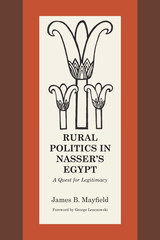 Rural Politics in Nasser's Egypt: A Quest for Legitimacy
By James B. Mayfield
University of Texas Press, 1971 On September 29, 1970, President Gamal Abdel Nasser died of a heart attack. The hysterical outpouring of grief at the state funeral dramatized the depth to which the loss of this charismatic leader shook the Arab world. Few men have achieved the love, prestige, and adulation that Nasser received from the Arab masses. Yet, in reality, Nasser’s political life was a tragic story. This book is a careful analysis of Nasser’s belated attempts to modernize the rural areas of Egypt. It documents the political, economic, and social factors that made Nasser’s dream for his people unattainable in his lifetime. Forced to choose between domestic needs and international challenges, Nasser’s attention was too often directed beyond the borders of Egypt. His vision of renewed Arab greatness, his dream of Arab unity, and his concern for Arab development often distorted his perception of his own country. While no one who personally conversed with Nasser doubted his sincere desire for a better life for the peasants of the Nile Valley, many noted his tendency to allocate resources more on the basis of dreams rather than the realities of Egypt’s domestic problems. Granted permission to move freely through Egypt’s twenty-five provinces prior to the 1967 travel restrictions, James B. Mayfield had a unique opportunity to personally observe Nasser’s dramatic attempts to bring progress and development to his people. The two decades of Nasser’s rule colored and shaped events in Egypt for many years after his death.
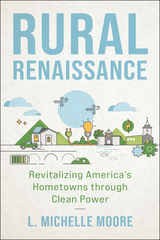 Rural Renaissance: Revitalizing America’s Hometowns through Clean Power
L. Michelle Moore
Island Press, 2022 For decades, we’ve heard that local, renewable power is on the horizon, and cheaper technologies will one day revolutionize our energy system. Michelle Moore has spent her career proving this opportunity is already here—and any community, no matter how small, can build their own clean energy future. Rural Renaissance: Revitalizing America’s Hometowns Through Clean Power is the inspiring and practical guide to igniting this transition today.
In Rural Renaissance, Moore argues we don’t have to wait for new legislation or technologies to begin our work. From the White House to her hometown in rural Georgia, Moore has gathered the tools needed to bring the far-reaching benefits of clean power to small communities, particularly in rural America. In this accessible guide, Moore provides an overview of the current energy landscape, including the federal, state, and local policies that will shape each community’s unique approach. Next, she describes five pathways to clean power in rural America and strategies for achieving them, including energy efficiency, renewable power, resilience (including microgrids and battery storage), the electrification of transportation, and finally, broadband internet. Throughout this journey, Moore shares stories of challenges and successes and encourages readers to design programs that address inequality.
Clean energy shouldn’t be reserved for the wealthy or for sleek and modern city centers. Rural Renaissance offers a vision of thriving rural communities where clean power is the spark that leads to greater investment, vitality, and equity. We can start today—and this book provides the toolbox.
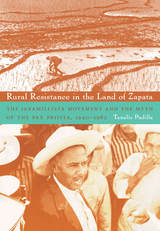 Rural Resistance in the Land of Zapata: The Jaramillista Movement and the Myth of the Pax-Priísta, 1940–1962
Tanalís Padilla
Duke University Press, 2008 In Rural Resistance in the Land of Zapata, Tanalís Padilla shows that the period from 1940 to 1968, generally viewed as a time of social and political stability in Mexico, actually saw numerous instances of popular discontent and widespread state repression. Padilla provides a detailed history of a mid-twentieth-century agrarian mobilization in the Mexican state of Morelos, the homeland of Emiliano Zapata. In so doing, she brings to the fore the continuities between the popular struggles surrounding the Mexican Revolution and contemporary rural uprisings such as the Zapatista rebellion. The peasants known in popular memory as Jaramillistas were led by Rubén Jaramillo (1900–1962). An agrarian leader from Morelos who participated in the Mexican Revolution and fought under Zapata, Jaramillo later became an outspoken defender of the rural poor. The Jaramillistas were inspired by the legacy of the Zapatistas, the peasant army that fought for land and community autonomy with particular tenacity during the Revolution. Padilla examines the way that the Jaramillistas used the legacy of Zapatismo but also transformed, expanded, and updated it in dialogue with other national and international political movements. The Jaramillistas fought persistently through legal channels for access to land, the means to work it, and sustainable prices for their products, but the Mexican government increasingly closed its doors to rural reform. The government ultimately responded with repression, pushing the Jaramillistas into armed struggle, and transforming their calls for local reform into a broader critique of capitalism. With Rural Resistance in the Land of Zapata, Padilla sheds new light on the decision to initiate armed struggle, women’s challenges to patriarchal norms, and the ways that campesinos framed their demands in relation to national and international political developments.
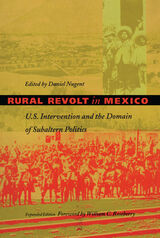 Rural Revolt in Mexico: U.S. Intervention and the Domain of Subaltern Politics
Daniel Nugent, ed.
Duke University Press, 1998 Rural Revolt in Mexico is a historical investigation of how subaltern political activity engages imperialism, capitalism, and the United States. In this volume, Daniel Nugent has gathered a group of leading scholars whose work examines the relationship of revolts by peasants and Indians in Mexico to the past century of U.S. intervention—from the rural rebellions of the 1840s through the 1910 revolution to the 1994 uprising in Chiapas.
Through their studies of social movements and popular mobilization in the Mexican countryside, the contributors argue for understanding rural revolts in terms of the specific historical contexts of particular regions and peoples, as well as the broader context of unequal cultural, political, and economic relations between Mexico and the United States. Exploring the connections between external and internal factors in social movements, these essays reveal the wide range of organized efforts through which peasants and Indians have struggled to shape their own destiny while confronted by the influence of U.S. capital and military might. Originally published as a limited edition in 1988 by the Center for U. S.–Mexican Studies, this volume presents a pioneering effort by Latin Americanist scholars to sympathetically embrace and enrich work begun in Subaltern Studies between 1982 and 1987 by projecting it onto a different region of historical experience. This revised and expanded edition includes a new introduction by Daniel Nugent and an extensive essay by Adolfo Gilly on the recent Chiapas uprising.
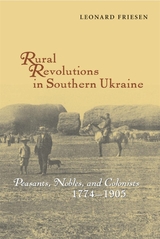 Rural Revolutions in Southern Ukraine: Peasants, Nobles, and Colonists, 1774–1905
Leonard Friesen
Harvard University Press, 2008 Leonard Friesen presents a study of the transformation of New Russia—the region north of the Black and Azov seas—from its conquest by the Russian Empire in the late eighteenth century to the revolutionary tumult of 1905. Friesen is particularly interested in the dynamic and multifaceted relations between the region’s peasants, European colonists, and Russian estate owners. He gives special attention to the settlement process whereby once free peasants were enserfed within a generation, as well as the period of servile emancipation after 1861, when the paths of the region’s agriculturalists converged in unexpected ways. Overall, Friesen sees the region as vital to an understanding of the empire as a whole. He demonstrates how peasants, nobles, and estate owners were key actors in a series of rural revolutions that eventually threatened the empire itself.
This book contributes to our understanding of Imperial Russia, as well as contemporary Ukraine, by describing and analyzing rural developmental patterns over time. It explores how, when, and why agriculturalists made adjustments to long-established agrarian and social practices, and provides a fresh perspective on the link between the end of empire and the rural developments that preceded it.
Rural Social Work: An International Perspective
Richard Pugh and Brian Cheers
Bristol University Press, 2010 In much of the West the concerns of rural people are marginalised and rural issues neglected. This stimulating book draws upon a rich variety of material to show why rural social work is such a challenging field of practice. It incorporates research from different disciplines and places to provide an accessible and comprehensive introduction to rural practice. The first part of the book focuses upon the experience of rurality. The second part of the book turns to the development of rural practice, reviewing different ways of working from casework through to community development. This book is relevant to planners, managers and practitioners not only in social work but also in other welfare services such as health and youth work, who are likely to face similar challenges.
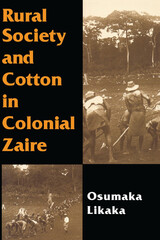 Rural Society and Cotton in Colonial Zaire
Osumaka Likaka
University of Wisconsin Press, 1997 This masterful social and economic history of rural Zaire examines the complex and lasting effects of forced cotton cultivation in central Africa from 1917 to 1960. Osumaka Likaka recreates daily life inside the colonial cotton regime. He shows that, to ensure widespread cotton production and to overcome continued peasant resistance, the colonial state and the cotton companies found it necessary to augment their use of threats and force with efforts to win the cooperation of the peasant farmers, through structural reforms, economic incentives, and propaganda exploiting African popular culture.
As local plots of food crops grown by individual households gave way to commercial fields of cotton, a whole host of social, economic, and environmental changes followed. Likaka reveals how food shortages and competition for labor were endemic, forests were cleared, social stratification increased, married women lost their traditional control of agricultural production, and communities became impoverished while local chiefs enlarged their power and prosperity.
Likaka documents how the cotton regime promoted its cause through agricultural exhibits, cotton festivals, films, and plays, as well as by raising producer prices and decreasing tax rates. He also shows how the peasant laborers in turn resisted regimented agricultural production by migrating, fleeing the farms for the bush, or sabotaging plantings by surreptitiously boiling cotton seeds. Small farmers who had received appallingly low prices from the cotton companies resisted by stealing back their cotton by night from the warehouses, to resell it in the morning. Likaka draws on interviews with more than fifty informants in Zaire and Belgium and reviews an impressive array of archival materials, from court records to comic books. In uncovering the tumultuous economic and social consequences of the cotton regime and by emphasizing its effects on social institutions, Likaka enriches historical understanding of African agriculture and development.
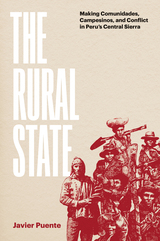 The Rural State: Making Comunidades, Campesinos, and Conflict in Peru's Central Sierra
Javier Puente
University of Texas Press, 2022 2023 Marysa Navarro Best Book Prize, New England Council of Latin American Studies (NECLAS)
A study of the intersection of rural populations, state formation, and the origins of political conflict in Peru.
On the eve of the twentieth century, Peru seemed like a profitable and yet fairly unexploited country. Both foreign capitalists and local state makers envisioned how remote highland areas were essential to a sustainable national economy. Mobilizing Andean populations lay at the core of this endeavor. In his groundbreaking book, The Rural State, Javier Puente uncovers the surprising and overlooked ways that Peru’s rural communities formed the political nation-state that still exists today. Puente documents how people living in the Peruvian central sierra in the twentieth century confronted emerging and consolidating powers of state and capital and engaged in an ongoing struggle over increasingly elusive subsistence and autonomies. Over the years, policy, politics, and social turmoil shaped the rural, mountainous regions of Peru until violent unrest, perpetrated by the Shining Path and other revolutionary groups, unveiled the extent, limits, and fractures of a century-long process of rural state formation. Examining the conflicts between one rural community and the many iterations of statehood in the central sierra of Peru, The Rural State offers a fresh perspective on how the Andes became la sierra, how pueblos became comunidades, and how indígenas became campesinos.
 Rural Unrest during the First Russian Revolution: Kursk Province, 1905-1906
Burton Richard Miller
Central European University Press, 2013 The narrative of peasant unrest in Russia during 1905–1906 combines a chronology of incidents drawn from official documents, with close analysis of the villages associated with the disorders based upon detailed census materials compiled by local specialists. The analysis concentrates on a single province: Kursk Oblast, bordering the now independent Ukraine. In place of the general surveys of the revolution that dominate the literature, Miller focuses on local events and the rural populations that participated in them. Documents the degree to which the peasant community had been pushed onto the path of change by the end of the nineteenth century, how much the “peasantry” itself had become increasingly heterogeneous in outlook and occupation, and the rapidity with which these processes had begun to corrode the legitimacy of the older order. Miller concludes that unrest was concentrated mostly among peasant communities for whom the benefits the vital interactions between social unequals that had maintained a fragile social peace in the countryside had been radically eroded; he furthermore identifies the prominent role played by that spectrum of persons that retained their ties to their villages, but stood toward the margins of rural life.
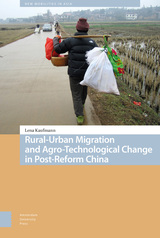 Rural-Urban Migration and Agro-Technological Change in Post-Reform China
Lena Kaufmann
Amsterdam University Press, 2021 How do rural Chinese households deal with the conflicting pressures of migrating into cities to work as well as staying at home to preserve their fields? This is particularly challenging for rice farmers, because paddy fields have to be cultivated continuously to retain their soil quality and value. Drawing on ethnographic fieldwork and written sources, Rural-Urban Migration and Agro-Technological Change in Post-Reform China describes farming households' strategic solutions to this predicament. It shows how, in light of rural-urban migration and agro-technological change, they manage to sustain both migration and farming. It innovatively conceives rural households as part of a larger farming community of practice that spans both staying and migrating household members and their material world. Focusing on one exemplary resource - paddy fields - it argues that socio-technical resources are key factors in understanding migration flows and migrant-home relations. Overall, this book provides rare insights into the rural side of migration and farmers' knowledge and agency.
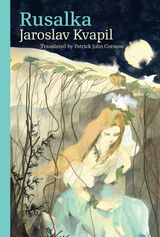 Rusalka: A Lyrical Fairy-tale in Three Acts
Jaroslav Kvapil
Karolinum Press, 2020 Famous as the libretto for Antonín Dvorák’s opera of the same name, Jaroslav Kvapil’s poem Rusalka is an intriguing work of literature on its own. Directly inspired by Hans Christian Andersen’s famous “The Little Mermaid,” Kvapil’s reinterpretation adds an array of nuanced poetic techniques, a more dramatic tempo, and dark undertones that echo the work of eminent Czech folklorist Karel Jaromír Erben. All of these influences work in tandem to create a poetic work that is familiar yet innovative.
Transposed into the folkloric topos of a landlocked Bohemia, the mermaid is rendered here as a Slavic rusalka—a dangerous water nymph—who must choose between love and immortality. Thus, Rusalka, while certainly paying homage to the original story’s Scandinavian roots, is still a distinct work of modern Czech literature. Newly translated by Patrick Corness, Kvapil’s work will now find a fresh group of readers looking to get lost in one of Europe’s great lyrical fairy tale traditions.
 Ruse and Wit: The Humorous in Arabic, Persian, and Turkish Narrative
Dominic Parviz Brookshaw
Harvard University Press, 2012 The essays in Ruse and Wit examine in detail a wide range of texts (from nonsensical prose, to ribald poetry, titillating anecdotes, edifying plays, and journalistic satire) that span the best part of a millennium of humorous and satirical writing in the Islamic world, from classical Arabic to medieval and modern Persian, and Ottoman Turkish (and by extension Modern Greek). While acknowledging significant elements of continuity in the humorous across distinct languages, divergent time periods, and disparate geographical regions, the authors have not shied away from the particular and the specific. When viewed collectively, the findings presented in the essays collected here underscore the belief that humor as evidenced in Arabic, Persian, and Turkish narrative is a culturally modulated phenomenon, one that demands to be examined with reference to its historical framework and one that, in turn, communicates as much about those who produced humor as it does about those who enjoyed it.
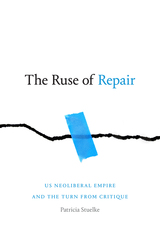 The Ruse of Repair: US Neoliberal Empire and the Turn from Critique
Patricia Stuelke
Duke University Press, 2021 Since the 1990s, literary and queer studies scholars have eschewed Marxist and Foucauldian critique and hailed the reparative mode of criticism as a more humane and humble way of approaching literature and culture. The reparative turn has traveled far beyond the academy, influencing how people imagine justice, solidarity, and social change. In The Ruse of Repair, Patricia Stuelke locates the reparative turn's hidden history in the failed struggle against US empire and neoliberal capitalism in the 1970s and 1980s. She shows how feminist, antiracist, and anti-imperialist liberation movements' visions of connection across difference, practices of self care, and other reparative modes of artistic and cultural production have unintentionally reinforced forms of neoliberal governance. At the same time, the US government and military, universities, and other institutions have appropriated and depoliticized these same techniques to sidestep addressing structural racism and imperialism in more substantive ways. In tracing the reparative turn's complicated and fraught genealogy, Stuelke questions reparative criticism's efficacy in ways that will prompt critics to reevaluate their own reading practices.
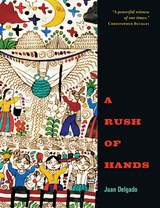 A Rush of Hands
Juan Delgado
University of Arizona Press, 2003 The whispers of buried lives. The silence of a growing resistance. The stigma of poverty. In haunting images, Juan Delgado explores the boundaries we cross daily. These poems deal honestly with the realities of urban life, whether dramatizing the effects of drive-by shootings, unfolding a labor protest that "spreads across the city like a prayer," or summoning a ghostlike immigrant damned to retrace his journey across the border. Daily and historical struggles are elevated to the level of myth. Yet, amid these poems there are images of life and love: a girl leaving hickeys rich as chocolate, a boy pledging to rescue his mother from poverty, a man studying the desert ground for tracks signaling immigrants in distress. Delgado is unflinching in showing us the harshness surrounding the lives he cherishes, and with resonant details and lyrical language he urges us to examine those lives-and ultimately our own. A Rush of Hands is a spellbinding book that will captivate both the ear and the heart.
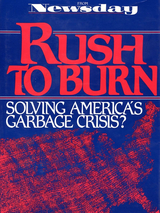 Rush to Burn: Solving America'S Garbage Crisis?
; Newsday Inc.
Island Press, 1989 One day in March 1987, a barge from Islip, Long Island was evicted from Morehead City, North Carolina, after trying to unload the mountains of trash on its decks. More than five months from the time it began its trip, the unwelcome barge, and it's 3,186 tons of commercial garbage, became the cornerstone of an astonishing news investigation that revealed a country unable to cope with its mounting garbage crisis. Newsday reporters were the first to locate the barge, the Mobro 4000 as it drifted aimlessly off the shore of Long Island. They were also first to explore and explain the problems and issues that barge had come to symbolize. The results of their investigation are presented in this book. Winner of the Worth Bingham Award, the Page One Award for Crusading Journalism, and the New York State Associated Press Award for In-Depth Reporting, Rush to Burn explains the reasons why we, as a throw-away society, are suffocating in our own trash. It also explains why communities, in desperation, are turning to incineration, the riskiest form of garbage disposal yet developed.
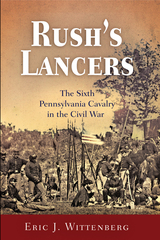 Rush's Lancers: The Sixth Pennsylvania Cavalry in the Civil War
Eric J. Wittenberg
Westholme Publishing, 2007 The Complete Story of a Legendary Civil War Unit
The Sixth Pennsylvania Cavalry, also known as Rush’s Lancers, was a completely volunteer unit and one of the finest regiments to serve in the Civil War. Tracing their history from George Washington’s personal bodyguard during the Revolutionary War, many of the men of the Sixth Pennsylvania were the cream of Philadelphia society, including Richard H. Rush, grandson of Dr. Benjamin Rush, Maj. Robert Morris, Jr., great-grandson of the financier of the Revolutionary War, Capt. Charles Cadwalader, whose great-grandfather was a general under George Washington, Frank H. Furness, architect and Medal of Honor recipient, and George G. Meade, Jr. But it was their actions in battle, not their illustrious family histories, that distinguished Rush’s Lancers. The Sixth Pennsylvania Cavalry earned a reputation for being a highly trained and reliable unit, despite being armed initially with antiquated weapons, leaving their mark on key battlefields, including Antietam, Fredericksburg, Hanover Court House, Chancellorsville, Gettysburg, Brandy Station—where they conducted one of the most famous charges of the war—and Appomattox.
Drawing upon letters, diaries, memoirs, service and pension files, contemporary newspaper coverage, official records, and other primary sources, Rush’s Lancers: The Sixth Pennsylvania Cavalry in the Civil War by distinguished military historian Eric J. Wittenberg is an engrossing account of these young men from both Philadelphia’s social elite and the city’s working classes who, despite not being professional soldiers, answered the Nation’s call to war.
 Ruskin and the Art of the Beholder
Elizabeth K. Helsinger
Harvard University Press, 1982 "This book seems to give me eyes," wrote Charlotte Brontë of Ruskin's Modern Painters. Elizabeth Helsinger here explores theprofound changes Ruskin induced in theway nineteenth-century viewers looked atnature and at art.
Helsinger argues that Ruskin transformedthe artist- or poet-oriented aesthetics ofromanticism into a beholder- or reader-oriented criticism. Combining critical attention to Ruskin's prose with her ownwide-ranging scholarship, Helsinger placesRuskin's perceptual reforms within previously unexplored intellectual and culturalcontexts. She connects his thought withWordsworth's poetry, Turner's landscapeart, and Carlyle's history, and shows theeffect on his ideas of romantic literary andart criticism, associationist psychology, historicism, contemporary travel art andliterature, and Victorian philology.
This illuminating study of Ruskin's criticism should be welcomed by students ofnineteenth-century intellectual, literary,and art history.
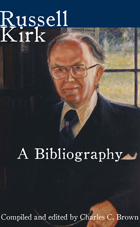 Russell Kirk: A Bibliography
Charles C. Brown
Intercollegiate Studies Institute, 2011
An invaluable reference work on one of the
twentieth century’s foremost men of letters
In the four decades after Russell Kirk published the landmark work The Conservative Mind (1953), the social philosopher, critic, and historian of ideas produced an incredible abundance of writings—books, essays, articles, columns, reviews, and fiction—and lectured all over the world. This volume provides a complete accounting of Kirk’s oeuvre, capturing the breadth and depth of his achievement.
Russell Kirk: A Bibliography lists all of his published works, including the many translations of his books and shorter writings. Editor Charles C. Brown has also gathered numerous writings about Kirk that have appeared over the years, both during his lifetime and since. The book concludes with a brief chronology of Kirk’s life and work.
This bibliography is a must for every aficionado of Russell Kirk and the intellectual and political movement he shaped.
|
|


